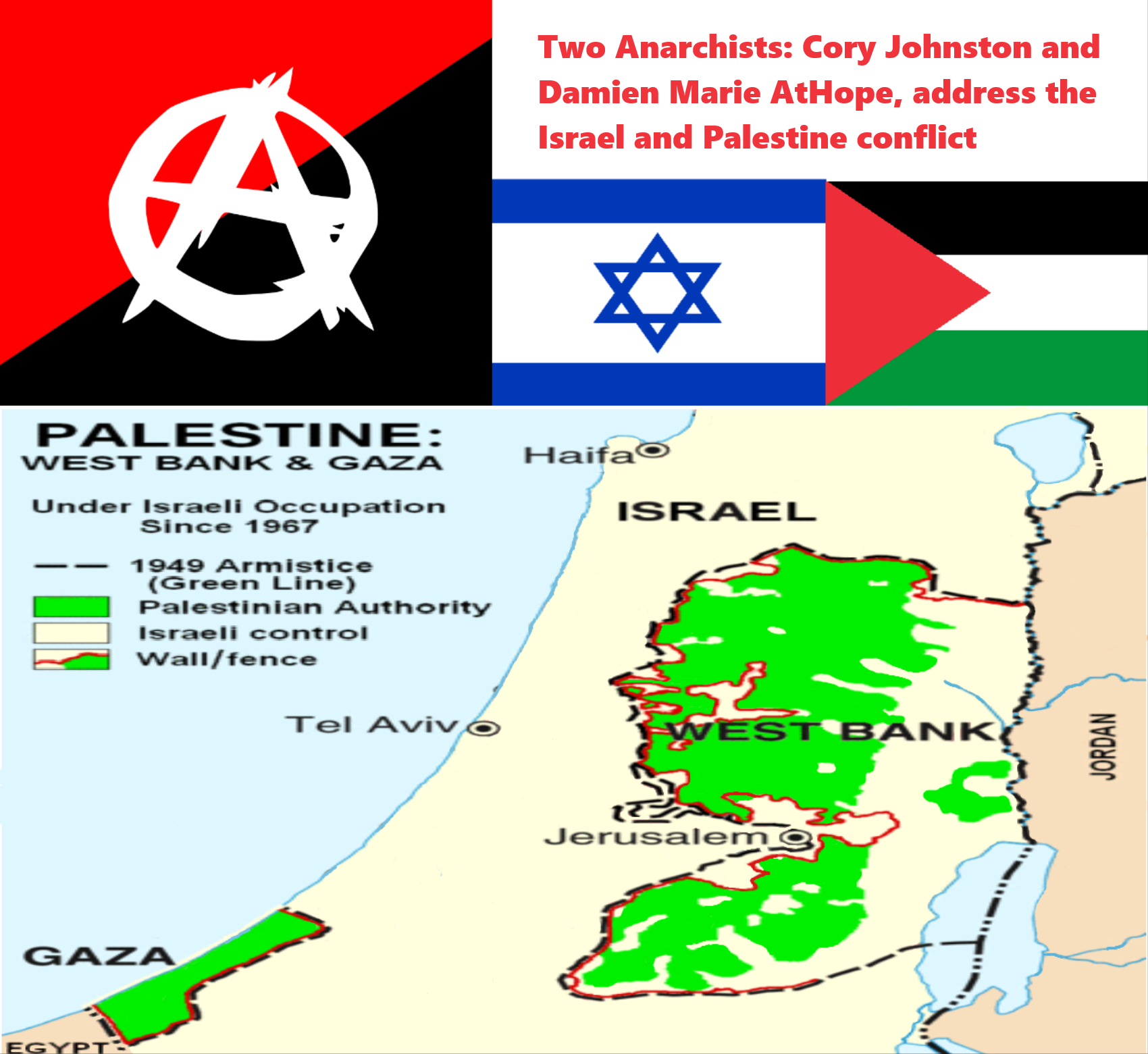
What we don’t understand, we can come to fear. That which we fear, we often learn to hate. Things we hate, we usually seek to destroy. It is thus, upon us, to try and understand the unknown or unfamiliar, not letting fear drive us into the unreasonable arms of hate and harm.
“Israel is a country in Palestine that is bordered by Lebanon to the north, by Syria to the northeast, by Jordan to the east, by the Red Sea to the south, by Egypt to the southwest, by the Mediterranean Sea to the west, and by the Palestinian territories – the West Bank along the east and the Gaza Strip along the southwest. The area historically was called Canaan, which also involved the Land of Israel, Palestine, and the Holy Land.” https://en.wikipedia.org/wiki/Israel
“The Palestinian territories are the two regions of the former British Mandate for Palestine that have been militarily occupied by Israel since the Six-Day War of 1967, namely: the West Bank (including East Jerusalem) and the Gaza Strip. The International Court of Justice (ICJ) has referred to the West Bank, including East Jerusalem, as “the Occupied Palestinian Territory”, and this term was used as the legal definition by the ICJ in its advisory opinion of July 2004. The term occupied Palestinian territory was used by the United Nations and other international organizations between October 1999 and December 2012 to refer to areas controlled by the Palestinian National Authority, but from 2012, when Palestine was admitted as one of its non-member observer states, the United Nations started using exclusively the name State of Palestine. The European Union (EU) also adopts the term occupied Palestinian territory, with a parallel term Palestinian Authority territories also occasionally used. The government of Israel and its supporters use the label “disputed territories” instead.” https://en.wikipedia.org/wiki/Palestinian_territories
“The Gaza Strip and the West Bank had been occupied by Egypt and Jordan, respectively, since the 1948 Arab–Israeli War until the Six-Day War of 1967. Israel occupied the West Bank and the Gaza Strip in 1967 and has since maintained control. In 1980, Israel officially absorbed East Jerusalem and proclaimed the whole of the city to be its capital. The inclusion, though never formally amounting to legal annexation, was condemned internationally and declared “null and void” by the United Nations Security Council. The Palestinian National Authority, the United Nations, the international legal and humanitarian bodies, and the international community regard East Jerusalem as part of the West Bank, and consequently a part of the Palestinian territories. The Palestinian National Authority never exercised sovereignty over the area, although it housed its offices in Orient House and several other buildings as an assertion of its sovereign interests. Israeli sovereignty over East Jerusalem has not been recognized by the International community, on the grounds that the unilateral annexation of territory occupied during war contravenes the Fourth Geneva Convention.” https://en.wikipedia.org/wiki/Palestinian_territories
It is amazing that the USA can find war crimes done in Ukraine by Russians on an American but seems oblivious to war crimes it has done or that of allies like Israel. America’s justice has always been lacking in justice.
Support Freedom
I am glad some hostages are being freed. They all should be freed immediately and never should have been taken to begin with. We all deserve freedom, including the West Bank and Gasa from occupation, apartheid, and oppression.
Cultural Genocide
“Cultural genocide or culturicide, as the Armenian Genocide Museum defines it as “acts and measures undertaken to destroy nations’ or ethnic groups’ culture through spiritual, national, and cultural destruction.” ref
Some Palestinians seem to want a Cultural genocide to remove Israel as if Jews have no rights to the land culturally. Cultural genocide may be part of the Israel state’s not supporting a two-state solution and wanting all the land in Palestine thus removing Palestinians’ culture.
Anarchist Atheist
I am an anti-religionist, and I also don’t want any states. But as a secularist, I don’t force my anti-religion on others, though I wish for a world where religion is finally seen for the mythology it is. Being a secularist is an ethical way of honoring the rights of others who may think differently but respect each other. I am not for forced atheism. Rather I wish to inspire others to atheism. I offer thoughtful education on prehistory and religion with the goal of helping people see religion was and always will be just a product of culture, not more than, like languages, completely human-made. We are capable of great empathy as well as love and these are as great a force as our negative features or failures. Really is not one-sided and we have the power to change and choose better. I want to make a difference in the world and try to bring hope and new thinking to others where I can. I also wish to champion kindness as often as I champion challenges in thinking and hope for wisdom as much as reason or doubt. Humanity is a worthy cause, and we all benefit from its advancement. Don’t let ANGER become an unethical behavior.
Religion has been a reason for violence and harm and at times a promoter of peace. Science does not need to fill the gap of religion. We need to remove it as it was always an abstraction not a realistic thing to being with. Not one thing religion offers that is thought of as good cannot be done by persons not following any religion. Atheist generally is simply life with religion removed, all its pseudo meaning as well as pseudoscience, pseudohistory, and pseudo-morality. We have real science, and realistic history and can access real morality with a blend of philosophy, anthropology, psychology, sociology, and cognitive science.
To understand and utilize value or actually possess “Value Conscious/Consciousness” is important.
Because value-blindness gives rise to sociopathic/psychopathic evil.
Reject Antisemitism and Islamophobia hate.
I am anti-bigotry.
Condemn governments and terrorists when they do wrong,
don’t hate regular people, not related to either.
Hating people is wrong.
I am an anti-nationalist and anti-capitalist to my core. I stand in solidarity with humanity, not borders or nations, rather it is the humans from every single plot of dirt they happen to currently live on. We are all one. Don’t let imaginary borders tell you who to love or hate.
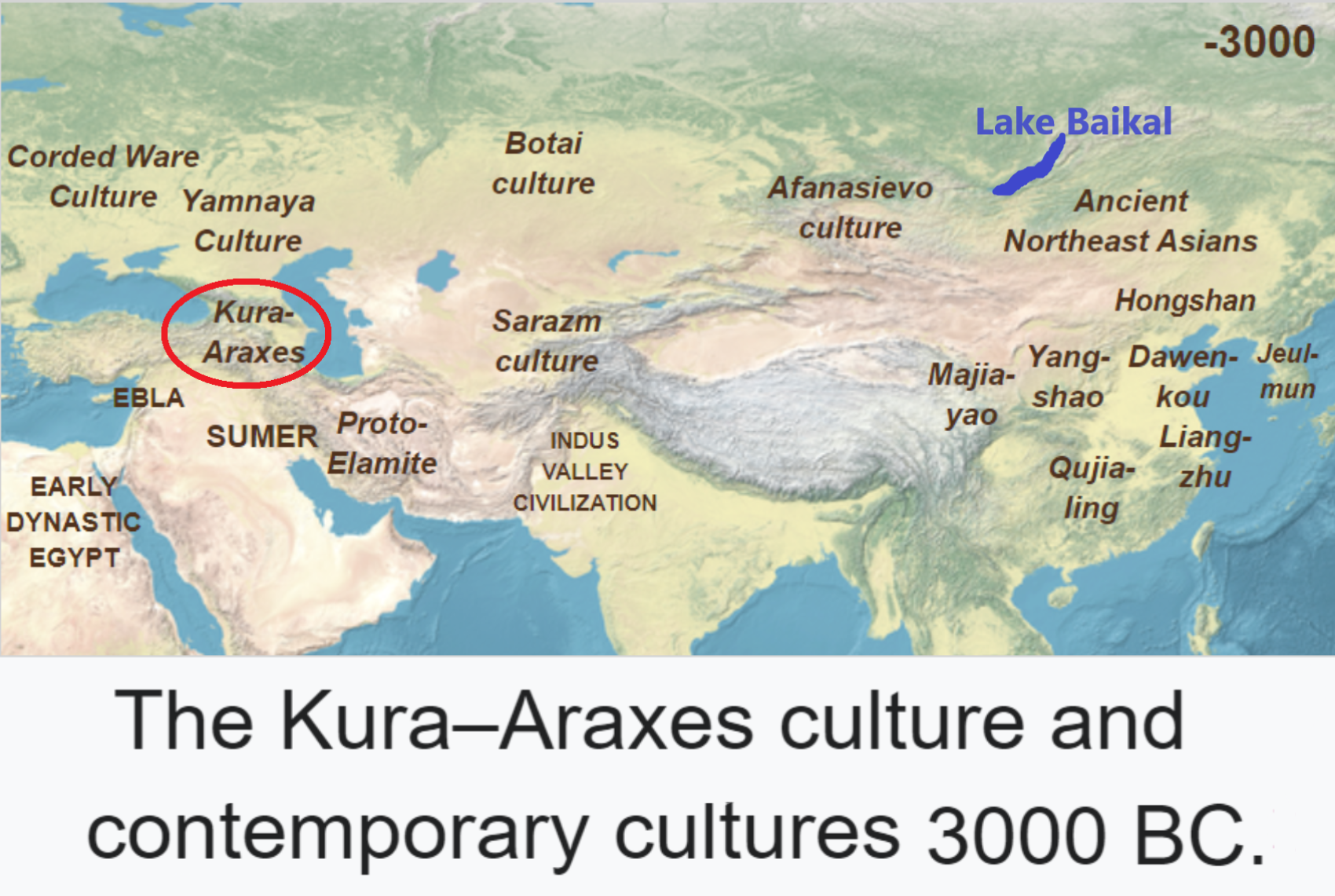
The Emergence of Migrations and Violence 7,000 to 5,000 years ago
“Wars and clan structure may explain a strange biological event 7,000 years ago, Stanford researchers find. Genetic data suggest there was a collapse in male, but not female, genetic diversity starting 7,000 years ago. The reason may be wars between clans structured around male ancestry.” ref
“Research finds a dramatic increase in cranial traumas as the first cities were being built, suggesting a rise in violence. The development of the earliest cities in Mesopotamia and the Middle East led to a substantial increase in violence between inhabitants. Interpersonal violence—i.e. of murder—peaked in the period of 4,500 to 3,300 BCE or 6,500 to 5,300 years ago. The researchers examined 3,539 skeletons from the region that today covers Iran, Iraq, Jordan, Syria, Lebanon, Israel and Turkey for bone trauma which could only have occurred through violence. This enabled them to draw a nuanced picture of the development of interpersonal violence in the period 12,000 to 400 BCE. The period was characterized by such fundamental changes in human history as the development of agriculture, leaving behind the nomadic lifestyle, and the building of the first cities and states. Another turning point was the collapse of many advanced civilizations in the Late Bronze Age. At this stage, around 1,200 BCE or around 3,200 years ago, there was also a climate catastrophe lasting 300 years, associated with migratory movements. This again led to an increase in the ratio of violent deaths.” ref
More information: Joerg Baten et al, Violence trends in the ancient Middle East between 12,000 and 400 bce, Nature Human Behaviour (2023). DOI: 10.1038/s41562-023-01700-y
Bioarchaeological data reveal cycles of violence in the ancient Middle East, Nature Human Behaviour (2023). DOI: 10.1038/s41562-023-01701-x , www.nature.com/articles/s41562-023-01701-x
“The Kura–Araxes culture (also named Kur–Araz culture, Mtkvari–Araxes culture, Early Transcaucasian culture) was an archaeological culture that existed from about 4000 to 2000 BCE, which has traditionally been regarded as the date of its end; in some locations it may have disappeared as early as 2600 or 2700 BCE. The earliest evidence for this culture is found on the Ararat plain; it spread north in the Caucasus by 3000 BCE. Its territory corresponds to large parts of modern Armenia, Azerbaijan, Chechnya, Dagestan, Georgia, Ingushetia, North Ossetia, and parts of Iran and Turkey. Rather quickly, elements of Kura–Araxes culture started to proceed westward to the Erzurum plain, southwest to Cilicia, and to the southeast into the area of Lake Van, and below the Urmia basin in Iran, such as to Godin Tepe. Finally, it proceeded into the present-day Syria (Amuq valley), and as far as Palestine.” ref

ref, ref, ref, ref, ref, ref, ref, ref, ref, ref, ref, ref
Bronze Age migrants, the Kura-Araxes cultural 5,520 to 4,470 years ago, their DNA from the Caucasus Mountains traces to the Canaanites and then lives on in modern Arabs and Jews. A Study found most Arab and Jewish groups in the region owe more than half of their DNA to Canaanites and other peoples of the ancient Near East—an area encompassing much of the modern Levant, Caucasus, Turkey, and Iran. Before the Kura-Araxes period of cultural traditions, horse bones were not found in Transcaucasia/South Caucasus a geographical region of the southern Caucasus Mountains on the border of Eastern Europe and Western Asia.
“DNA from the Bible’s Canaanites lives on in modern Arabs and Jews: A new study of ancient DNA traces the surprising heritage of these mysterious Bronze Age people. Tel Megiddo was an important Canaanite city-state during the Bronze Age, approximately 3500 to 1200 B.CE or 5,520 to 3,220 years ago. DNA analysis reveals that the city’s population included migrants from the distant Caucasus Mountains. They are best known as the people who lived “in a land flowing with milk and honey” until they were vanquished by the ancient Israelites and disappeared from history. But a scientific report published today reveals that the genetic heritage of the Canaanites survives in many modern-day Jews and Arabs. The study in Cell also shows that migrants from the distant Caucasus Mountains combined with the indigenous population to forge the unique Canaanite culture that dominated the area between Egypt and Mesopotamia during the Bronze Age. The team extracted ancient DNA from the bones of 73 individuals buried over the course of 1,500 years at five Canaanite sites scattered across Israel and Jordan. They also factored in data from an additional 20 individuals from four sites previously reported. “Individuals from all sites are highly genetically similar,” says co-author and molecular evolutionist Liran Carmel of Jerusalem’s Hebrew University.” ref
“So while the Canaanites lived in far-flung city-states, and never coalesced into an empire, they shared genes as well as a common culture. The researchers also compared the ancient DNA with that of modern populations and found that most Arab and Jewish groups in the region owe more than half of their DNA to Canaanites and other peoples who inhabited the ancient Near East—an area encompassing much of the modern Levant, Caucasus, and Iran. The study—a collaborative effort between Carmel’s lab, the ancient DNA lab at Harvard University headed by geneticist David Reich, and other groups—was by far the largest of its type in the region. Its findings are the latest in a series of recent breakthroughs in our understanding of this mysterious people who left behind few written records. Marc Haber, a geneticist at the Wellcome Trust’s Sanger Institute in Hinxton, United Kingdom, co-led a 2017 study of five Canaanite individuals from the coastal town of Sidon. The results showed that modern Lebanese can trace more than 90 percent of their genetic ancestry to Canaanites.” ref
“As Egyptians built pyramids and Mesopotamians constructed ziggurats some 4,500 years ago, the Canaanites began to develop towns and cities between these great powers. They first appear in the historical record around 1800 B.C., when the king of the city-state of Mari in today’s eastern Syria complained about “thieves and Canaanites.” Diplomatic correspondence written five centuries later mentions several Canaanite kings, who often struggled to maintain independence from Egypt. “The land of Canaan is your land and its kings are your servants,” acknowledged one Babylonian monarch in a letter to the Egyptian pharaoh Akhenaten. Biblical texts, written many centuries later, insist that Yahweh promised the land of Canaan to the Israelites after their escape from Egypt. Jewish scripture says the newcomers eventually triumphed, but archaeological evidence doesn’t show widespread destruction of Canaanite populations. Instead, they appear to have been gradually overpowered by later invaders such as the Philistines, Greeks, and Romans.” ref
“Red and black pottery circa 2500 BCE or around 4,520 years old was found in the Caucasus Mountains, as well as at Canaanite sites far to the southwest. The Canaanites spoke a Semitic language and were long thought to derive from earlier populations that settled in the region thousands of years before. But archaeologists have puzzled over red-and-black pottery discovered at Canaanite sites that closely resembles ceramics found in the Caucasus Mountains, some 750 miles to the northwest. Historians also have noted that many Canaanite names derive from Hurrian, a non-Semitic language originating in the Caucasus. Whether this resulted from long-distance trade or migration was uncertain. The new study demonstrates that significant numbers of people, and not just goods, were moving around during humanity’s first era of cities and empires. The genes of Canaanite individuals proved to be a mix of local Neolithic people and the Caucasus migrants, who began showing up in the region around the start of the Bronze Age. Carmel adds that the migration appears to have been more than a one-time event, and “could have involved multiple waves throughout the Bronze Age.” One brother and sister who lived around 1500 B.C. in Megiddo, in what is now northern Israel, were from a family that had migrated relatively recently from the northeast. The team also noted that individuals at two coastal sites—Ashkelon in Israel and Sidon in Lebanon—show slightly more genetic diversity. That may be the result of broader trade links in Mediterranean port towns than inland settlements.” ref
“Glenn Schwartz, an archaeologist at Johns Hopkins University who was not involved in the study, said that the biological data provides important insight into how Canaanites shared a notable number of genes as well as cultural traits. And Haber from the Wellcome Trust noted that the quantity of DNA results is particularly impressive, given the difficulty of extracting samples from old bones buried in such a warm climate that can quickly degrade genetic material. Both Israeli and Palestinian politicians claim the region of Israel and the Palestinian territories is the ancestral home of their people, and maintain that the other group was a late arrival. “We are the Canaanites,” asserted Palestinian Authority President Mahmoud Abbas last year. “This land is for its people…who were here 5,000 years ago.” Israeli Prime Minister Benjamin Netanyahu, meanwhile, said recently that the ancestors of modern Palestinians “came from the Arabian peninsula to the Land of Israel thousands of years” after the Israelites. The new study suggests that despite tumultuous changes in the area since the Bronze Age, “the present-day inhabitants of the region are, to a large extent, descended from its ancient residents,” concludes Schwartz—although Carmel adds that there are hints of later demographic shifts. Carmel hopes to soon expand the findings by collecting DNA from the remains of those who can be identified as Judean, Moabite, Ammonite, and other groups mentioned in the Bible and other texts. “One could analyze ‘Canaanite’ as opposed to ‘Israelite’ individuals,” adds archaeologist Mary Ellen Buck, who wrote a book on the Canaanites. “The Bible claims that these are distinct and mutually antagonistic groups, yet there’s reason to believe that they were very closely related.” ref
“As reported from genome-wide DNA data for 73 individuals from five archaeological sites across the Bronze and Iron Ages Southern Levant. These individuals, who share the “Canaanite” material culture, can be modeled as descending from two sources: (1) earlier local Neolithic populations and (2) populations related to the Chalcolithic Zagros or the Bronze Age Caucasus. The non-local contribution increased over time, as evinced by three outliers who can be modeled as descendants of recent migrants. We show evidence that different “Canaanite” groups genetically resemble each other more than other populations. We find that Levant-related modern populations typically have substantial ancestry coming from populations related to the Chalcolithic Zagros and the Bronze Age Southern Levant. These groups also harbor ancestry from sources we cannot fully model with the available data, highlighting the critical role of post-Bronze-Age migrations into the region over the past 3,000 years.” ref
“The Bronze Age (ca. 3500–1150 BCE) was a formative period in the Southern Levant, a region that includes present-day Israel, Jordan, Lebanon, the Palestinian Authority, and southwest Syria. This era, which ended in a large-scale civilization collapse across this region (Cline, 2014), shaped later periods both demographically and culturally. The following Iron Age (ca. 1150–586 BCE) saw the rise of territorial kingdoms such as biblical Israel, Judah, Ammon, Moab, and Aram-Damascus, as well as the Phoenician city-states. In much of the Late Bronze Age, the region was ruled by imperial Egypt, although in later phases of the Iron Age it was controlled by the Mesopotamian-centered empires of Assyria and Babylonia. Archaeological and historical research has documented major changes during the Bronze and Iron Ages, such as the cultural influence of the northern (Caucasian) populations related to the Kura-Araxes tradition during the Early Bronze Age (Greenberg and Goren, 2009) and effects from the “Sea Peoples” (such as Philistines) from the west in the beginning of the Iron Age (Yasur-Landau, 2010). The inhabitants of the Southern Levant in the Bronze Age are commonly described as “Canaanites,” that is, residents of the Land of Canaan. The term appears in several 2nd millennium BCE sources (e.g., Amarna, Alalakh, and Ugarit tablets) and in biblical texts dating from the 8th–7th centuries BCE and later (Bienkowski, 1999, Lemche, 1991, Na’aman, 1994a). In the latter, the Canaanites are referred to as the pre-Israelite inhabitants of the land (Na’aman, 1994a). Canaan of the 2nd millennium BCE was organized in a system of city-states (Goren et al., 2004), where elites ruled from urban hubs over rural (and in some places pastoral) countryside. The material culture of these city-states was relatively uniform (Mazar, 1992), but whether this uniformity extends to their genetic ancestry is unknown. Although genetic ancestry and material culture are unlikely to ever match perfectly, past ancient DNA analyses show that they might sometimes be strongly associated. In other cases, a direct correspondence between genetics and culture cannot be established. We discuss several examples in the Discussion. Previous ancient DNA studies published genome-scale data for thirteen individuals from four Bronze Age sites in the Southern Levant: three individuals from ‘Ain Ghazal in present-day Jordan, dated to ∼2300 BCE (Intermediate Bronze Age) (Lazaridis et al., 2016); five from Sidon in present-day Lebanon, dated to ∼1750 BCE (Middle Bronze Age) (Haber et al., 2017); two from Tel Shadud in present-day Israel, dated to ∼1250 BCE (Late Bronze Age) (van den Brink et al., 2017); and three from Ashkelon in present-day Israel, dated to ∼1650–1200 BCE (Middle and Late Bronze Age) (Feldman et al., 2019). The ancestry of these individuals could be modeled as a mixture of earlier local groups and groups related to the Chalcolithic people of the Zagros Mountains, located in present-day Iran and designated in previous studies as Iran_ChL (Haber et al., 2017, Lazaridis et al., 2016). The Bronze Age Sidon group could be modeled as a major (93% ± 2%) ancestral source for present-day groups in the region (Haber et al., 2017). A study of Chalcolithic individuals from Peqi’in cave in the Galilee (present-day Israel) showed that the ancestry of this earlier group included an additional component related to earlier Anatolian farmers, which was excluded as a substantial source for later Bronze Age groups from the Southern Levant, with the exception of the coastal groups from Sidon and Ashkelon (Feldman et al., 2019, Harney et al., 2018). These observations point to a degree of population turnover in the Chalcolithic-Bronze Age transition, consistent with archaeological evidence for a disruption between local Chalcolithic and Early Bronze cultures (de Miroschedji, 2014). Addressing three issues: First, we sought to determine the extent of genetic homogeneity among the sites associated with Canaanite material culture. Second, we analyzed the data to gain insights into the timing, extent, and origin of gene flow that brought Zagros- and Caucasus-related ancestry to the Bronze Age Southern Levant. Third, we assessed the extent to which additional gene flow events have affected the region since that time. To address these questions, we generated genome-wide ancient DNA data for 71 Bronze Age and 2 Iron Age individuals, spanning roughly 1,500 years, from the Intermediate Bronze Age to the Early Iron Age. Combined with previously published data on the Bronze and Iron Ages in the Southern Levant, we assembled a dataset of 93 individuals from 9 sites across present-day Israel, Jordan, and Lebanon, all demonstrating Canaanite material culture. We show that the sampled individuals from the different sites are usually genetically similar, albeit with subtle but in some cases significant differences, especially in residents of the coastal regions of Sidon and Ashkelon. Almost all individuals can be modeled as a mixture of local earlier Neolithic populations and populations from the northeastern part of the Near East. However, the mixture proportions change over time, revealing the demographic dynamics of the Southern Levant during the Bronze Age. Finally, we show that the genomes of present-day groups geographically and historically linked to the Bronze Age Levant, including the great majority of present-day Jewish groups and Levantine Arabic-speaking groups, are consistent with having 50% or more of their ancestry from people related to groups who lived in the Bronze Age Levant and the Chalcolithic Zagros. These present-day groups also show ancestries that cannot be modeled by the available ancient DNA data, highlighting the importance of additional major genetic effects on the region since the Bronze Age.” ref
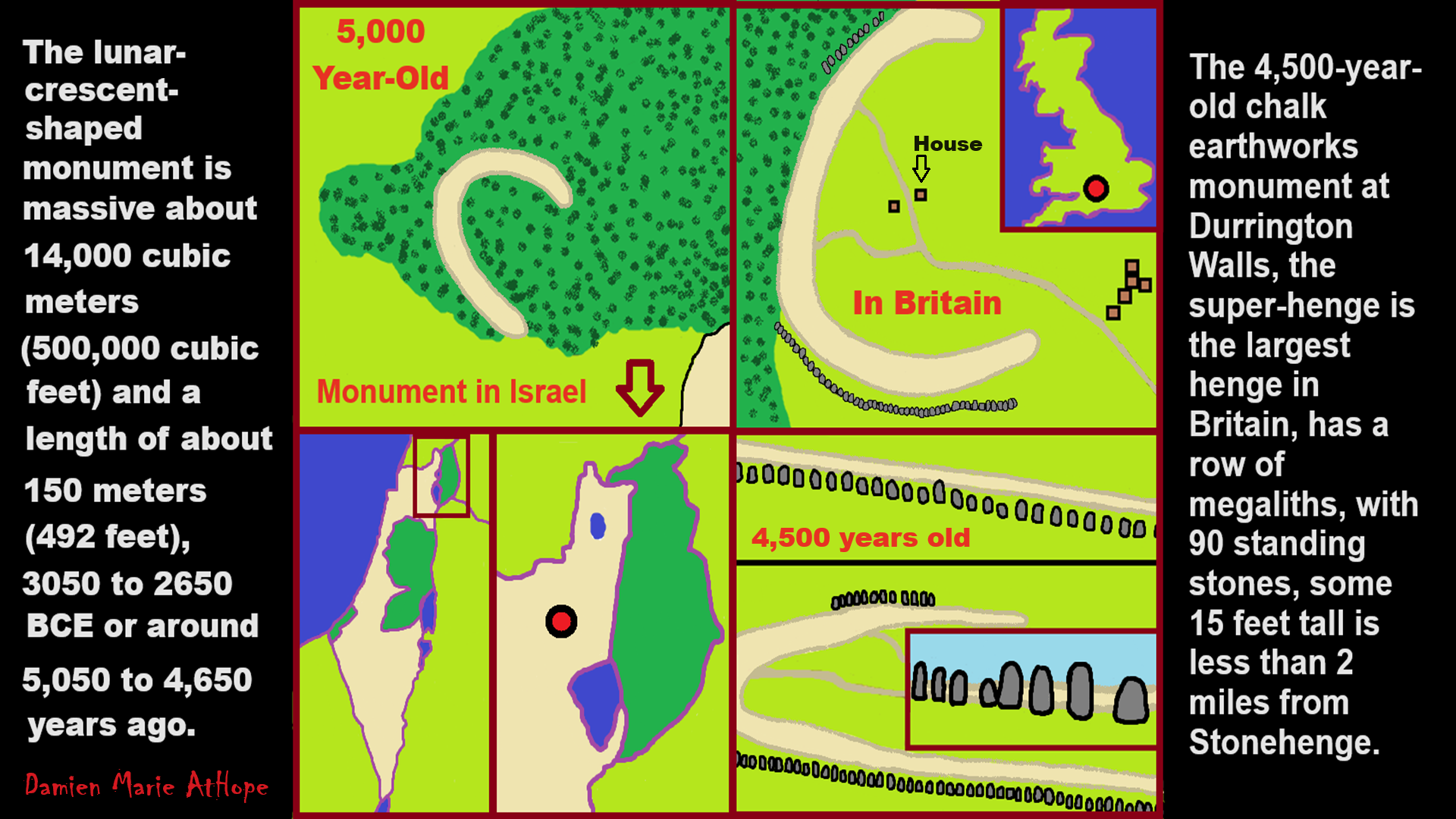
The lunar-crescent-shaped monument is massive at about 14,000 cubic meters (500,000 cubic feet) and has a length of about 150 meters (492 feet), 3050 to 2650 BCE, or around 5,050 to 4,650 years ago.
The 4,500-year-old chalk earthworks monument at Durrington Walls, the super-henge is the largest henge in Britain, has a row of megaliths, with 90 standing stones, some 15 feet tall, is less than 2 miles from Stonehenge.
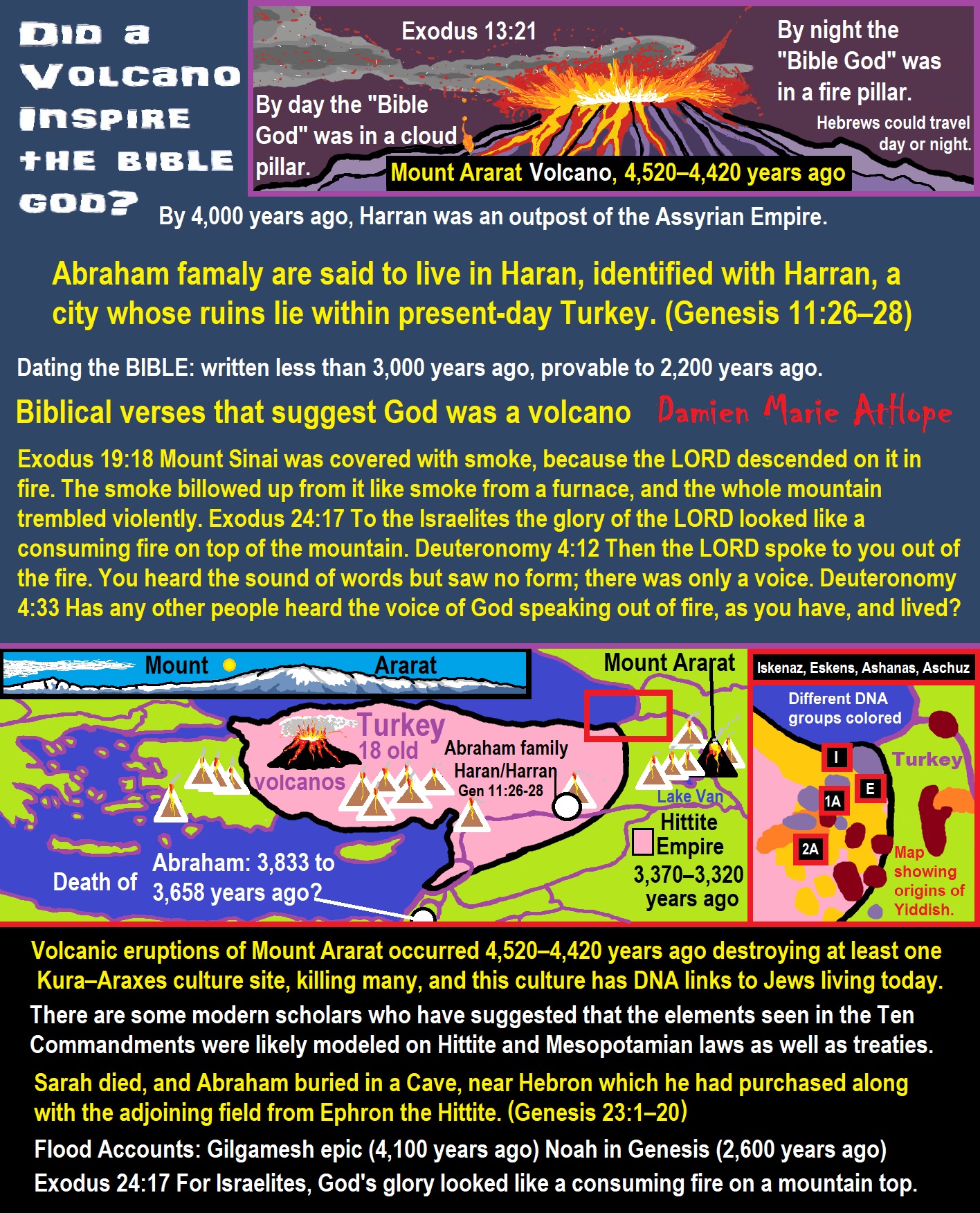
ref, ref, ref, ref, ref, ref, ref, ref, ref, ref, ref, ref, ref
By day the LORD went ahead of them in a pillar of cloud to guide them on their way and by night in a pillar of fire to give them light, so that they could travel by day or night.
- By day the “Bible God” was in a cloud pillar.
- By night the “Bible God” was in a fire pillar.
Did a 4,520–4,420-year-old Volcano In Turkey Inspire the Bible God?
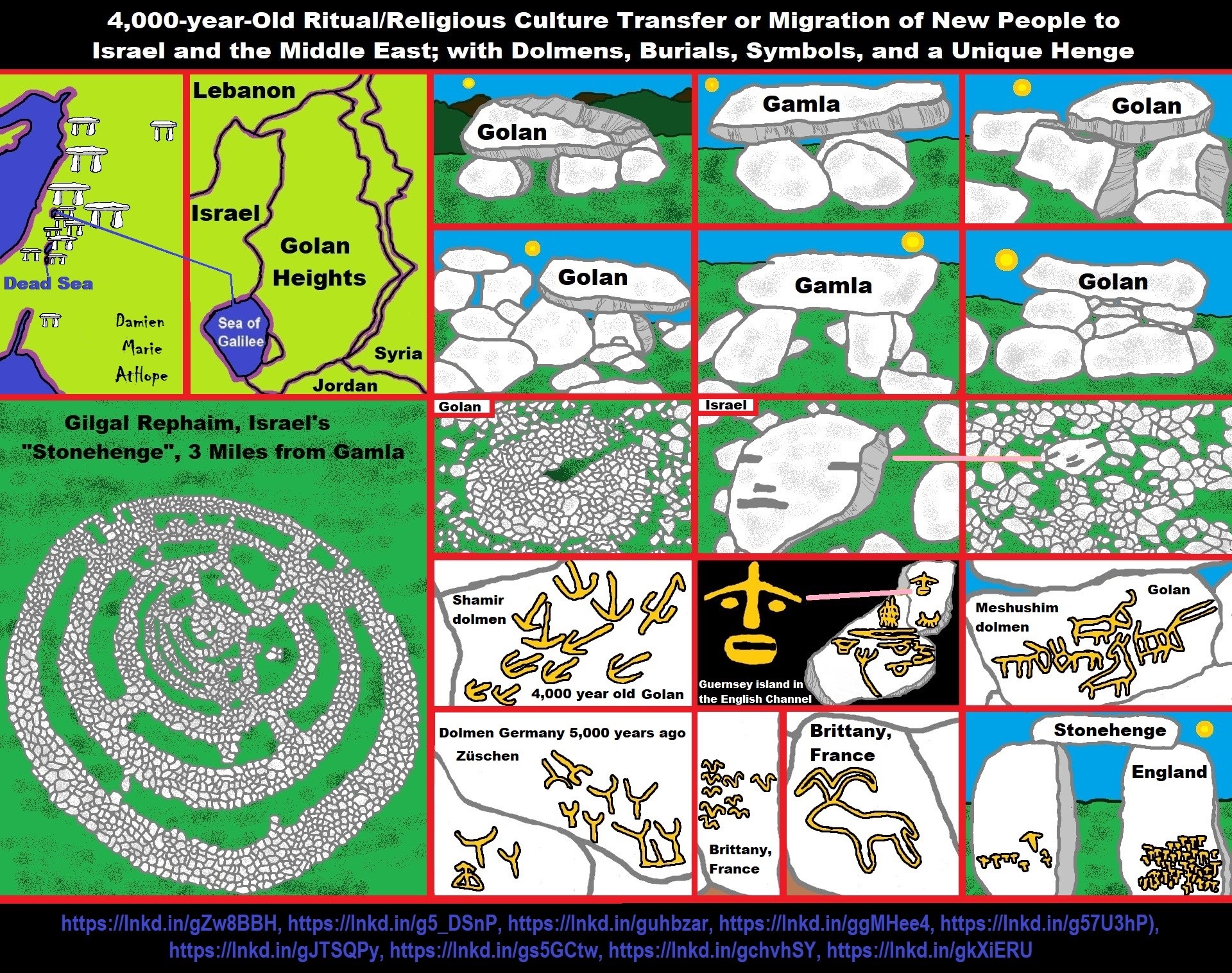
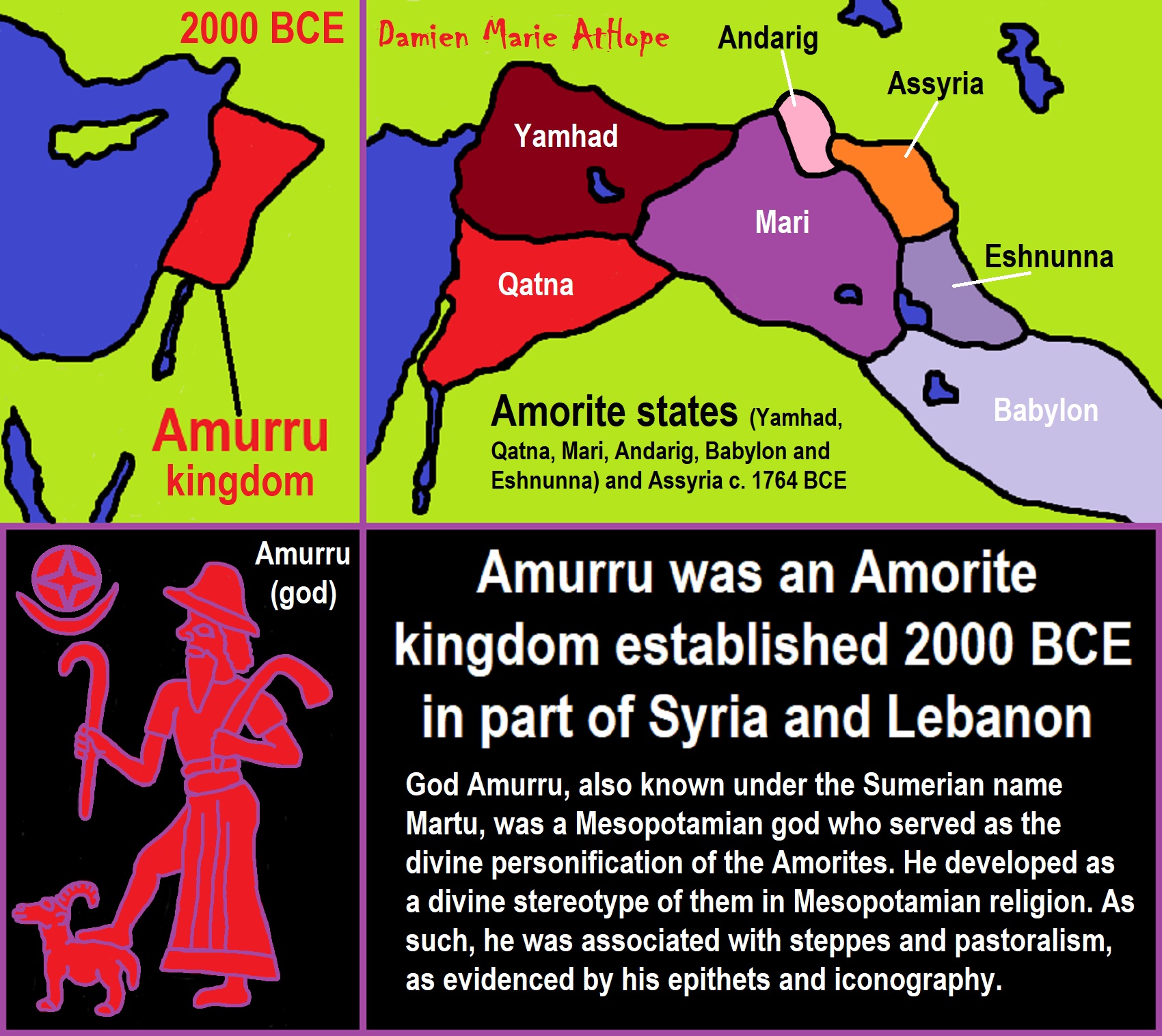

The Bible Unearthed: Archaeology’s New Vision of Ancient Israel and the Origin of Its Sacred Texts, involves leading scholars Israel Finkelstein and Neil Asher Silberman who draw on recent archaeological research to present a dramatically revised portrait of ancient Israel and its neighbors. They argue that crucial evidence (or a telling lack of evidence) at digs in Israel, Egypt, Jordan, and Lebanon suggests that many of the most famous stories in the Bible—the wanderings of the patriarchs, the Exodus from Egypt, Joshua’s conquest of Canaan, and David and Solomon’s vast empire—reflect the world of the later authors rather than actual historical facts. What they argue, in chapter after chapter, is that these books of the Bible make the most sense as coming out of a seventh-century (BC) context. A lot of the Bible is royal and elite propaganda to justify empire expanding through conquest. Overall the differing archaeology evidence and the complete lack of any confirming archaeology evidence is devastating to all the Abrahamic religions. Ref
Some stories in the Bible were meant to be history, others fiction. But modernity has obscured the original distinction between the two kinds of biblical writing, depriving readers of the depth of the text. Perhaps surprisingly, this confusion lies at the heart of the History Channel’s miniseries “The Bible,” which continues the pattern of blurring history and fiction, and thereby misrepresenting the nature of the Bible to its viewers. One way to understand the difference between history and fiction in the Bible is through the Old Testament’s natural division into three parts:
- The world and its nature (Adam to Terah).
- The Israelites and their purpose (Abraham to Moses).
- The Kingdom of Israel and life in Jerusalem (roughly from King David onward).
Even a cursory look reveals a clear and significant pattern. In the first section, characters live many hundreds of years, and in the second, well into their second century. Only in the third section do biblical figures tend to live biologically reasonable lives. For example, Adam, in the first section, lives to the symbolic age of 930, and Noah lives even twenty years longer than that. Abraham, from the second section, lives to be 175, his son Issac to 180, and Jacob “dies young” at the age of 147. But the lifespans from King David onward, in the third section, are in line with generally accepted human biology. Furthermore, historians mostly agree that only the third section represents actual history. The reasonable ages in the third section of the Bible, and, in particular, the wildly exaggerated ages in the first, suggest that the authors of the Old Testament intended only the third part as history. Underscoring this crucial difference, some of the lifespans in the first two sections are so absurd as to defy literal interpretation. These hugely advanced ages are central clues about the point of the stories. The Old Testament contains a wide range of texts in addition to stories: laws, prayers, moral codes, and more. But even the stories come in more than one variety. Noah and the Great Flood are not in the same category as Moses and the Ten Commandments, and both are different than King David and the First Temple. History and fiction mingle throughout the Old Testament, so these divisions are just rough guides. Jeremiah’s historical description of the siege on Jerusalem is not the same as Ezekiel’s non-historical vision of the dry bones, just as there are historical elements (like the invention of fire-hardened bricks) even in the non-historical account of the Tower of Babel. The interesting point here is not that some of these stories happened and some didn’t (though that’s almost certainly true). The point is that the Bible itself portrays them differently, only presenting some of them as having happened. In other words, sometimes “believing the Bible” means believing that a story in it didn’t happen. The situation not unlike a modern newspaper, which combines news with opinion, puzzles, comics, etc. The news can be accurate even if the comics are not. The same is true for the different parts of the Bible. The New Testament similarly offers more than just stories, and, as with the Old Testament, only some of the stories in the New Testament were meant as history. Others were intended to convey things like theology and morality. The account of Jesus’ life in the Gospels is not the same as the beast in Revelation or Adam’s life in Genesis. (The issue of different categories for Jesus and Adam is a matter of fierce modern debate because of its potential theological significance and its interaction with the theory of evolution.) All of this is important for people who want to believe, for instance, that a man named Jesus was crucified in ancient Jerusalem (as described in the Gospels) even if they don’t believe that a donkey spoke aloud (Numbers); or that Jews lived in Jerusalem during the first millennium BC (Kings, for example) even if they didn’t leave Egypt 600,000 strong (Exodus). Ref
Pagan Yahwism: The Folk Religion of Ancient Israel
The Bible imagines the religion of ancient Israel as purely monotheistic. And doubtless there were Israelites, particularly those associated with the Jerusalem Temple, who were strict monotheists. But the archaeological evidence (and the Bible, too, if you read it closely enough) suggests that the monotheism of many Israelites was far from pure. For them, Yahweh (the name of the Israelite god) was not the only divinity. Some Israelites believed that Yahweh had a female consort. And many Israelites invoked the divinity with the help of images, particularly figurines. I call this Israelite religion pagan Yahwism. The archaeological evidence we will look at comes mostly from Judah in what is known in archaeological terms as the Assyrian period, the span from 721 B.C.E., when the Assyrians destroyed the northern kingdom of Israel, until 586 B.C.E., when the Babylonians conquered Jerusalem, destroyed the Temple and brought an end to the Davidic dynasty in Judah. This period, to put it into perspective, is several centuries after King Solomon built the Jerusalem Temple in about 950 B.C.E. So the archaeological evidence we are about to discuss documents a level of Israelite paganism long after Solomon built an exclusive home for Israel’s god. While Yahweh was the god of the Israelites, other nations had their own national gods. The chief god of the Phoenicians was Ba‘al. For the Philistines, the chief god was at first Dagon and later also Ba‘al (Judges 16:23; 2 Kings 1:2). For the Ammonites it was Milkom. For the Moabites, Chemosh. For the Edomites, Qos. And for the Israelites and Judahites—Yahweh. Except for the Edomite god Qos, who appears only in the archaeological record, all of these gods are mentioned in the Bible (1 Kings 11:5, 7, 33). Interestingly, while each nation’s chief god had a distinctive name, his consort, the chief female deity, had the same name in all these cultures: Asherah or its variants Ashtoreth or Astarte. (As we shall see, this was even true of Yahweh’s consort.) Not only was the female consort the same, the various nations used the same cult objects, the same types of incense altars made of stone and clay, the same bronze and clay censers, cult stands and incense burners, the same chalices and goblets and the same bronze and ivory rods adorned with pomegranates. It was easy to take cult vessels of one deity and place them in the service of another one—and this was commonly done. Ref
How Should We Study Ancient Israelite Religion?
If we propose to study the history of the religion of ancient Israel, we must be governed by the same postulates that are the basis of modern historical method. Our task must be a historical, not a theological, enterprise. We must trace the origins and development of Israel’s religion, its emergence from its West Semitic, particularly Canaanite, past, its continuities with the past, its innovations, individual or peculiar configurations, its new emergent whole, and its subsequent changes and evolution. In the past historical questions of “origins” or “emergence” of the ancient Israelite religion could not be answered satisfactorily and indeed were rarely addressed. Today, thanks to the archaeological exploration of Israel and neighboring lands, the history of Israel has become part of the history of the ancient Near Eastern world. Israel’s ancient literature can be viewed increasingly as evolving out of the genres of kindred literatures. We possess Northwest Semitic epic literature from a century or so before Moses. The religion of Israel can now be described in its continuities with, and in its contrasts with, contemporary Near Eastern and especially West Semitic mythology and cult. Ref
Israel 13,000 years ago?
A 13,000-year-old brewery found in Israel, the consumption of fermented and alcoholic beverages is one of the most prevalent human behaviors, but the time and cultural context of its origins remain unclear but it is usually associated with fermenting domesticated species in agricultural societies, such as ancient Egypt, Mesopotamia, China, and South America. It has long been speculated that humans’ thirst for beer may have been the stimulus behind cereal domestication, and some scientists have attributed this invention to the Natufians, a Neolithic culture that inhabited the Levant region of the eastern Mediterranean from about 15,000 to 11,700 years ago. And as stated by Stanford University researcher Dr. Li Liu, “Alcohol making and food storage were among the major technological innovations that eventually led to the development of civilizations in the world, and archaeological science is a powerful means to help reveal their origins and decode their contents.” The archaeologists analyzed residues from 13,000-year-old stone mortars found in Raqefet Cave, a Natufian burial cave site located near what is now Haifa, Israel. Their analysis confirmed that these mortars were used for brewing of wheat/barley, as well as for food storage. A Natufian burial area was found with about 30 individuals; a wealth of small finds such as flint tools, animal bones and ground stone implements, and about 100 stone mortars and cupmarks. The Natufians exploited at least seven plant types associated with the mortars, including wheat or barley, oat, legumes and bast fibers (including flax). They used bedrock mortars for pounding and cooking plant-foods, and for brewing wheat/barley-based beer, likely served in ritual feasts 13,000 years ago. Jiajing Wang, a doctoral student at Stanford University said, “Ancient beer is far from what we drink today. It was most likely a multi-ingredient concoction like porridge or thin gruel.” It is presumed that beer brewing may have been, at least in part, an underlying motivation to cultivate cereals in the southern Levant, supporting the beer hypothesis proposed by archaeologists more than six decades ago. http://www.sci-news.com/archaeology/raqefet-cave-brewery-06412.html
Israel 12,000 years ago?
Shaman burial in Israel 12,000 years ago and the Shamanism Phenomena. Evidence of a ritual feast at a 12,000-year-old archaeological site in northern Israel. No houses, fireplaces or cooking areas were recovered. Instead, the cave yielded the skeletal remains of at least 28 individuals interred in three pits and two small structures. One of these structures contained the complete skeleton of an older woman, who we interpreted as a shaman based on her special treatment at death. Her grave stood apart due to its fine construction—the walls were plastered with clay and inset with flat stone slabs. Even more remarkable was the eclectic array of animal body parts buried alongside of her. The pelvis of a leopard, the wing tip of an eagle, the skulls of two martens and many other unusual body parts surrounded her skeleton. The butchered remnants of more than 90 tortoises buried in the grave and the leftovers of at least three wild cattle deposited in a second adjacent depression excavated in the cave floor represent the remains of a funeral feast. The outstanding preservation of the grave enabled us to detect multiple phases of a ritual performance that included the consumption of the feast, the burial of the woman, and the filling of the grave in several stages, including the intentional deposition of garbage from the feast. https://www.newsweek.com/ancient-israel-ritual-site-12000-year-old-skeletons-earliest-evidence-holiday-753861
Israel 11,000 years ago?
While transiting from hunting to farming, prehistoric people were strip-mining Kaizer Hill for flint and limestone, say, archaeologists. An 11,000-year old quarry where prehistoric people sourced the flint for their arrows and spearheads and limestone too has been identified between Jerusalem and Tel Aviv. The works provide evidence that well before prehistoric humans settled down, they were capable of manufacturing on what we can only call an industrial scale. The quarry, found on the 300 meter-high hill Kaizer Hill on the outskirts of Modiin, is the earliest known Neolithic quarry in the southern Levant, though other prehistoric quarries have been found in the area, including an evidently much older one from the lower-middle Paleolithic period, in Sde Ilan. The marks on Kaizer Hill’s bedrock had been recognized as manmade in the past. The innovation now is reinterpreting “cup-marks” in the bedrock. They aren’t some remnants or mortars carved into the rock, apparently, but were caused by the Neolithic men digging out suitable rocks. https://www.haaretz.com/archaeology/11-000-year-old-neolithic-quarry-found-1.5426850
Israel 10,000 years ago?
Not by Bread alone, Neolithic People in Israel first to farm Fava Beans, 10,000 years ago. Heaps of charred beans found in northern Israel prove that prehistoric humans grew legumes as a staple crop before they cultivated grains. Israelis mix them into their hummus. Egyptians eat them mashed for breakfast. It turns out both are following a proud tradition: A new study strongly suggests that humans living in the Galilee first domesticated fava beans more than 10,000 years ago, eating them as a staple well before grain began to be cultivated in the area. Fava beans, also known as broad beans, are the only crop known to have been domesticated in what is today Israel. https://www.haaretz.com/archaeology/fava-beans-farmed-in-israel-10k-years-ago-1.5408015
Israel 9,000 years ago?
A sprawling, prosperous Neolithic village dated to 9,000 years ago has been discovered in Motza, at the foot of the Jerusalem hills. The site, featuring dozens of stone houses, grander buildings that may have been temples, and skeletal remains were discovered serendipitously during works ahead of building a new road. People were still transitioning from hunting-gathering to farming when this vast town with stone houses and red-floored gathering sites arose by Jerusalem. Red temple floors, it seems the Neolithic villagers made their stone bricks crudely, using flint tools, and apparently rammed wooden stakes into cracks in the natural rock to break it. The stone bricks were cemented with mud, which means that every time the winter rainy season came around, the walls would need maintenance. The town was built at the confluence of two streams. These village builders 9,000 years ago were among the early adopters of a settled lifestyle. Though some stabs at cultivation clearly began in the Levant at least 23,000 years ago, it would take millennia before people transitioned more firmly from hunting and gathering for subsistence to farming. The Motza site isn’t the only huge settlement from that time, though there are others, mainly in Jordan. https://www.haaretz.com/israel-news/.premium.MAGAZINE-9-000-year-old-neolithic-city-discovered-in-jerusalem-valley-1.6271740
Israel 8,000 years ago?
Around 8,000-year-old fertility, stone works found in Israel linked to ancestor cult. About 8,000 years ago, Stone Age people built a large number of what seem to be ancestor and fertility cult sites in the Negev Desert in Israel. A new archaeological survey of 95 sites has turned up stones arranged to represent death, while vulva- and penis-shaped rocks and stone arrangements suggest fertility. In combination these death and sex arrangements relate to ancestor cults, the lead researcher said. Little is known of the spiritual and religious activities of the people of this region from the Neolithic. The main essence of the cult in these sites was for the ancestors, though with the ‘regular’ standing stones found in the sites, individual ones, pairs, triads, and groups of seven, may also indicate invocation to a complex pantheon with several ‘organic’ groups of deities which are later known from Near Eastern art, dedication inscriptions and mythological texts. Since the sites are dated long before the invention of writing, we have no way to know deities’ names, we only know which type of groups the standing stones represent, for example, a god and a goddess, a goddess and two young gods etc. https://www.ancient-origins.net/news-history-archaeology/8000-year-old-fertility-stone-works-found-israel-cult-020211
Israel 7,000 years ago?
Israeli archaeologists have unearthed a 7,000-year-old settlement in northern Jerusalem. excavation exposed two houses with well-preserved remains and floors containing pottery vessels, flint tools, and a basalt bowl. The items are representative of the early Chalcolithic period, beginning around 5,000 B.C. Similar developments have been found elsewhere in present-day Israel, but not in Jerusalem until this, seeming to express an established society. Very well organized settlement with cemeteries. The excavation covered an area of about 500 square feet. https://www.tweentribune.com/article/tween56/archaeologists-find-ancient-7000-year-old-settlement/?page=4
Israel 6,500–5,800 years ago?
6,500–5,800 years ago in Israel Late Chalcolithic (Copper Age) Period in the Southern Levant Seems to Express Northern Levant Migrations, Cultural and Religious Transfer. The Levant which may refer to Isreal in a common use way generally includes Cyprus, Syria, Israel, Jordan, Lebanon, Palestine and the Northern Sinai Peninsula. DNA evidence expresses waves of migration from Anatolia and the Zagros mountains (today’s Turkey and Iran) to the Levant helped develop the Chalcolithic culture that existed in Israel’s Upper Galilee region some 6,500 years ago. ref This was a time of great development along with the spread of agriculture from Western Asia throughout Southern and Central Europe. Urban cultures in Mesopotamia and Anatolia flourished, developing the wheel. Copper ornaments became more common, marking the beginning of the Chalcolithic. Animal husbandry spread throughout Eurasia, reaching China. World population grew slightly throughout the millennium, possibly from 5 to 7 million people. ref “After 10 years of research, we understand that Anatolia/Turkey, especially from the west, is part of the basis of all European peoples. Matching how all European cattle are all descended from Iranian cattle dispersed by farmer herders leaving Anatolia/Turkey.” – Joachim Burger – Anthropologist & Population Geneticist Johannes Gutenberg University, Mainz https://www.youtube.com/watch?v=I2vYr6gx56o&t=651s
Israel 5,000 years ago?
5,000 years ago, the Canaanites now generally recognize as Israel, Palestine, Lebanon, Syria, and Jordan. The Canaanites created the first alphabet, established colonies throughout the Mediterranean, and were mentioned many times in the Bible. But who were they and what ultimately happened to them? Were they annihilated like the Bible says? Over 90 percent of the genetic ancestry of present-day Lebanese was derived from the Canaanites referenced from the genomes of five Canaanite individuals who lived almost 4,000 years ago, one in a large jar burial along with genomes representing people from modern-day Lebanon, in addition a small proportion of Eurasian ancestry that may have arrived via conquests by distant populations such as the Assyrians, Persians, or Macedonians. An estimate that new Eurasian people mixed with the Canaanite population about 3,800 to 2,200 years ago at a time when there were many conquests of the region from outside. “The Bible reports the destruction of the Canaanite cities and the annihilation of its people; if true, the Canaanites could not have directly contributed genetically to present-day populations. However, no archaeological evidence has so far been found to support the widespread destruction of Canaanite cities between the Bronze and Iron Ages. We show that present-day Lebanese derive most of their ancestry from a Canaanite-related population, which therefore implies substantial genetic continuity in the Levant since at least the Bronze Age.” the study read. http://www.cell.com/ajhg/fulltext/S0002-9297(17)30276-8, https://www.sciencedaily.com/releases/2017/07/170727122039.htm
Israel 4,000 years ago?
A ceramic vessel bearing the sculpture of a pensive-looking figure, a 4,000-Year-Old ‘Thinker’ Sculpture found in the Israeli city of Yehud. It seems that at first the jug, which is typical of the period, was prepared, and afterward, the unique sculpture was added. Researchers discovered the vessel alongside other items, including arrowheads, an axe head, sheep bones, daggers and what appear to be donkey bones. These were likely funerary objects, originally buried alongside the body of an important person. Deeper excavations revealed artifacts dating back at least 6,000 years. These included pottery vessels, flint and basalt tools, and animal bones, according to the IAA. Researchers also found a Copper Age butter churn. Archaeologists discovered the unusual jug in fragments, and IAA conservators restored it. The neck of the jug provides the “seat” for the pensive figure, Itach said. The archaeologists said they aren’t sure whether the original potter made the figure or if some other artist decided to add an embellishment to the plain jug. The artifact comes from around 2000 B.C., the Middle Bronze Age in the Levant (the region including modern-day Israel and the eastern Mediterranean). According to the Metropolitan Museum of Art, this was a time when nomadic people called Amorites settled throughout the northern part of the region and when traders shuttled back and forth between the Levant and Egypt. https://www.livescience.com/56986-ancient-thinker-sculpture-uncovered-in-israel.html
Israel 3,000 years ago?
Signs of 3,000-year-old Oracle Cult in Ancient Israel. Abel Beth Maacah was famed in biblical times for conflict resolution: Now archaeologists have found a strange shrine that may have served the city’s ‘wise woman.’ Archaeologists have found a strange shrine that they think may have been associated with the “wise woman” of the city, mentioned in the bible. But rather than being just a clever elder – they suspect she may have fulfilled an oracular role. The tell in which Abel Beth Maacah was identified lies just south of Israel’s border with Lebanon, near the town of Metulla. The archaeological mound, called Tell Abil el-Qameh, covers a huge 100 dunams in area. In fact, archaeologists have uncovered evidence for a succession of religious cult practices spanning some 300 years. Numerous shrines were found, which, as is the norm for ancient spots of worship, were ornate in some fashion or other. But among the discoveries in recent excavations was an unadorned shrine, the only one of its type found in the town. The reasons to associate the bare shrine with an oracle stem from puzzling biblical mentions of a “wise woman”. The archaeologists now suspect that at least in the case of Abel Beth Maacah, she was a local version of the divine oracles known from other cultures around the Mediterranean. Various ruins found during the latest excavations, roughly dated to the second and first millennia B.C.E. Aside from the shrine, the archaeologists found a large building complex dating to about 3,000 years ago that served diverse industrial, administrative and religious functions. https://www.haaretz.com/archaeology/.premium.MAGAZINE-signs-of-3-000-year-old-oracle-cult-found-in-israel-archaeology-1.6472911
Judaism is around 3,450 or 3,250 years old. (“Paleo-Hebrew” 3,000 years ago and Torah 2,500 years ago)
“Judaism is an Abrahamic, its roots as an organized religion in the Middle East during the Bronze Age. Some scholars argue that modern Judaism evolved from Yahwism, the religion of ancient Israel and Judah, by the late 6th century BCE, and is thus considered to be one of the oldest monotheistic religions.” ref
“Yahwism is the name given by modern scholars to the religion of ancient Israel, essentially polytheistic, with a plethora of gods and goddesses. Heading the pantheon was Yahweh, the national god of the Israelite kingdoms of Israel and Judah, with his consort, the goddess Asherah; below them were second-tier gods and goddesses such as Baal, Shamash, Yarikh, Mot, and Astarte, all of whom had their own priests and prophets and numbered royalty among their devotees, and a third and fourth tier of minor divine beings, including the mal’ak, the messengers of the higher gods, who in later times became the angels of Judaism, Christianity and Islam. Yahweh, however, was not the ‘original’ god of Israel “Isra-El”; it is El, the head of the Canaanite pantheon, whose name forms the basis of the name “Israel”, and none of the Old Testament patriarchs, the tribes of Israel, the Judges, or the earliest monarchs, have a Yahwistic theophoric name (i.e., one incorporating the name of Yahweh).” ref
“El is a Northwest Semitic word meaning “god” or “deity“, or referring (as a proper name) to any one of multiple major ancient Near Eastern deities. A rarer form, ‘ila, represents the predicate form in Old Akkadian and in Amorite. The word is derived from the Proto-Semitic *ʔil-, meaning “god”. Specific deities known as ‘El or ‘Il include the supreme god of the ancient Canaanite religion and the supreme god of East Semitic speakers in Mesopotamia’s Early Dynastic Period. ʼĒl is listed at the head of many pantheons. In some Canaanite and Ugaritic sources, ʼĒl played a role as father of the gods, of creation, or both. For example, in the Ugaritic texts, ʾil mlk is understood to mean “ʼĒl the King” but ʾil hd as “the god Hadad“. The Semitic root ʾlh (Arabic ʾilāh, Aramaic ʾAlāh, ʾElāh, Hebrew ʾelōah) may be ʾl with a parasitic h, and ʾl may be an abbreviated form of ʾlh. In Ugaritic the plural form meaning “gods” is ʾilhm, equivalent to Hebrew ʾelōhîm “powers”. In the Hebrew texts this word is interpreted as being semantically singular for “god” by biblical commentators. However the documentary hypothesis for the Old Testament (corresponds to the Jewish Torah) developed originally in the 1870s, identifies these that different authors – the Jahwist, Elohist, Deuteronomist, and the Priestly source – were responsible for editing stories from a polytheistic religion into those of a monotheistic religion. Inconsistencies that arise between monotheism and polytheism in the texts are reflective of this hypothesis.” ref
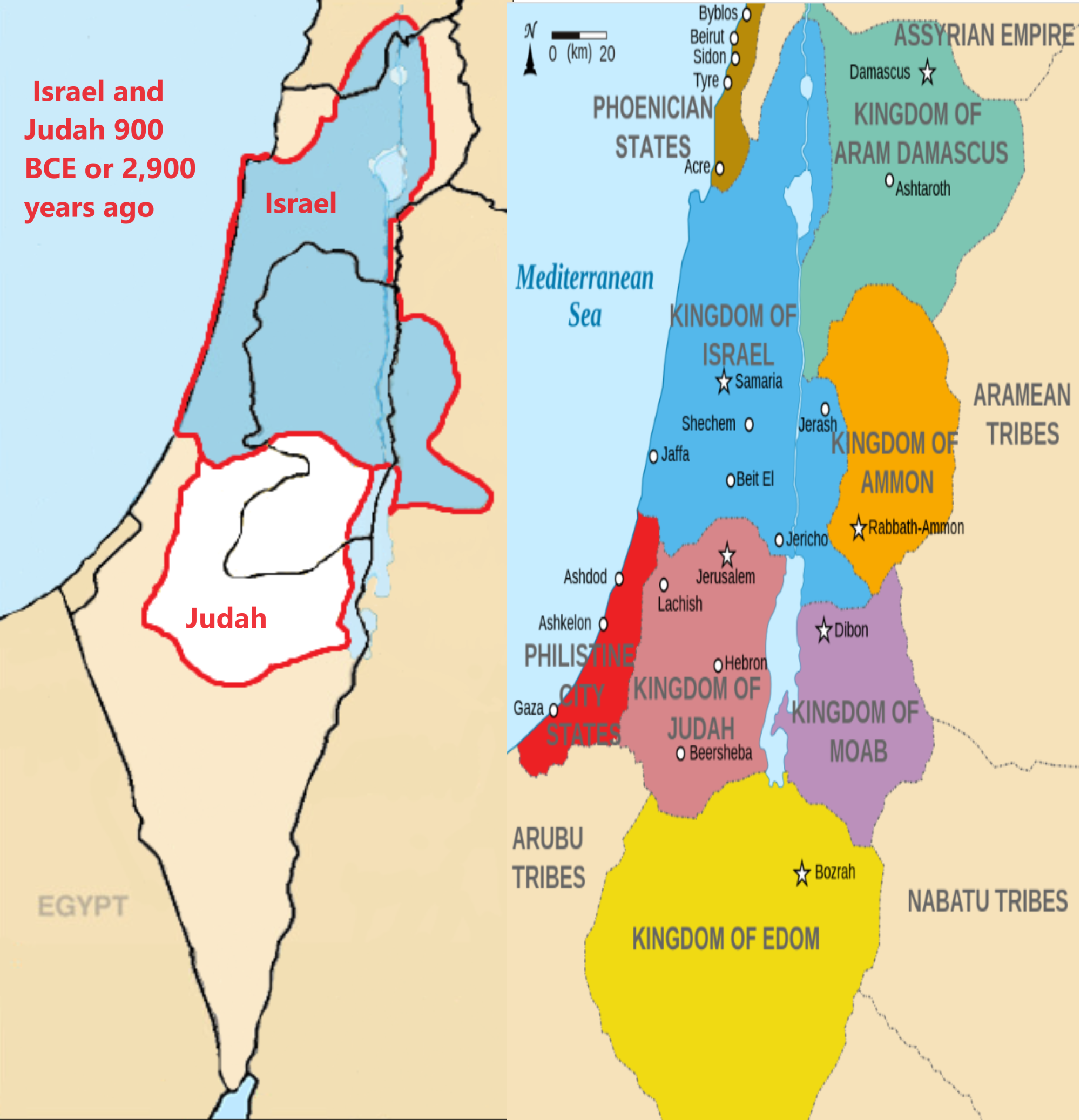
“In the early first millennium BCE and the time of the first millennium BCE is from around 3,000 to 2,000 years ago, the Israelite kingdoms of Israel and Judah emerged, before falling to the Neo-Assyrian and Neo-Babylonian empires, respectively.” https://en.wikipedia.org/wiki/Israel
Genetic studies on Jews
“Genetic analysis finds that Jewish groups show evidence of both varying degrees of genetic descent from peoples of the Levant or Near East, and admixture and introgression with non-Jewish host populations. Studies on the genetic composition of Ashkenazi, Sephardi, and Mizrahi Jewish populations of the Jewish diaspora show significant amounts of shared Middle Eastern ancestry. Several Jewish groups show genetic proximity to Lebanese, Palestinians, Bedouins, and Druze in addition to Southern European populations, including Cypriots and Italians. Jews living in the North African, Italian, and Iberian regions show variable frequencies of admixture with the historical non-Jewish population along the maternal lines. In the case of Ashkenazi and Sephardi Jews (in particular Moroccan Jews), who are closely related, the source of non-Jewish admixture is mainly southern European. Some researchers have remarked on an especially close relationship between Ashkenazi Jews and modern Italians. Some studies show that the Bene Israel and Cochin Jews of India, and the Beta Israel of Ethiopia, while very closely resembling the local populations of their native countries, may have some ancient Jewish descent.” ref
“In the late 1990s, Uzi Ritte cross-analyzed Y-chromosome and mtDNA sequences in six Jewish communities and found indications of “admixture with neighboring communities of non-Jews”. A study of Ashkenazi mtDNA in 2013 meanwhile revealed four matrilineal founders, all of which had ancestry in prehistoric Europe, rather than the Near East or Caucasus. Falk notes that, “not surprisingly, Ashkenazi Jews prove to compose a distinct yet quite integral branch of European genomic tapestry.” Several genetic studies demonstrated that approximately half of the genetic lineage of Ashkenazi Jews may be traced to the ancient Middle East and the other half to Europe, proving proximity to both ancient and present Middle Eastern and European groups. The majority of the European half comes mainly from southern European populations. Several studies estimate that between 50% to 80% of Ashkenazic Y-chromosomal (paternal) lineages originate in the Near East, with some estimating that at least 80% of their maternal lineages originated in Europe. Most researchers now believe that the early Jewish communities of southern Europe, which are the forebears of Ashkenazi Jews, are descended from both the ancient Israelites and from European converts to Judaism.” ref
“Approximately 35% to 43% of Jewish men are in the paternal line known as haplogroup J and its sub-haplogroups. This haplogroup is particularly present in the Middle East and Southern Europe. 15% to 30% are in haplogroup E1b1b, (or E-M35) and its sub-haplogroups which is common in the Middle East, North Africa, and Southern Europe. The haplogroup Mediterranean T1a1 is found in varying percentages depending on the Jewish group studied but with upward of 15 to 3% with the highest frequency within Jewish communities native to the Fertile Crescent and East Africa. In 1992 G. Lucotte and F. David were the first genetic researchers to have documented a common paternal genetic heritage between Sephardi and Ashkenazi Jews. Another study published just a year later suggested the Middle Eastern origin of Jewish paternal lineages. In 2000, M. Hammer, et al. conducted a study on 1,371 men and definitively established that part of the paternal gene pool of Jewish communities in Europe, North Africa and Middle East came from a common Middle East ancestral population. They suggested that most Jewish communities in the Diaspora remained relatively isolated and endogamous compared to non-Jewish neighbor populations.” ref
“Investigations by Nebel et al. on the Y-haplotypes (paternal lineages) of Ashkenazi Jews, Kurdish and Sephardi (North Africa, Turkey, Iberian Peninsula, Iraq and Syria) indicate that Jews are more genetically similar to groups in the northern Fertile Crescent (Kurds, Turks and Armenians) than their Arab neighbors, and suggest that some of this difference might be due to migration and admixture from the Arabian peninsula during the last two millennia (into certain current Arabic-speaking populations). Considering the timing of this origin, the study found that “the common genetic Middle Eastern background (of Jewish populations) predates the ethnogenesis in the region and concludes that the Y chromosome pool of Jews is an integral part of the genetic landscape of Middle East. The study nevertheless found a high degree of overall similarity between Jewish and local Arab groups. Lucotte et al. 2003 study found that (Oriental, Sephardic, Ashkenazic Jews and Lebanese and Palestinians), “seem to be similar in their Y-haplotype patterns, both with regard to the haplotype distributions and the ancestral haplotype VIII frequencies.” The authors stated in their findings that these results confirm similarities in the Y-haplotype frequencies of this Near-Eastern populations, sharing a common geographic origin.” ref
“In a study of Israeli Jews from four different groups (Ashkenazi Jews, Kurdish Jews, North African Sephardi Jews, and Iraqi Jews) and Palestinian Muslim Arabs, more than 70% of the Jewish men and 82% of the Arab men whose DNA was studied had inherited their Y chromosomes from the same paternal ancestors, who lived in the region within the last few thousand years. “Our recent study of high-resolution microsatellite haplotypes demonstrated that a substantial portion of Y chromosomes of Jews (70%) and of Palestinian Muslim Arabs (82%) belonged to the same chromosome pool.” All Jewish groups were found to be genetically closer to each other than to Palestinians and Muslim Kurds. Kurdish, North African Sephardi, and Iraqi Jews were found to be genetically indistinguishable while slightly but significantly differing from Ashkenazi Jews. In relation to the region of the Fertile Crescent, the same study noted; “In comparison with data available from other relevant populations in the region, Jews were found to be more closely related to groups in the north of the Fertile Crescent (Kurds, Turks, and Armenians) than to their Arab neighbors”, which the authors suggested was due to migration and admixture from the Arabian Peninsula into certain current Arabic-speaking populations during the period of Islamic expansion.” ref
“The Y chromosome of most Ashkenazi and Sephardi Jews contains mutations that are common among Middle Eastern peoples, but uncommon in the general European population, according to a study of haplotypes of the Y chromosome by Michael Hammer, Harry Ostrer and others, published in 2000. According to Hammer et al. this suggests that the paternal lineages of Ashkenazi Jews could be traced mostly to the Middle East. The study estimated that on their paternal side, Ashkenazi Jews are descended from a core population of approximately 20,000 Jews who migrated from Italy into the rest of Europe over the course of the first millennium, and it also estimated that “All European Jews seem connected on the order of fourth or fifth cousins.” The study also maintained that the paternal lines of Roman Jews were close to those of Ashkenazi Jews. It asserts that these mostly originated from the Middle East. The frequency of haplogroup R1b in the Ashkenazim population is similar to the frequency of R1b in Middle Eastern populations. This is significant, because R1b is also the most common haplogroup amongst non-Jewish males in Western Europe. That is, the commonness of nominally Middle Eastern subclades of R1b amongst Ashkenazim tends to minimize the Western European contribution to the ~10% of R1b found amongst Ashkenazim. A large study by Behar et al. (2004) of Ashkenazi Jews records a percentage of 5–8% European contribution to the Ashkenazi paternal gene pool.” ref
“Furthermore, 7% of Ashkenazi Jews have the haplogroup G2c, which is mainly found among the Pashtuns and on a lower scale, it is mainly found among members of all major Jewish ethnic groups, Palestinians, Syrians, and Lebanese. Behar et al. suggest that those haplogroups are minor Ashkenazi founding lineages. Ashkenazi men show a low level of Y-DNA diversity within each major haplogroup, which means that compared to the size of the modern population, it seems that there once was a relatively small number of men having children. This possibly results from a series of founder events and high rates of endogamy within Europe. Despite Ashkenazi Jews representing a recently founded population in Europe, founding effects suggest that they probably derived from a large and diverse ancestral source population in the Middle East, who may have been larger than the source population from which the non-Jewish Europeans derived. In the article by Nebel et al. the authors show that Kurdish and Sephardi Jews have indistinguishable paternal genetic heritage, with both being similar to but slightly differing from Ashkenazi Jews (possibly due to a low-level European admixture or a genetic drift during isolation among Ashkenazim). The study shows that mixtures between Kurdish Jews and their Muslim hosts are negligible and Kurdish Jews are closer to other Jewish groups than they are to their long term host population. Hammer had already shown the strong correlation between the genetic heritage of Jews from North Africa with Kurdish Jews. Sample size 9/50 – 18% haplogroup T1.” ref
“According to Thomas et al. in 2002, a number of Jewish communities reveal direct-line maternal ancestry originating from a few women. This was seen in independently founded communities in different geographic areas. What they shared was limited genetic additions later on the female side. Together, this is described as the founder effect. Those same communities had diversity in the male lines that was similar to the non-Jewish population. Two studies in 2006 and 2008 suggested that about 40% of Ashkenazi Jews originate maternally from four female founders likely of Near-Eastern origin who lived 1,000 years ago, while the populations of Sephardi and Mizrahi Jewish communities “showed no evidence for a narrow founder effect”. Reflecting on previous mtDNA studies carried out by Behar, Atzmon et al. conclude that all major Jewish population groups are showing evidence for founder females of Middle Eastern origin with coalescence times >2000 years. A 2013 study by Richards et al., based on a much larger sample base, drew differing conclusions, namely, that the Mt-DNA of Ashkenazi Jews originated among southern European women, where Diaspora communities had been established centuries before the fall of the Second Temple in 70 CE.” ref
“A 2014 study by Fernandez et al. found that Ashkenazi Jews display a frequency of haplogroup K which suggests an ancient Near Eastern origin, stating that this observation clearly contradicts the results of the study led by Richards which suggested a predominantly European origin for the Ashkenazi community’s maternal lines. However, the authors of the 2014 study also state that definitively answering the question of whether this group was of Jewish origin rather than the result of a Neolithic migration to Europe would require the genotyping of the complete mtDNA in ancient Near Eastern populations. In 2004, Behar et al. found that approximately 32% of Ashkenazi Jews belong to the mitochondrial Haplogroup K, which points to a genetic bottleneck having taken place some 100 generations prior. Haplogroup K itself is thought to have originated in Western Asia some 12,000 years ago. A 2006 study by Behar et al., based on high-resolution analysis of Haplogroup K (mtDNA), suggested that about 40% of the current Ashkenazi population is descended matrilineally from just four women, or “founder lineages”, likely of mixed European and Middle Eastern origin. They concluded that these founder lineages may have originated in the Middle East in the 1st and 2nd centuries CE, and later underwent expansion in Europe.” ref
What Percentage of Native American DNA, Do You Have To Be To Enroll With a Tribe? 25% Native American ancestry or more is what I have heard. And thus we can see that this could also relate to how DNA is expressed with Jewish DNA.
Israeli Citizenship DNA Test
“Generally speaking, those who are interested in Israeli citizenship by DNA test wish to prove Jewish ancestry in order to immigrate to Israel based on Israel’s 1950 Law of Return. This law indicates that any Jew, child of a Jew, or grandchild of a Jew, is permitted to immigrate to Israel. Subsequent legal processes indicate that this is only so long as a person has not converted to another religion. Despite a number of publications saying the opposite, a DNA test is not considered evidence that can be used to justify immigration to Israel. Beyond the doubtful reliability of such tests, it’s entirely possible for a Jewish family to convert to another religion, which bars the possibility of Aliyah. For example, many applicants from the former Soviet Union have had family documents destroyed during the civil war or World War II the Great Patriotic War. During the latter in particular, families would often destroy any documents proving Jewish background when under German occupation or due to fear that they would soon be occupied. In these cases, unfortunately, it is almost impossible to immigrate to Israel. We often receive emails from people indicating that they found out they have Jewish ancestry, but they cannot prove this through family documents. In order to immigrate, it is possible to do so after conversion to Judaism. Please see our article addressing this for more information.” ref
Genetic citizenship: DNA testing and the Israeli Law of Return
“Abstract: The Israeli State recently announced that it may begin to use genetic tests to determine whether potential immigrants are Jewish or not. This development would demand a rethinking of Israeli law on the issue of the definition of Jewishness. In this article, we discuss the historical and legal context of secular and religious definitions of Jewishness and rights to immigration in the State of Israel. We give a brief overview of different ways in which genes have been regarded as Jewish, and we discuss the relationship between this new use of genetics and the society with which it is co-produced. In conclusion, we raise several questions about future potential impacts of Jewish genetics on Israeli law and society.” ref
Genetic Origin of the Palestinians
“Palestinian villagers and notable families alike generally trace the origins of their clan (hamula) to Arab nomad tribes from the Arabian peninsula who settled in the region before or after the Islamic conquest. A small number of Palestinian families follow oral traditions that trace their roots to Jewish and Samaritan origins. The ongoing effort of nation-building and the effort to solidify Palestinian national consciousness as the primary framework of identity, as opposed to other identities dominant among Palestinians, including primordial clannish, tribal, local, and Islamist identities, have an impact on internal Palestinian historical discourse regarding the origins of Palestinians.” ref
“The complex demographic history of Palestine has been influenced by several historical occurrences and migrations. The region has been home to diverse populations over centuries. During the Bronze Age, it was inhabited by the Canaanites, Semitic-speaking peoples. In the early Iron Age, the Israelites emerged as a separate ethnoreligious group in the region, forming the two related kingdoms of Israel and Judah. The fall of those kingdoms to Assyrian and Babylonian conquests was accompanied by forced exile eastwards. The region then came under Achaemenid, Ptolemaic and Seleucid rule. Jews eventually formed the majority of the population in Palestine during classical antiquity, even enjoying a brief period of independence under the Hasmonean dynasty, before the area was incorporated into Roman rule. However, the Jewish-Roman Wars and especially the Bar Kokhba revolt resulted in the death, displacement or slavery of many Jews, and as a result, the Jewish population in Judea declined significantly.” ref
“In the centuries that followed, the region experienced political and economic unrest, conversions to the rising new religion of Christianity, and the religious persecution of minorities. A Christian majority eventually formed under Byzantine rule as a result of Christian immigration, Jewish departure, conflicts such as the Samaritan revolts, and the conversion of locals. The Arabs, having adopted the religion of Islam, conquered the Levant in the 7th century, and in the following centuries, several Arabic-speaking Muslim dynasties such as the Umayyads, Abbasids, and Fatimids came to rule the region. Palestine’s population sharply declined throughout the subsequent centuries, falling from an estimated 1 million during the Roman and Byzantine periods to roughly 300,000 by the early Ottoman period. As time passed, many of the existing population converted to Islam and adopted Arab culture and language. Arab settlement both before and after the Muslim conquest is thought to had hastened the pace of Islamization. Much of the local Palestinian population in the area of Nablus is believed to be descended from Samaritans who converted to Islam.” ref
“It is unknown whether Palestine’s population shifted toward Islam before or after the Crusader period. Some academics suggest that Palestine was already predominately Muslim at the time the Crusaders arrived. Alternatively, it has been argued that the process of mass Islamization occurred much later, perhaps during the Mamluk period. Palestine’s demographic composition was again impacted by the waves of Egyptian migration during the reigns of Muhammad Ali and Ibrahim Pasha, as well as Algerians who immigrated following Abdelkader El Djezaïri‘s revolt in the first half of the 19th century, and the subsequent immigration of Algerians, Bosnians, and Circassians during the second half of the 19th century. Palestine’s population dropped and hovered between 150,000 and 250,000 people for several centuries under the Ottoman Empire; it wasn’t until the 19th century that the country’s population started to expand rapidly.” ref
“A study found that the Palestinians, like Jordanians, Syrians, Iraqis and Kurds have what appears to be Female-Mediated gene flow in the form of Maternal DNA Haplogroups from Sub-Saharan Africa. 15% of the 117 Palestinian individuals tested carried maternal haplogroups that originated in Sub-Saharan Africa. These results are consistent with female migration from eastern Africa into Near Eastern communities within the last few thousand years. There have been many opportunities for such migrations during this period. However, the most likely explanation for the presence of predominantly female lineages of African origin in these areas is that they may trace back to women brought from Africa as part of the Arab slave trade, and assimilated into the areas under Arab rule. According to a study published in June 2017 by Ranajit Das, Paul Wexler, Mehdi Pirooznia, and Eran Elhaik in Frontiers in Genetics, “in a principal component analysis (PCA) [of DNA], the ancient Levantines [from the Natufian and Neolithic periods] clustered predominantly with modern-day Palestinians and Bedouins…” In a study published in August 2017 by Marc Haber et al. in The American Journal of Human Genetics, the authors concluded that “The overlap between the Bronze Age and present-day Levantines suggests a degree of genetic continuity in the region.” ref
“In a 2003 genetic study, Bedouins showed the highest rates (62.5%) of the subclade Haplogroup J-M267 among all populations tested, followed by Palestinian Arabs (38.4%), Iraqis (28.2%), Ashkenazi Jews (14.6%) and Sephardic Jews (11.9%), according to Semino et al. Semitic-speaking populations usually possess an excess of J1 Y chromosomes compared to other populations harboring Y-haplogroup J. The haplogroup J1, the ancestor of subclade M267, originates south of the Levant and was first disseminated from there into Ethiopia and Europe in Neolithic times. J1 is most common in Palestine, as well as Syria, Iraq, Algeria, and Arabia, and drops sharply at the border of non-semitic areas like Turkey and Iran. A second diffusion of the J1 marker took place in the 7th century CE when Arabians brought it from Arabia to North Africa. A 2013 study by Haber et al. found that “The predominantly Muslim populations of Syrians, Palestinians and Jordanians cluster on branches with other Muslim populations as distant as Morocco and Yemen.” The authors explained that “religious affiliation had a strong impact on the genomes of the Levantines. In particular, conversion of the region’s populations to Islam appears to have introduced major rearrangements in populations’ relations through admixture with culturally similar but geographically remote populations leading to genetic similarities between remarkably distant populations.” The study found that Christians and Druze became genetically isolated following the arrival of Islam. The authors reconstructed the genetic structure of pre-Islamic Levant and found that “it was more genetically similar to Europeans than to Middle Easterners.” ref
“In a genetic study of Y-chromosomal STRs in two populations from Israel and the Palestinian Authority Area: Christian and Muslim Palestinians showed genetic differences. The majority of Palestinian Christians (31.82%) were a subclade of E1b1b, followed by G2a (11.36%), and J1 (9.09%). The majority of Palestinian Muslims were haplogroup J1 (37.82%) followed by E1b1b (19.33%), and T (5.88%). The study sample consisted of 44 Palestinian Christians and 119 Palestinian Muslims. In recent years, genetic studies have demonstrated that, at least paternally, Jewish ethnic divisions and the Palestinians are related to each other. Genetic studies on Jews have shown that Jews and Palestinians are closer to each other than the Jews are to their host countries. At the haplogroup level, defined by the binary polymorphisms only, the Y chromosome distribution in Arabs and Jews was similar but not identical. According to a 2010 study by Behar et al. titled “The genome-wide structure of the Jewish people”, Palestinians tested clustered genetically close to Bedouins, Jordanians and Saudi Arabians which was described as “consistent with a common origin in the Arabian Peninsula”. In the same year a study by Atzmon and Harry Ostrer concluded that the Palestinians were, together with Bedouins, Druze and southern European groups, the closest genetic neighbors to most Jewish populations.” ref
“One DNA study by Nebel found substantial genetic overlap among Israeli/Palestinian Arabs and Jews. Nebel proposed that “part, or perhaps the majority” of Muslim Palestinians descend from “local inhabitants, mainly Christians and Jews, who had converted after the Islamic conquest in the seventh century CE”. A 2020 study on remains from Canaanaite (Bronze Age southern Levantine) populations suggests a significant degree of genetic continuity in Arabic-speaking Levantine populations (such as Palestinians, Druze, Lebanese, Jordanians, Bedouins, and Syrians), as well as in several Jewish groups (such as Ashkenazi, Iranian, and Moroccan Jews), suggesting that the aforementioned groups derive over half of their entire atDNA ancestry from Canaanite/Bronze Age Levantine populations, albeit with varying sources and degrees of admixture from differing host or invading populations depending on each group.” ref
“The results also show that a significant European component was added to the region since the Bronze Age (on average ~8.7%), excluding the Ashkenazi populations who harbour a ~41% European-related component. The European component is highest in Moroccan and Ashkenazi Jews, both having a history in Europe. The study concludes that this does not mean that any of these present-day groups bear direct ancestry from people who lived in the Middle-to-Late Bronze Age Levant or in Chalcolithic Zagros; rather, it indicates that they have ancestries from populations whose ancient proxy can be related to the Middle East. These present-day groups also show ancestries that cannot be modeled by the available ancient DNA data, highlighting the importance of additional major genetic effects on the region since the Bronze Age.” ref
Zionism
“Zionism is the movement for the self-determination and statehood for the Jewish people in their ancestral homeland, the land of Israel. The vast majority of Jews around the world feel a connection or kinship with Israel, whether or not they explicitly identify as Zionists, and regardless of their opinions on the policies of the Israeli government. While there has been a continuous Jewish presence in the land of Israel over the millennia, the yearning to return to Zion, the biblical term for both the land of Israel and Jerusalem, has been a cornerstone of Jewish communal life since the Romans violently colonized the land, sending Jews into exile two thousand years ago. Zionists believe in and support the right of the democratic State of Israel to exist as a Jewish homeland. Israel is the only Jewish state in the world. Being a Zionist is distinct from supporting the policies of the government of Israel. Zionism is a big tent movement that includes those across the spectrum from progressives, moderates and conservatives and those who are apolitical. There are Zionists who are critical of Israeli policies, just as there are Zionists who rarely voice disagreement with the Israeli government. There are diverse views among Zionists about the Israeli-Palestinian conflict, about how to promote peace, whether to support a two-state solution, and about approaches to Israeli settlements. Being critical of Israeli policies is no more anti-Zionist than being critical of American policies is anti-American. Zionism does not preclude support for Palestinian self-determination and statehood. For some Zionists, support for a two-state solution is the realization of self-determination for Jews and Palestinians alike. There are also millions of non-Jews who consider themselves Zionists and supporters of the Jewish state, who are motivated by factors including religion, history, security or politics.” https://www.adl.org/resources/backgrounder/zionism
“Zionism is a nationalist movement that emerged in the 19th century to espouse support for the establishment of a homeland for the Jewish people in Palestine, a region roughly corresponding to the Land of Israel in Jewish tradition. Following the establishment of Israel, Zionism became an ideology that supports “the development and protection of the State of Israel“. The common denominator among all Zionists has been a claim to Palestine, a land traditionally known in Jewish writings as the Land of Israel (“Eretz Israel“) as a national homeland of the Jews and as the legitimate focus for Jewish national self-determination. It is based on historical ties and religious traditions linking the Jewish people to the Land of Israel. Zionism does not have a uniform ideology, but has evolved in a dialogue among a plethora of ideologies: General Zionism, Religious Zionism, Labor Zionism, Revisionist Zionism, Green Zionism, etc. In 1975, the United Nations General Assembly passed Resolution 3379, which designated Zionism as “a form of racism and racial discrimination”. The resolution was repealed in 1991 by replacing Resolution 3379 with Resolution 46/86.” ref
“Zionism is opposed by a wide variety of organizations and individuals. Among those opposing Zionism there are Palestinian nationalists, states of the Arab League and many of the Muslim world, the former Soviet Union, some secular Jews, and some sects of Judaism such as Satmar Hasidim and Neturei Karta. Reasons for opposing Zionism are varied, and they include: the perception that land confiscations are unfair; expulsions of Palestinians; violence against Palestinians; and alleged racism. Arab states in particular strongly oppose Zionism, which they believe is responsible for the 1948 Palestinian expulsion and flight. The preamble of the African Charter on Human and Peoples’ Rights, which has been ratified by 53 African countries as of 2014, includes an undertaking to eliminate Zionism together with other practices including colonialism, neo-colonialism, apartheid, “aggressive foreign military bases” and all forms of discrimination. In 1945 US President Franklin D Roosevelt met with king Ibn Saud of Saudi Arabia. Ibn Saud pointed out that it was Germany who had committed crimes against the Jews and so Germany should be punished. Palestinian Arabs had done no harm to European Jews and did not deserve to be punished by losing their land. Roosevelt on return to the US concluded that Israel “could only be established and maintained by force.” ref
Anti-Zionism
“Anti-Zionism is opposition to Zionism. Although anti-Zionism is a heterogeneous phenomenon, all its proponents agree that the creation of the modern State of Israel, and the movement to create a sovereign Jewish state in the region of Palestine – the biblical Land of Israel – was flawed or unjust in some way. Zionism’s proponents note its success in establishing the Jewish state of Israel in the region of Palestine, and seek to portray anti-Zionism as broad opposition to Israel and a Jewish presence in the region. Supporters of Zionism often highlight that some antisemites hold anti-Zionist views. The relationship between Zionism, anti-Zionism and antisemitism is debated, with some academics and organizations that study antisemitism taking the view that anti-Zionism is inherently antisemitic or new antisemitism, while others reject any such linkage as unfounded and a method to stifle criticism of Israel and its policies, including its occupation of the West Bank. In the 1960s and 1970s, the Soviets and Americans interpreted the Arab–Israeli conflict as a proxy war between the totalitarianism of the Soviet–Arab alliance and the democracies of the Western world. The Israeli victory in the Six-Day War of 1967 necessitated a diplomatic response by the Soviet–Arab alliance. The result were resolutions in the Organization for African Unity and the Non-Aligned Movement condemning Zionism and equating it with racism and apartheid during the early 1970s.” ref
“This culminated in November 1975 in the United Nations General Assembly‘s passage of Resolution 3379 by a vote of 72 to 35 (with 32 abstentions), which declared, “Zionism is a form of racism, and racial discrimination”. The passage evoked, in the words of American UN Ambassador Daniel Patrick Moynihan, “a long mocking applause.” UN representatives from Libya, Syria, and the PLO made speeches claiming that this resolution negated previous resolutions calling for land-for-peace agreements between Israel and its Arab neighbors. Israel’s UN representative Chaim Herzog interpreted the resolution as an attack on Israel’s legitimacy. African UN delegates from non-Arab countries also resented the resolution as a distraction from the fight against racism in places like South Africa and Rhodesia. The decision was revoked on 16 December 1991, when the General Assembly passed Resolution 4686, repealing resolution 3379, by a vote of 111 to 25, with 13 abstentions and 17 delegations absent. Thirteen of the 19 Arab countries, including those engaged in negotiations with Israel, voted against the repeal, and another six were absent. All the ex-communist countries and most of the African countries who had supported Resolution 3379 voted to repeal it.” ref
“Anti-Zionism has a long history of being supported by various individuals and groups associated with Third Position, right-wing and fascist (or “neo-fascist”) political views. A number of militantly racist groups and their leaders are anti-Zionist, such as David Duke, the Ku Klux Klan, and various other Aryan/White-supremacist groups. In these instances, anti-Zionism is usually also deeply antisemitic, and often revolves around conspiracy theories discussed below. The opposite phenomenon, of Zionist/pro-Israel antisemites, has also been documented, often associated with American Christian evangelicals. Some Jewish organizations oppose Zionism as an integral part of their anti-imperialism. Today, some secular Jews, particularly socialists and Marxists, continue to oppose the State of Israel on anti-imperialist and human rights grounds. Many oppose it as a form of nationalism, which they argue to be a product of capitalist societies. One secular anti-Zionist group today is the International Jewish Anti-Zionist Network, a socialist, antiwar, anti-imperialist organization that calls for “the dismantling of Israeli apartheid return of Palestinian refugees, and the ending of the Israeli colonization of historic Palestine.” ref
Israeli occupation of the West Bank
“The Israeli occupation of the West Bank began on 7 June 1967, when Israeli forces captured and occupied the territory (including East Jerusalem), then ruled by Jordan, during the Six-Day War, and continues to the present day. The status of the West Bank as a militarily occupied territory has been affirmed by the International Court of Justice and, with the exception of East Jerusalem, by the Israeli Supreme Court. The official view of the Israeli government is that the laws of belligerent occupation do not apply to the territories, which it claims are “disputed”, and it administers the West Bank, excepting East Jerusalem, under the Israeli Civil Administration, a branch of the Israeli Ministry of Defense. Considered to be a classic example of an “intractable” conflict, the length of Israel’s occupation was already regarded as exceptional after two decades, and is now the longest in modern history. Israel has cited several reasons for retaining the West Bank within its ambit: a claim based on the notion of historic rights to this as a homeland as claimed in the Balfour Declaration of 1917; security grounds, both internal and external; and the deep symbolic value for Jews of the area occupied.” ref
“Israel has controversially, and in contravention of international law, established numerous Jewish settlements throughout the West Bank. The United Nations Security Council has consistently reaffirmed that settlements in that territory are a “flagrant violation of international law”, most recently in 2016 with United Nations Security Council Resolution 2334. The creation and ongoing expansion of the settlements have led to Israel’s policies being criticized as an example of settler colonialism. Israel has been accused of major violations of international human rights law, including collective punishment, in its administration of the occupied Palestinian territories. Israeli settlers and civilians living or traveling through the West Bank are subject to Israeli law, and are represented in the Knesset; in contrast, Palestinian civilians, mostly confined to scattered enclaves, are subject to martial law and are not permitted to vote in Israel’s national elections. This two-tiered system has caused to be accused of committing apartheid, a charge that Israel rejects entirely. Israel’s vast military superiority, with a modern army and air force, compared to the Palestinian use of guerilla and terrorist tactics, has led to accusations of war crimes on both sides, with Israel being accused of disproportionality and the Palestinians accused of indiscriminate attacks. The occupation also has numerous critics within Israel itself, with some Israeli conscripts refusing to serve due to their objections to the occupation. The legal status of the occupation itself, and not just the actions taken as a part of it, have been increasingly scrutinized by the international community and by scholars in the field of international law, with most finding that regardless of whether the occupation had been legal when it began, it has become illegal over time.” ref
I (Damien Marie AtHope) am an anarchist humanist, I don’t support unjustified and unmeasured violence. I don’t support Israel’s oppression or violence against civilians or children. I also don’t support Hamas’s violence against civilians or children. I do support Palestinians the right to be free. I prefer a “no-states solution” and if people must have states I feel the two-state solution seems the only other way.
Hamas
“Hamas officially the Islamic Resistance Movement, is a Sunni Islamist political and militant organization currently governing the Gaza Strip of the Palestinian territories. While it is headquartered in Gaza City, it also has a presence in the West Bank (the larger of the two Palestinian territories), in which Fatah exercises control. It is widely considered to be the “dominant political force” within the Palestinian territories. Its main political rivals are Palestinian Islamic Jihad and Fatah. Ideology involves Palestinian nationalism, Islamism, Islamic nationalism, Anti-Zionism, Anti-Semitism, and Anti-communism. Since 2007, Hamas has fought several wars with Israel. It historically sought an Islamic Palestinian state over the combined territory of Israel, the West Bank, and the Gaza Strip, rejecting the two-state solution and negotiations with Israel. In 2017, Hamas agreed to a Palestinian state within the 1967 borders, but continued to not recognize Israel. Under the ideological principles of Islamism, it promotes Palestinian nationalism in an Islamic context; it has pursued a policy of jihad (armed struggle) against Israel. The Hamas government has pushed through changes that gave greater influence to Islamic law in the Gaza Strip. It has a social service wing, Dawah, and a military wing, the Izz ad-Din al-Qassam Brigades.” ref
| 2023 Israel–Hamas war | |
|---|---|
| Part of the Arab–Israeli conflict |
“The 2023 Israel–Hamas War is an ongoing conflict between Israel and Palestinian militant groups led by Hamas. Part of the Gaza–Israel conflict, the war began when militants invaded Israel from the Gaza Strip on 7 October 2023, and was followed by an Israeli counteroffensive. Israel formally declared war on Hamas a day later. Hostilities were initiated in the early morning with a rocket barrage of at least 3,000 missiles against Israel and vehicle-transported incursions into its territory. Palestinian militants broke through the Gaza–Israel barrier, attacking nearby Israeli communities and military bases. At least 1,300 Israelis were killed, including a massacre at a music festival that killed at least 260 people. Israeli soldiers and civilians, including women and children, were taken as hostages to the Gaza Strip. This day was described by US President Joe Biden as “the worst single-day massacre of Jews since the Holocaust“. After clearing Hamas forces from affected areas, Israel responded with airstrikes in the densely populated Gaza Strip, targeting both civilian and military infrastructure, including an airstrike on a market that left 60 civilians killed. Hamas-led Health Ministry declared on the fourth day that more than 1,300 Palestinian have been killed since the start of the war.” ref
“The United Nations reported that around 263,000 Palestinians, more than a tenth of the population of Gaza, have been internally displaced. Fears of a humanitarian crisis were heightened after Israel cut off food, water, electricity, and fuel supplies to the already blockaded strip. Many nations including western nations condemned Hamas for the violence, and described its actions as terrorism, while others including Muslim nations cited the Israeli occupation of Palestinian territories as the root cause of the escalation. Many nations called for a de-escalation. Human Rights Watch characterized both Hamas’ and Israel conduct as war crimes. A conflict was reported between Hezbollah and Palestinian militants in Lebanon and Israeli forces on 8 and 9 October. The United States deployed two aircraft carriers and cruises to the Eastern Mediterranean, and Germany declared it would begin supplying military aid to Israel. Israel and Saudi Arabia are conducting negotiations to normalize relations, with Saudi Arabian crown prince Mohammed bin Salman recently stating that normalization was “for the first time, real”. Saudi Arabia’s Foreign Ministry said in a statement that it had “repeatedly warned that Israel’s ongoing occupation of Gaza would propel further violence.” ref
“The Gaza Strip and Israel have been in conflict since the Israeli withdrawal from the Gaza Strip in 2005 and Hamas gaining control of the Gaza Strip after elections in 2006 and a civil war with Fatah in 2007. “The Gaza Strip has been under an Israeli and Egyptian blockade since 2007, leading Human Rights Watch to call the strip an “open-air prison”. The blockade has caused significant economic hardship within Gaza, and was cited by Hamas as one of the reasons for its offensive. In 2023, there were several violent flare-ups in the Israeli–Palestinian conflict. Prior to the attack, including combatants and civilians on both sides, at least 247 Palestinians had been killed by Israeli forces, while 32 Israelis and two foreign nationals had been killed in Palestinian attacks. After the 2022 Israeli legislative election in November, a Netanyahu-lead right-wing government took office the following month. The goverment ramped up settlement construction in the Israeli-occupied West Bank; an increase in Israeli settler attacks there, which has displaced hundreds of Palestinians; and tensions flaring around a flashpoint Jerusalem holy site, the Al-Aqsa Mosque. Indeed, Hamas stated that the attack was in response to Palestinian suffering under occupation and blockade by Israel, stating “Every day they build settlements, seize our lands, kill our people.” ref
Israel and Unethical Collective Punishment
“Israel has a right to self-defence, but it has to be done within international law … cutting water, cutting electricity, cutting food to a mass of civilian people is against international law.” – EU foreign policy chief Josep Borrell euobserver.com/world/157534
“Iran’s foreign minister accused Israel of seeking “genocide” by enforcing a siege against Gaza, according to Iranian state TV, before a visit to Iraq’s capital on Thursday. “Today, the continuation of war crimes by Netanyahu and Zionists against the civilians of Gaza, besieging, cutting off water and electricity, and denying entry of medicine and food, has created conditions where the Zionists are seeking a genocide of all people in Gaza,” Reuters reports Hossein Amir-Abdollahian said. “The war we witness today in the Gaza Strip is not just the Zionists’ war against Hamas, it is the Zionists’ war against all Palestinians.” ref
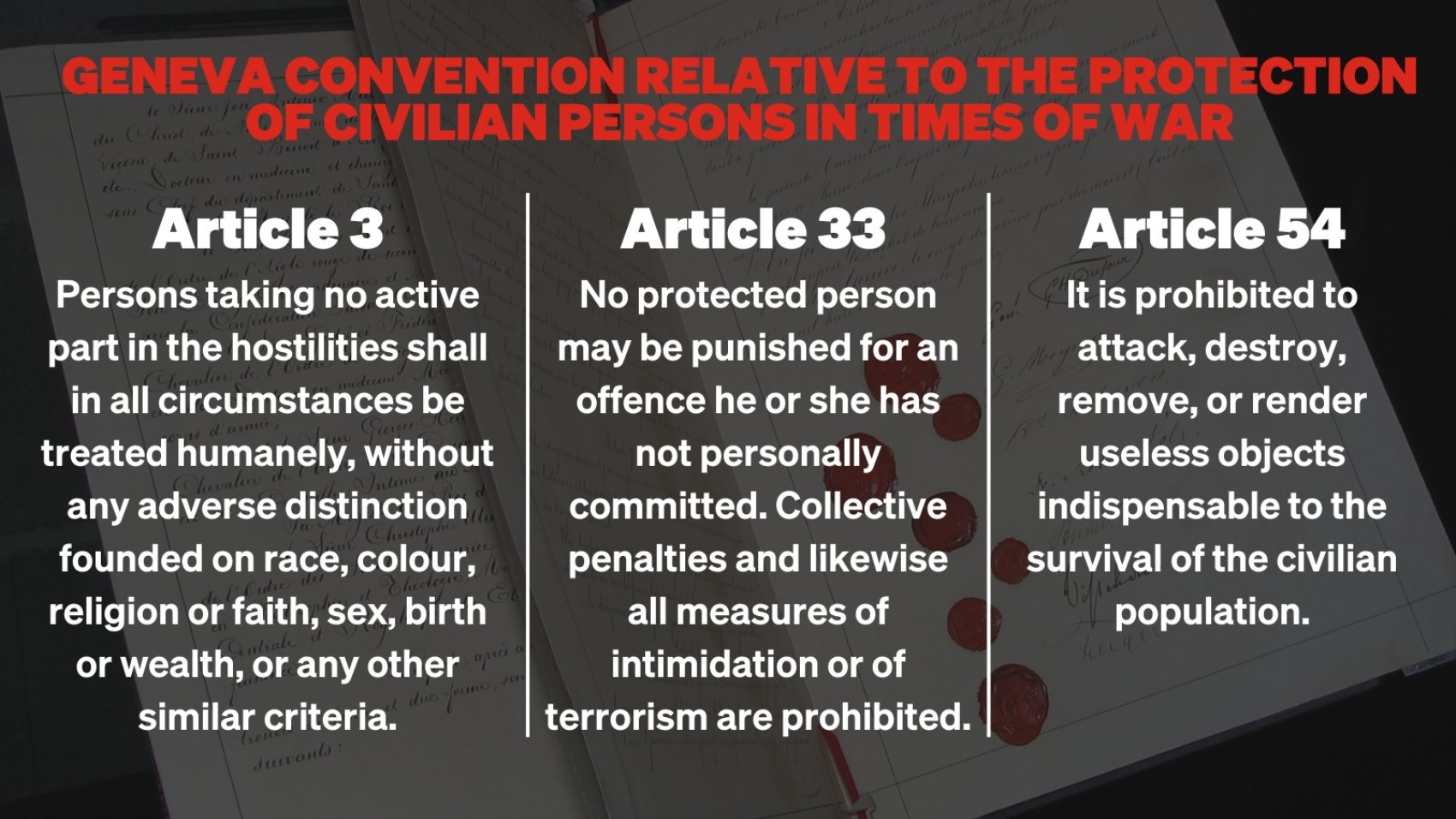
“Israel is committing war crimes by subjecting Palestinians to humanitarian catastrophe as collective punishment.” ref
Neither Israel nor Hamas! – by AnarchistCommunism.org
“We totally condemn and abhor the indiscriminate bombing of the Gaza strip just as we totally condemn the atrocities recently committed by Hamas against civilians, not just Jews but Christians, Bedouin, and others from around the world. As we said back in 2021 when there was another murderous assault on Gaza, “as ever, the working class population of Gaza are those who suffer most beneath the phosphorus explosives and the ‘death from above’ of Israeli rockets and jet fighters who meet with little resistance from a Palestinian government which, whilst armed to the teeth with small arms, has no air force or air defence. Hamas continue to hurl surface to surface missiles in something between impotent rage and a desperate attempt to maintain themselves as defenders of the Palestinian people. Hamas cannot afford a defeat in front of its own population. The proletarians on both sides of the conflict suffer most from the escalation, while the respective leaderships can divert attention from their own problems.” Little has changed in the latest attacks on Gaza.” ref
“Hamas was originally supported by the Israeli State to undermine the more secular Palestine Liberation Organisation (PLO). It has its origins in Mujama al-Islamiya which was founded by the Palestinian cleric Sheikh Ahmed Yasin, seen as an organisation involved in charity and welfare work for the Palestinian community of Gaza. The Israeli state regarded it as preferable to the PLO, as was its successor Hamas. Hamas was always right wing, Islamist and nationalist, with hostile attitudes towards women and LGBQT people and to the Palestinian working class. However, this changed when Hamas killed two Israeli military personnel in Gaza in 1988. In a situation similar to that of the Mujahideen in Afghanistan, supported by the USA and its allies, against Russia and the Afghan regime it supported, where the Taliban evolved to become a greater danger to US imperialism, the Israeli regime began to regret its initial support.” ref
“Hamas took advantage of the peace process between Yasser Arafat and the PLO, and the Israeli state, despite hundreds of Palestinians killed in the first Intifada mass uprising. Hamas thus gained popular support in Gaza. Various Israeli officials went on record to express their regrets about support for Hamas. Avner Cohen, who had been an official in Gaza during direct Israeli occupation admitted that “Hamas, to my great regret, is Israel’s creation.” He went on to say that “instead of trying to curb Gaza’s Islamists from the outset, Israel for years tolerated and, in some cases, encouraged them as a counterweight to the secular nationalists of the Palestine Liberation Organization and its dominant faction, Yasser Arafat’s Fatah. Israel cooperated with a crippled, half-blind cleric named Sheikh Ahmed Yassin, even as he was laying the foundations for what would become Hamas.” ref
“Another Israeli official in Gaza, Andrew Higgins, said “When I look back at the chain of events I think we made a mistake but at the time nobody thought about the possible results…Israel also endorsed the establishment of the Islamic University of Gaza, which it now regards as a hotbed of militancy… Yassin’s Mujama would become Hamas, which, it can be argued, was Israel’s Taliban: an Islamist group whose antecedents had been laid down by the West in a battle against a leftist enemy.” Brigadier General Yitzhak Segev, who had been Israeli military governor in Gaza in the 1980s, admitted that he had helped fund Hamas as a “counterweight to the secularists and leftists of the Palestine Liberation Organization and the Fatah party, led by Yasser Arafat (who himself referred to Hamas as ‘a creature of Israel’).” Hamas gained control of Gaza from the PLO. It imposed sharia laws, forcing women to wear the hijab and imposing an alcohol ban, although both of these have been hard to enforce. Armed clashes broke out between Hamas and the PLO. This suited the Israeli state which felt that fighting between the Islamist Hamas and the secular PLO would divert them from attacking Israel.” ref
No statist solutions!
“Because a solution to the conflict can ultimately only be a common, classless and stateless society in which people of different religious (and non-religious) and ethnic backgrounds can coexist peacefully. And the way to achieve this can only be through class struggle, with workers uniting on both sides to improve their situation and thereby overcoming long-held resentments. It is the task of the libertarian communist movement to push for exactly this. On both sides of the conflict there are actors who see things fundamentally differently, who either want to see one side eradicated from the area or pushed back by the settlement policy and are prepared to sacrifice the lives of non-combatants in the fight for their own interests. We reject both, as it is at the expense of the proletarians and only serves to deepen the divisions within the class. Resistance is needed against both the Israeli state and the Palestinian leadership. Resistance against the Israeli settlement policy is necessary and justified, but this can often be accompanied by anti-Semitic resentment and attacks on the non-combatant population. We must reject this. Similarly, in other countries, sympathy for the plight of ordinary Palestinians and opposition to the Israeli State’s attacks on them can sometimes attract anti-Semitic fellow travellers, or slogans such as ‘We are all Hamas.’ These elements must be shunned.” ref
“We reject the Two State solution, backed even by some socialists, where there would be an Israeli and a Palestinian state co-existing. This would mean a few shabby Palestinian enclaves, with those Palestinians still living in Israel living as at the best second class citizens, and those living in Jordan, Lebanon and other Middle East countries abandoned altogether. Neither do we support a One State solution, which would threaten Jews within a united Palestinian state. For us, all nation states should be rejected. As our comrades of the Melbourne Anarchist Communist Group have written: “The liberation of the Palestinian people, without merely reversing the terms of oppression, can only come about through a workers’ revolution to abolish capitalism completely, to make the land and all social resources the common property of all, abolishing inequality and all forms of oppression. Given the present situation in Israel/Palestine, this is not on the immediate agenda, but it does not deny the necessity of the solution.” ref
“In practical circumstances, the initiative will have to come from the outside, through workers’ revolution in the surrounding Arab countries, most importantly Egypt, which has a large working class already. It is essential, however, for those workers’ revolutions to transcend the nationalism of the countries in which they occur, since it is only internationalism which will allow the workers to defeat their own capitalist rulers; it is only internationalism which will allow Arab workers to reach out in friendship to the workers of Israel; and only internationalism which can break the Israeli working class from its Zionist rulers. The task before the workers of Palestine and Israel is thus no different from the task here. It is only to be conducted in more difficult circumstances. We must build a working class movement, based on liberty, equality and solidarity, and fight for a revolution which will re-make society on the same principles. We must abolish capitalism and its State, and we must recognise the folly of building another State in its wake. We must build Libertarian Communism.” ref
“Israel looks set to launch a full scale invasion of Gaza over the next few weeks and months with the intention of destroying Hamas completely and to drive most Palestinians there into Egypt. If Hezbollah in the Lebanon intervenes, Israel will attack there too and then both Iran and the USA may be drawn into a conflict. Together with the Russian-Ukraine war, the conflict between Armenia and Azerbaijan over Nagorno-Karabakh, and the growing tensions of China, Taiwan, and the US in the pacific, this most recent conflict in Israel-Palestine feeds into the threat to accelerate into a world war. The USA and its allies, including in the UK, with both the increasingly authoritarian Tory regime and the Labour Party, are openly backing Israel. Biden has given carte blanche to Israel for its siege and attacks on Gaza. The USA has sent war ships including an aircraft carrier to the region in a show of strength to support Israel and to threaten Hezbollah. Netanyahu, leader of a coalition government that includes far right parties in Israel, threatens to turn Gaza into “a deserted island.” ref
“The brutal attacks by Hamas resulting in many hundreds of dead have created a feeling of national unity and has temporarily shored up the weak position of the Netanyahu government. This has faced nine months of agitation, including a general strike, over unpopular judicial reforms. Similarly, Hamas only had minority support in the Gaza Strip, but the recent events may also temporarily boost this. We see hundreds slaughtered in both Israel and Palestine. These horrendous scenes that we see in the media may just be an appalling opener to even worse bloodshed and destruction. Against the barbarism of capitalism and the march towards world war we call for working class unity, internationalism and preparation for mass movements that can implement social revolution and create libertarian communism.” ref
NO WAR BUT THE CLASS WAR!
“You either stand with Israel or you stand with terrorism” – Israel Defense Forces
“This is a false dichotomy. I stand with peace. I stand with NOT slaughtering innocent civilians. I stand with NOT committing atrocities and war crimes I stand with NOT depriving people of vital food, water, and power. I am anti-war. I will always stand for peace.” ref – JAX PAGE @jakki_jax
Now an interaction I had on Twitter/X
“The Palestinians are the indigenous people.” – Tired Peasant @LizzieCosmos (A communist momma just surviving. apocalyptic poet. Come join me on this ride of the late stages of capitalism.)
My response (Damien Marie AtHope @AthopeMarie), “Both Israel and Palestinians are from the Canaanites and thus both are indigenous to Palestine.” (Axiological Atheist, Philosopher & Autodidact Pre-Historical Writer/Researcher, Anti-theist, Anti-religionist, Anarcho Humanist, LGBTQI, Race, and class equality.)
“She knows, she just says that because she is an Anti-Semitic Nazi who froths at the mouth seeing Jews massacred. With these “Tankies,” it’s never been about Palestinians or their rights.” – Yair @MarkAnt57438920 (Support the creation of a Palestinian state. Post-Zionist. Mizrahi and Leftist.)
(Tankie is a pejorative label generally applied to communists who express support for one-party communist regimes that are associated with Marxism–Leninism, whether contemporary or historical. It is commonly used by anti-authoritarian leftists, including anarchists, libertarian socialists, left communists, democratic socialists, and reformists to criticise Leninism, although the term has seen increasing use by liberals and right‐wing factions as well. The term “tankie” was originally used by dissident Marxist–Leninists to describe members of the Communist Party of Great Britain (CPGB) who followed the party line of the Communist Party of the Soviet Union (CPSU). Specifically, it was used to distinguish party members who spoke out in defense of the Soviet use of tanks to crush the Hungarian Revolution of 1956 and the 1968 Prague Spring uprising, or who more broadly adhered to pro-Soviet positions. The term is also used to describe people who endorse, defend, or deny the crimes committed by communist leaders such as Vladimir Lenin, Joseph Stalin, Mao Zedong, Enver Hoxha, Pol Pot, and Kim Il Sung. In modern times, the term is used across the political spectrum to describe those who have a bias in favor of illiberal or authoritarian states with a socialist legacy or a nominally left-wing government, such as the Republic of Belarus, People’s Republic of China, the Democratic People’s Republic of Korea, the Republic of Nicaragua, the Russian Federation, the Republic of Serbia, the Syrian Arab Republic, and the Bolivarian Republic of Venezuela. Additionally, some tankies have a tendency to support non-socialist states with no socialist legacy if they are opposed to the United States and the Western world in general, regardless of their ideology, such as the Islamic Republic of Iran. ref)
My response, I don’t think that of her. I think she is a great person but was in error thinking that only Palestinians and not Jews were indigenous. I am more informed as I have been studying prehistory starting 2006. We need each other. We rise by helping each other.
“I hope you are right. But I don’t see it. She retweeted something about how Jews have equal rights in the MENA region which shows how ignorant she is about the history of us MENA Jews. These tankies also supported the massacre of Jews perpetrated by Hamas on Saturday. I oppose the occupation and siege of Gaza but these people who know nothing about the conflict allow themselves to speak about it though again they know nothing.” – Yair @MarkAnt57438920
My response, I am against and horrified by any violation or violence against civilians. I don’t justify Hamas’ terrorism, nor Israel and their terrorism. We all need to champion humanity, not barbarism. Israel and Palestinians should support a free Palestine for both people in equality.
“I know YOU do of course, but again no communist leftie on this site showed this is their view. But Jews would oppose living under a Palestinian state as Palestinians would oppose living under Israel, if both people are to achieve self-determination there has to be some sort of resolution that gives a fair amount of land to each side and gives full equal rights to Palestinians in Israel and Jews who would live in the Palestinian state.” – Yair @MarkAnt57438920
My response, Here is my video explaining it all for anyone interested. “Two Anarchists: Cory Johnston and Damien Marie AtHope, address the Israel and Palestine conflict” https://www.youtube.com/watch?v=YehSOtB8nW0&t=1841s
“I’ll watch it. Does it go back to the Peel Commission’s suggestion of a Jewish state in 1936 and the Arab revolt that followed? (Which is what essentially started the violence cycle that lasts to this day). Until the Peel Commission, the Jews and Arabs lived in relative peace. but the Arabs revolted in opposition to any land given for a Jewish state although the suggested Jewish state would have been in what was almost exclusively Jewish land with Jewish residents. Slight correction there was already violence against Jews but the Hagana chose the line of ignoring it (Hachala) as opposed to the Lehi which enacted vengeance attacks against Arab civilians which is why they separated from the Hagana. And you are right, the Israelites were just an extension of Canaanite culture and people, who formed a new identity. The theory I read is that they were low-class Canaanites that rebelled against the higher-class Canaanites in the Canaanites city-state, which archaeologists suggest-> had the names mentioned in the Bible as the “people of Canaan” Jebusites Edomites etc. But the Bible is wrong in suggesting Israelites invaded Canaan from Egypt as opposed to just being Canaanites themselves, as Genetic tests on MENA Jews suggest. The name Palestine evolved from the name Peleset, which is the name of the “sea people” invaders mentioned in Egyptian texts and the Bible as philistines, which archaeology and genetic tests on remains suggest were of mostly Greek origin. That’s why I don’t understand why Palestinians adopted the identity of what were essentially Greek Vikings, not Levantine native culture. The name did not originate in the Levant as opposed to Canaan, Israel, or Judea, but that is just me.” – Yair @MarkAnt57438920
My response, As an anarchist socialist I am for the people, not any state, but I support what works for peace and greater human flourishing for all involved.
“I wouldn’t oppose a binational state MYSELF but I highly doubt it could work as BOTH sides demonstrate they can’t live together. it would take CENTURIES for the bad blood to subside for that to happen.” – Yair @MarkAnt57438920
My response, Well, the violence of clans starts 7,000 years ago, then worsens from 6,500 to 5,300 years ago. Then people from the Kura–Araxes culture in Turkey and the Caucasus Mountains: Georgia, Azerbaijan, and Armenia. Reach Palestine by at least 4,000 years ago becoming Canaanites.
“Well, yes of course, but the violence is theorized to have originated from Class warfare, and which is why the Israelite identity formed to separate the upper-class Canaanites from the lower-class Israelites. To incite lower-class peasants to revolt against their oppressors. And again, in my opinion, referring to the land Palestine before it was officially named so by Hadrian is not really make much sense as it was a foreign name to the region, but I guess it’s the same as calling America, “America.” America was called “turtle island” by the natives before the Europeans came.” – Yair @MarkAnt57438920
My response, Yes, and I have videos explaining some of America and its indigenous people as well. Colonization and Colonialism of the USA: learning about Indigenous People: https://www.youtube.com/watch?v=1dNkvNgBajc
“I’ll give them a view. It’s sad that names of places take their modern names not from native names because of imperialism. For example, the name Peleset was relegated to the Gaza Ashkelon region before Hadrian changed the name of the land. Not that I deny Palestinian indigeneity, just that the name reminds my people of a time when there was a great effort to erase their connection to their land (which unfortunately almost succeeded) after the Bar Kochba revolt, which is why it carries a heavy weight. You sound very knowledgeable I am sure you already know a lot about the Jewish history of the land. I wouldn’t oppose a binational state MYSELF but I highly doubt it could work as BOTH sides demonstrate they can’t live together. It would take CENTURIES for the bad blood to subside for that to happen. I personally have Palestinian friends who want Palestinians to invent a new identity that shows their native connection to the land because of the origin of “Pelest.” – Yair @MarkAnt57438920
My response, Thank you, I appreciate your thoughtful acknowledgment of my understanding of history. I appreciate learning more about history as it is “the story of us.” We are persuaded by a toxic society to thrive on hate rather than love. My goal is to be an example of the goal to love. We are all related to Africa 70,000 years ago, haplogroup L3. One day we will be humanity.
(“Haplogroup L3 is a human mitochondrial DNA (mtDNA) haplogroup. The clade has played a pivotal role in the early dispersal of anatomically modern humans. It is strongly associated with the out-of-Africa migration of modern humans of about 70–50,000 years ago. It is inherited by all modern non-African populations, as well as by some populations in Africa. Haplogroup L3 arose close to 70,000 years ago, near the time of the recent out-of-Africa event. This dispersal originated in East Africa and expanded to West Asia, and further to South and Southeast Asia in the course of a few millennia, and some research suggests that L3 participated in this migration out of Africa. L3 is also common amongst African Americans and Afro-Brazilians. A 2007 estimate for the age of L3 suggested a range of 104–84,000 years ago. More recent analyses, including Soares et al. (2012) arrive at a more recent date, of roughly 70–60,000 years ago. Soares et al. also suggest that L3 most likely expanded from East Africa into Eurasia sometime around 65–55,000 years ago years ago as part of the recent out-of-Africa event, as well as from East Africa into Central Africa from 60 to 35,000 years ago. In 2016, Soares et al. again suggested that haplogroup L3 emerged in East Africa, leading to the Out-of-Africa migration, around 70–60,000 years ago.” ref)
“Is that your profession or like me, just out of passion?” – Yair @MarkAnt57438920
My response, My passion. I have a BA in psychology. But in college learning more I turned atheist and then went on a life journey to understand religion and humanity, both their evolutions.
“Are you familiar with the recent history of MENA Jews? SO many people I talk to even from MENA countries are not familiar at all with the events that took place in the 50s and 60s there including my family.” – Yair @MarkAnt57438920
My response, I am not as good at recent history as I am mainly knowledgeable on prehistory, 1 million years ago to 4,000 years ago. But I am somewhat familiar with 4,000 to 1,000 years ago. After that, I am not that good.
“I specifically know the history of the land of Israel/Palestine/Canaan from the Bronze Age 4000BCE until the Bar Kochba revolt and subsequent forcible exile of Jews in 135CE. After that, I am less knowledgeable but still know a few things from the Crusades to the Muslim conquest of the region. Also, an Atheist, Agnostic atheist specifically. I studied Zoology to become a conservationist. As for socialism or capitalism, I don’t know enough on the subject, but I can say for certain I absolutely DESPISE Capitalism for what it has done to the Environment (as a conservationist). I lived in Africa for 3 years in Mombasa as part of a conservation mission and to help local communities with new Renewable energy sources.” – Yair @MarkAnt57438920
My response, Cool, then you should enjoy my videos and their blogs. All my videos have blogs from my website will extra information and links. That is great for you to be helpful.
“I’ll give them a view. I also work sometimes in the West Bank to prevent Settler terrorism; I try to do good but sometimes it’s hard when I see so much hate towards my people by people who may have good intentions. Not you, of course, generally speaking, I mean.” – Yair @MarkAnt57438920
My response, I just do good, as humanity activism.
“That’s good. We can all just try to do the best we can.” – Yair @MarkAnt57438920
My response, We can be our best. I am yet again reminded of the beauty of kindness. My conspiracy theory is that there are still a few decent people in the world. And may I, be one of them. We rise by helping each other.
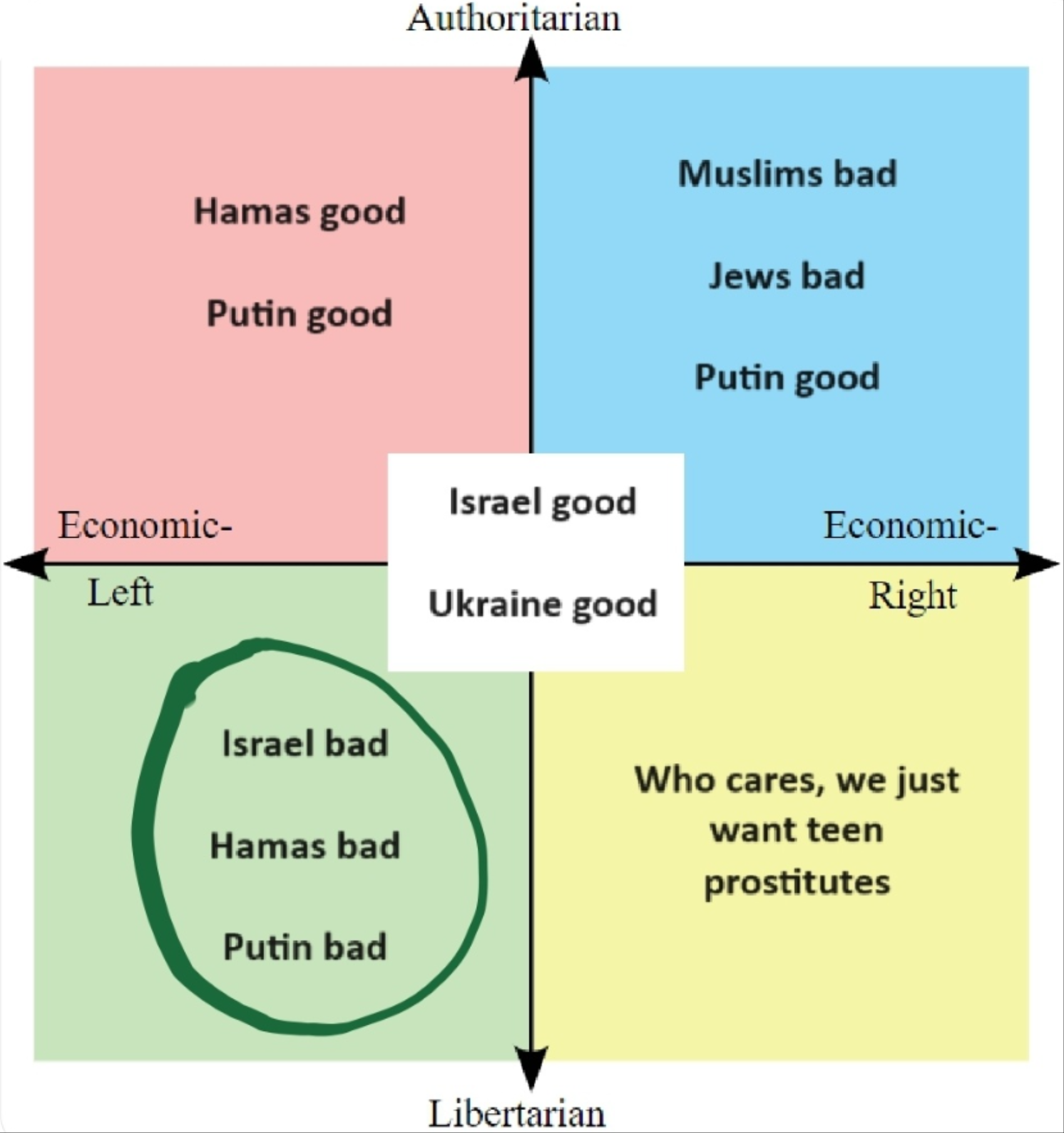
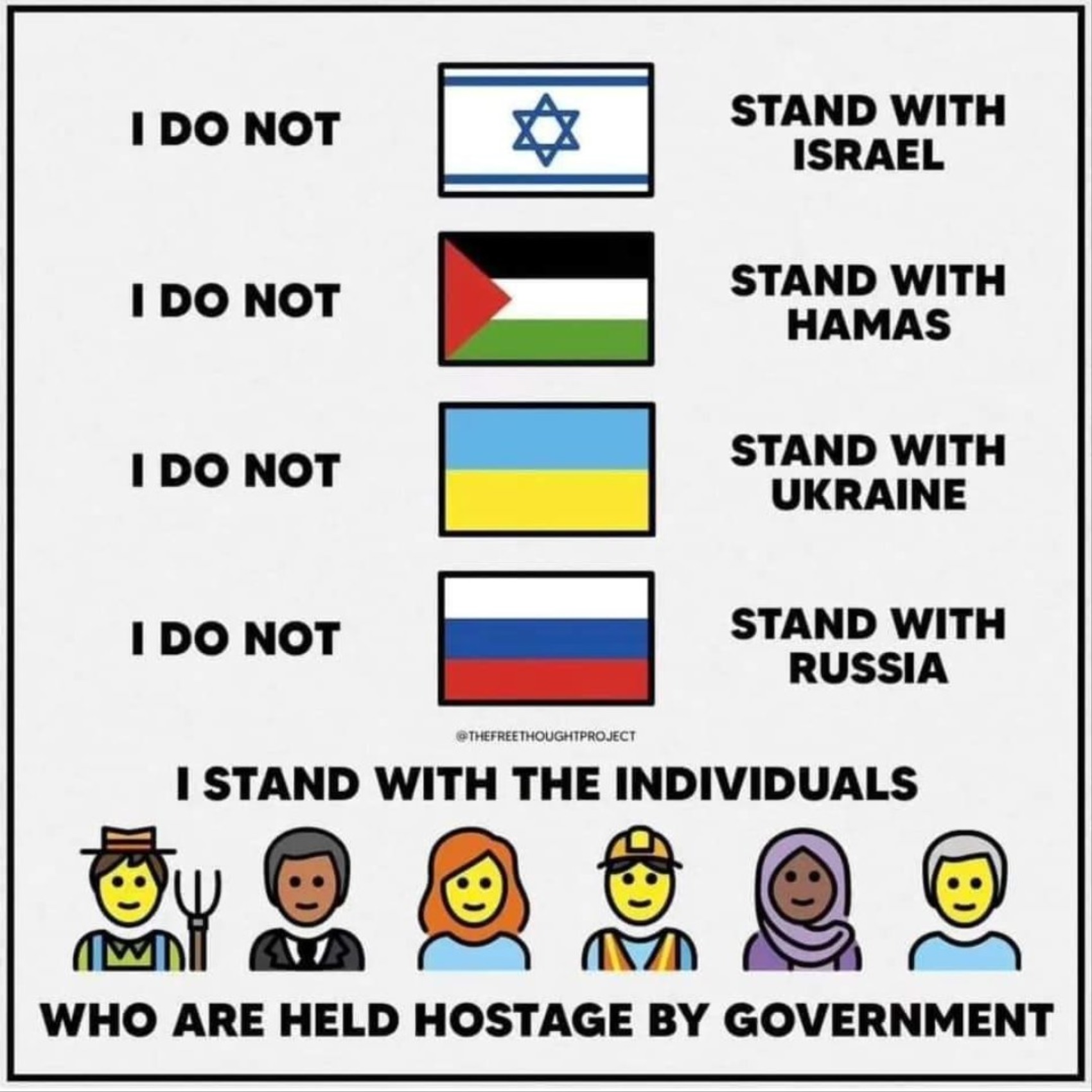
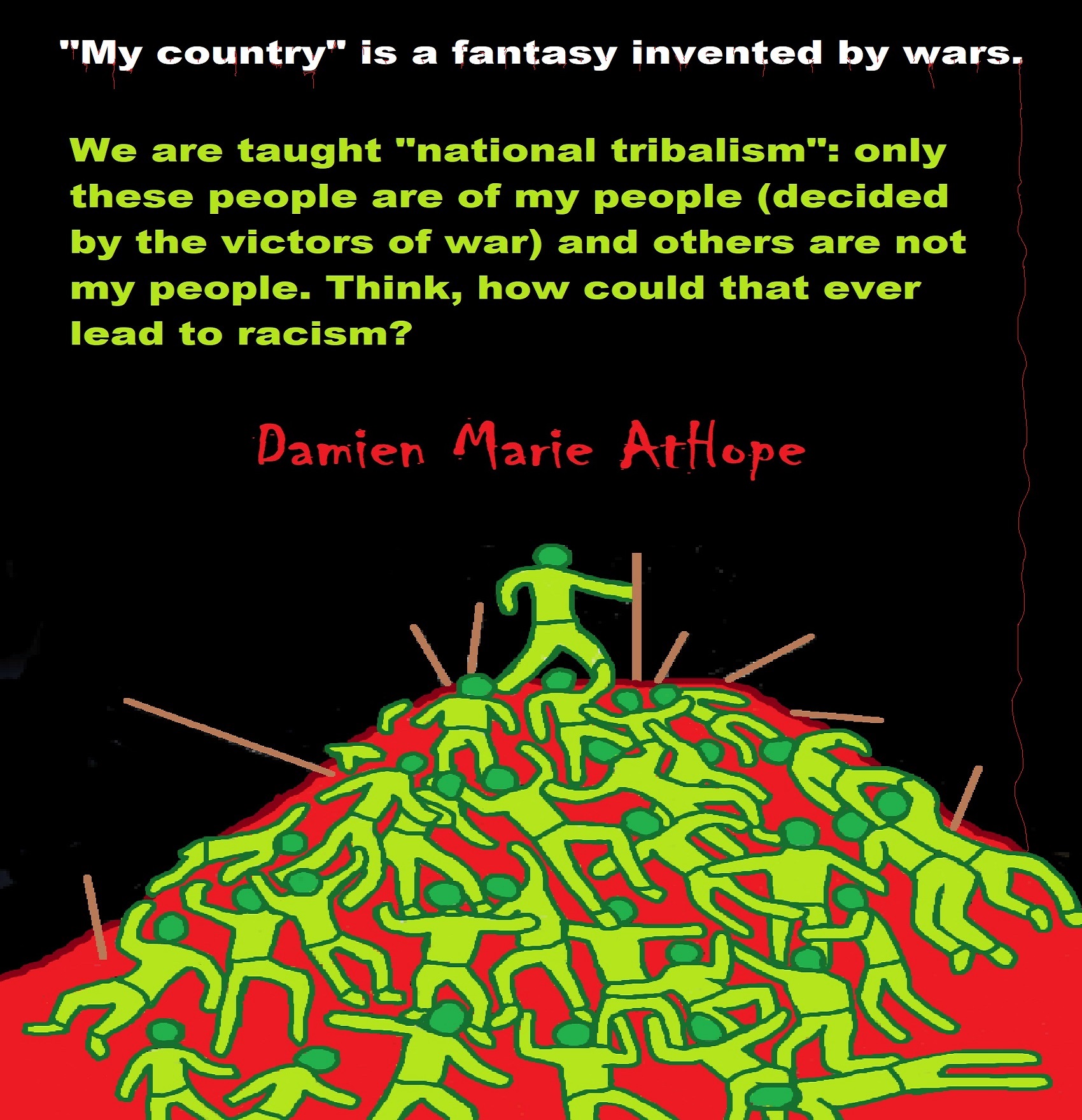


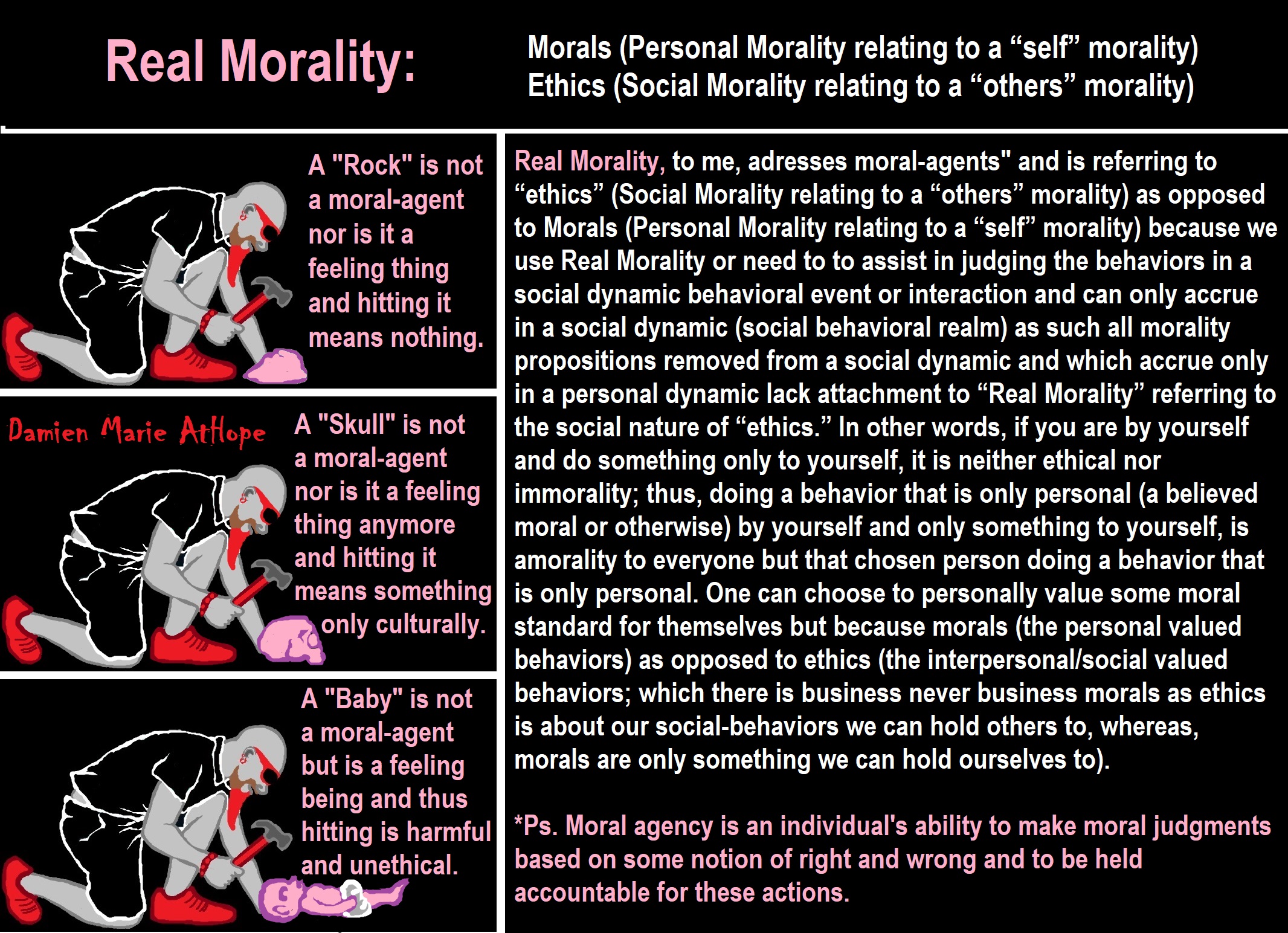

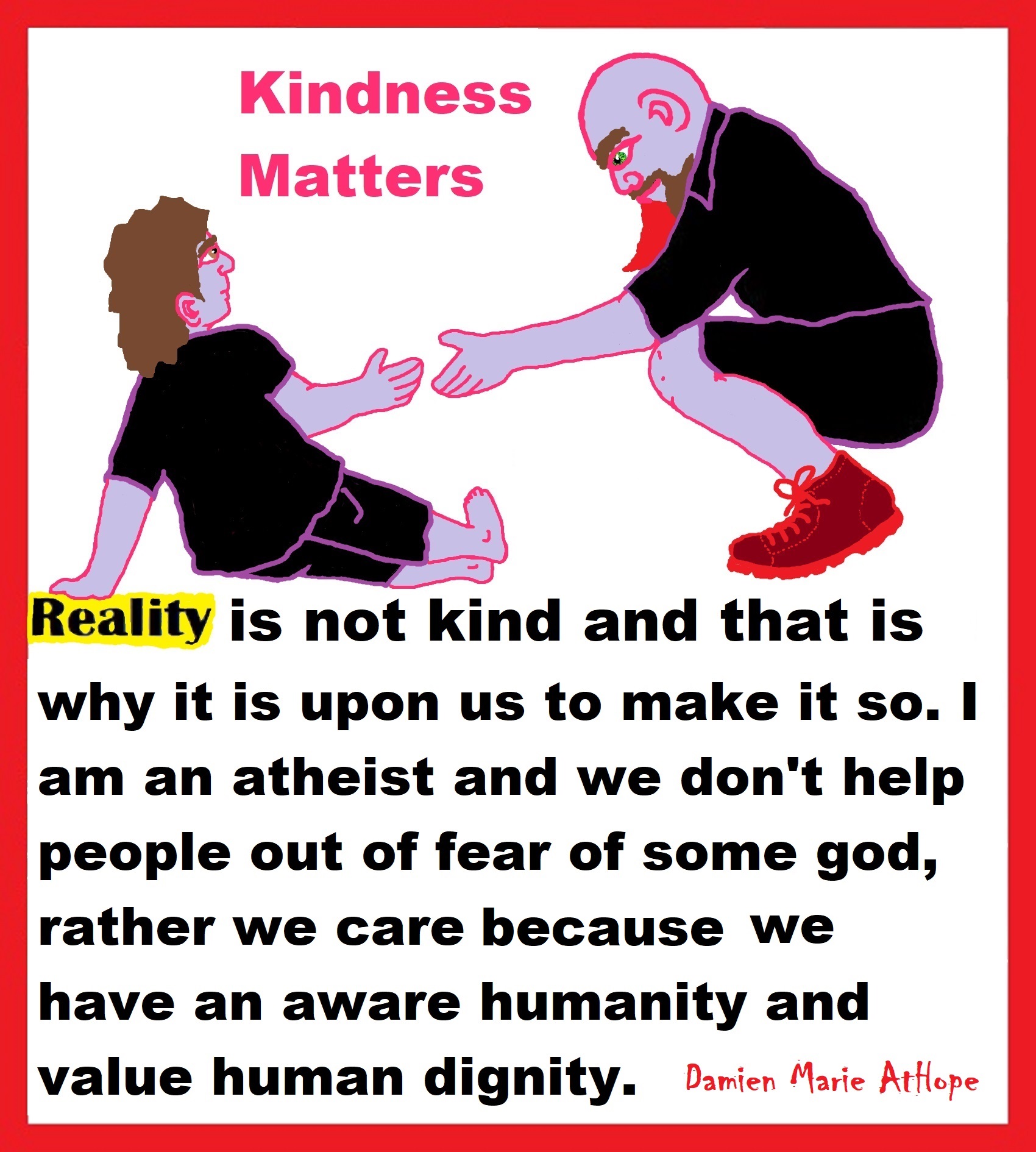
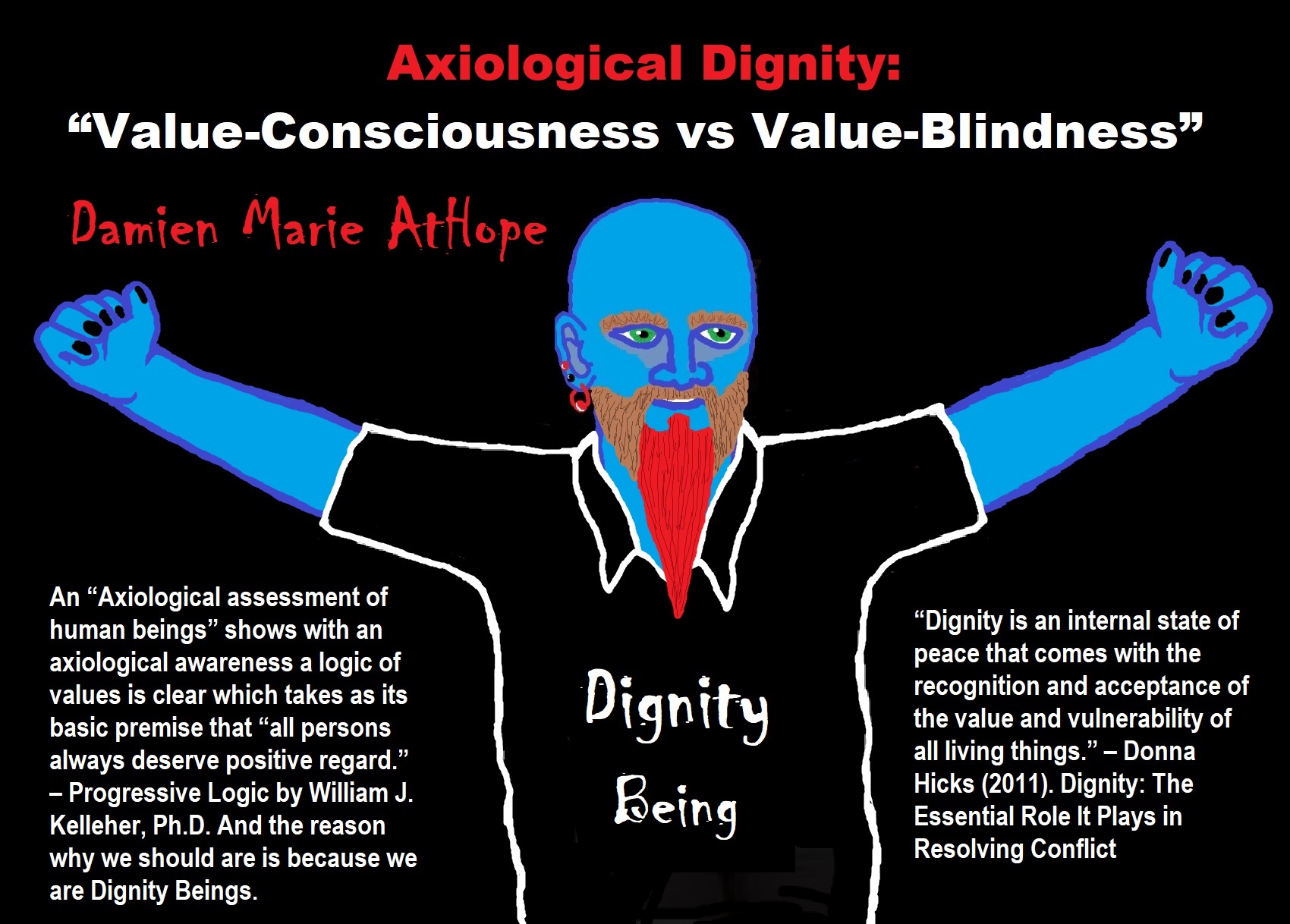
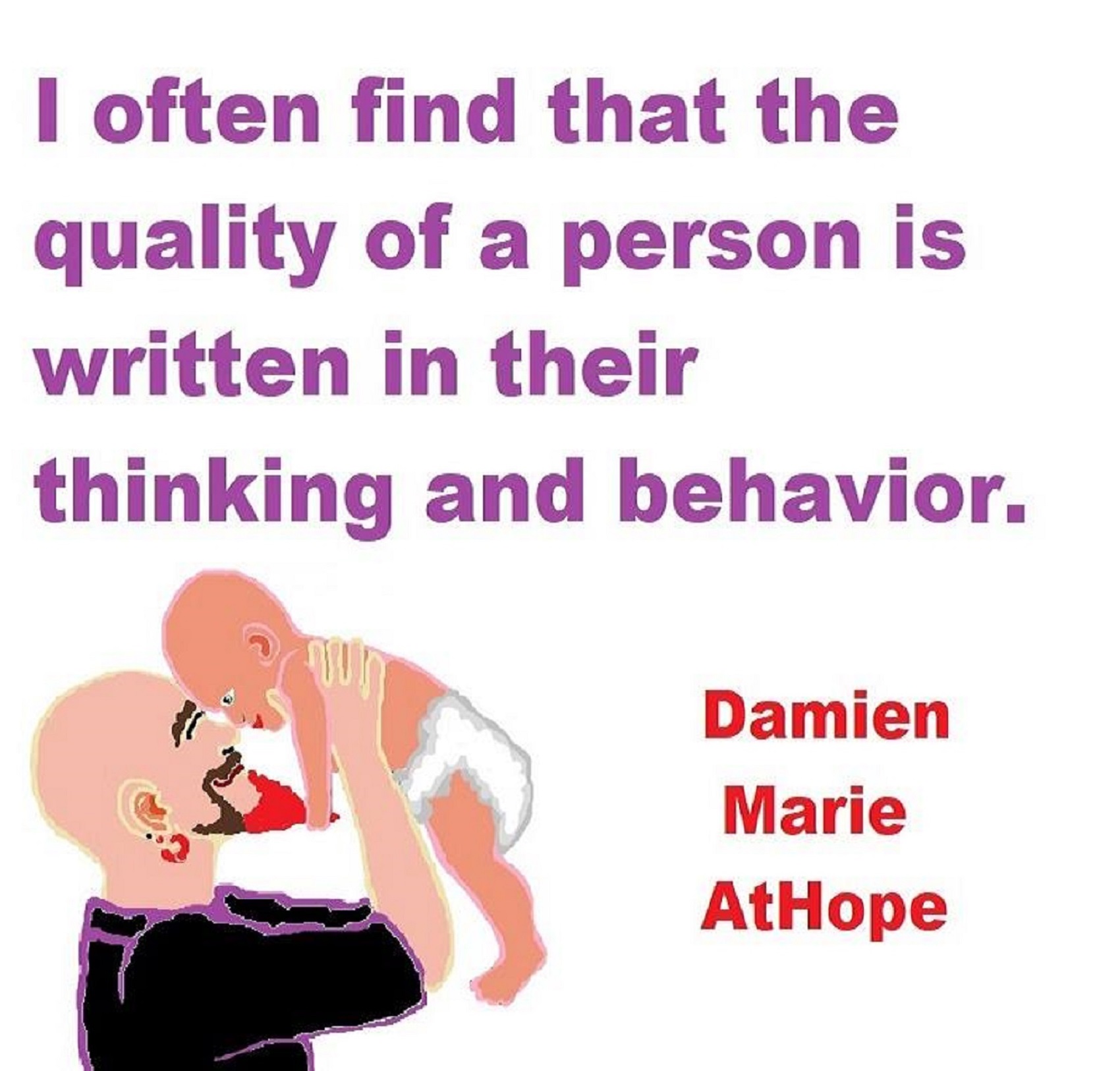
I am an anarcho-humanist (basically a socialist-collectivist-mutualist-anarchist as well as rather liberal, progressive, and revolutionary, I want all positive change)
You keep attacking activists and while you’re doing that, other activists and I will keep fighting for change. Sadly, you may change a few people where they lose their way in the momentum of activism. However, happily, while you’re doing that, other activists and I will help positively change the world. I hate when someone states anarchism is about not wanting to pay taxes, as if they don’t know the main persuasion of true anarchism is humanity is not selfishness, of “self-only concern” as in “i” language instead of “we” language of true anarchism is socialist anarchism that wishes to add us all in liberation of humanity from oppressors, as much as possible. With a general rationale of compassion and comradery with our fellow humans, who we know are all our fellow humans, sisters, brothers, and others are all equal beings of dignity in one human family. My anarchism is because of my care for humanity. I will leave selfishness for the capitalists where it belongs. I do not support sucker-punching people, even Nazis. To me, violence should be for self-defense or other-defense. I only hit those that try to hit me or others around me, I am for non-aggression.
What Inspires My Anarcho-Humanism:
- We are all one connected human family shown through DNA.
- No one owns the earth, it is coercive violent force or threat of force that makes people think otherwise.
- If you can’t trust people with freedom how can you trust them with power?
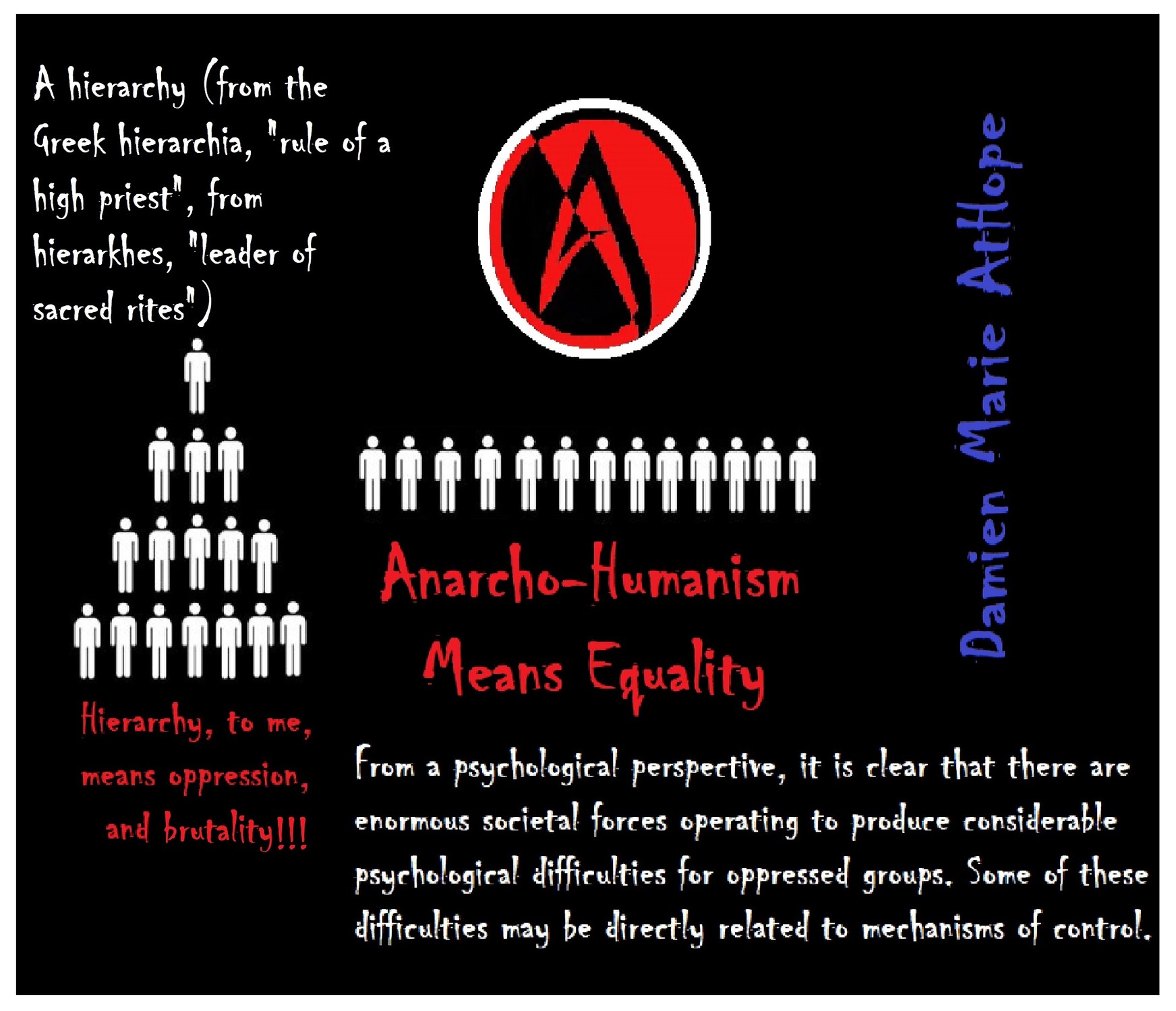

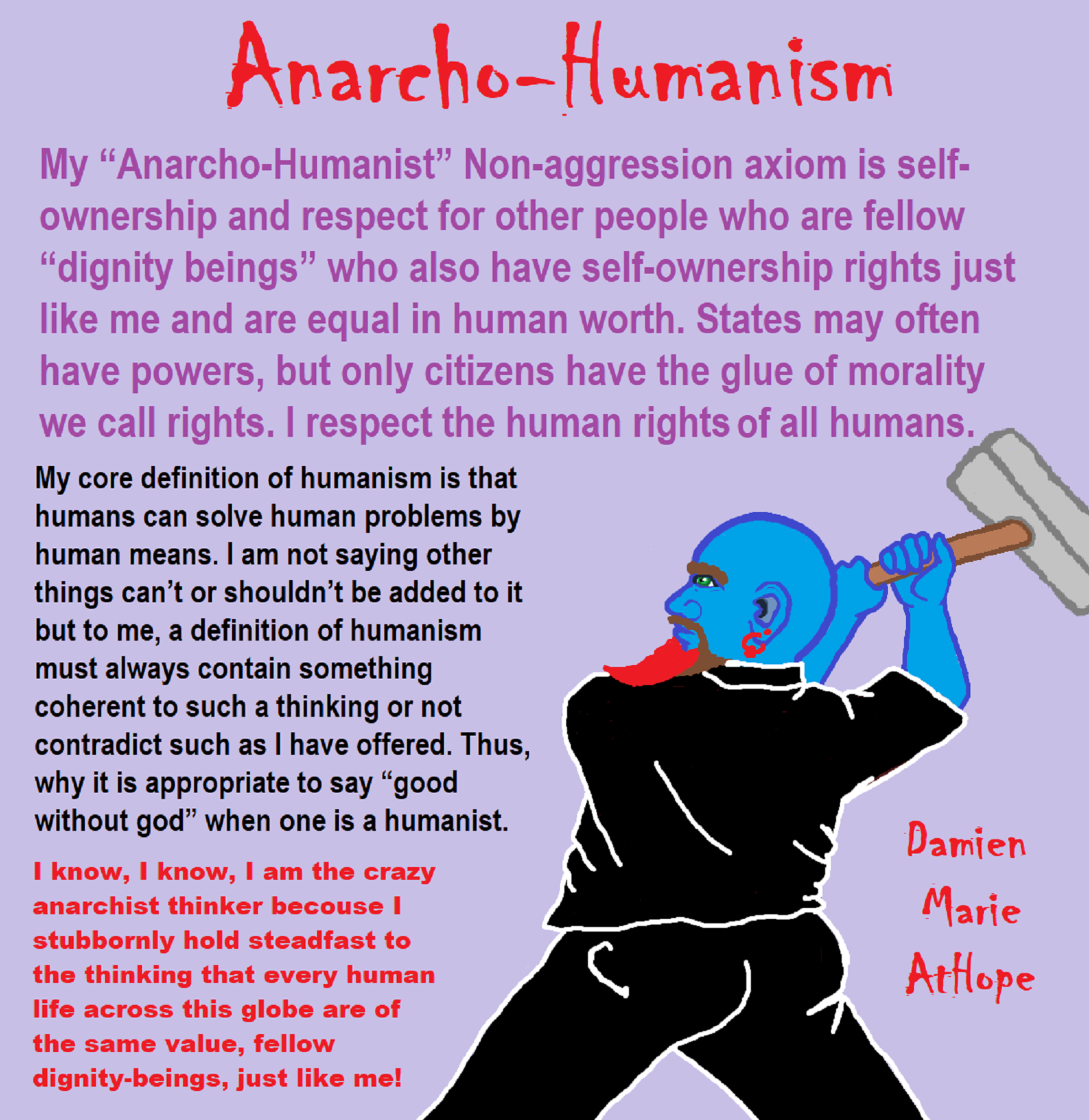
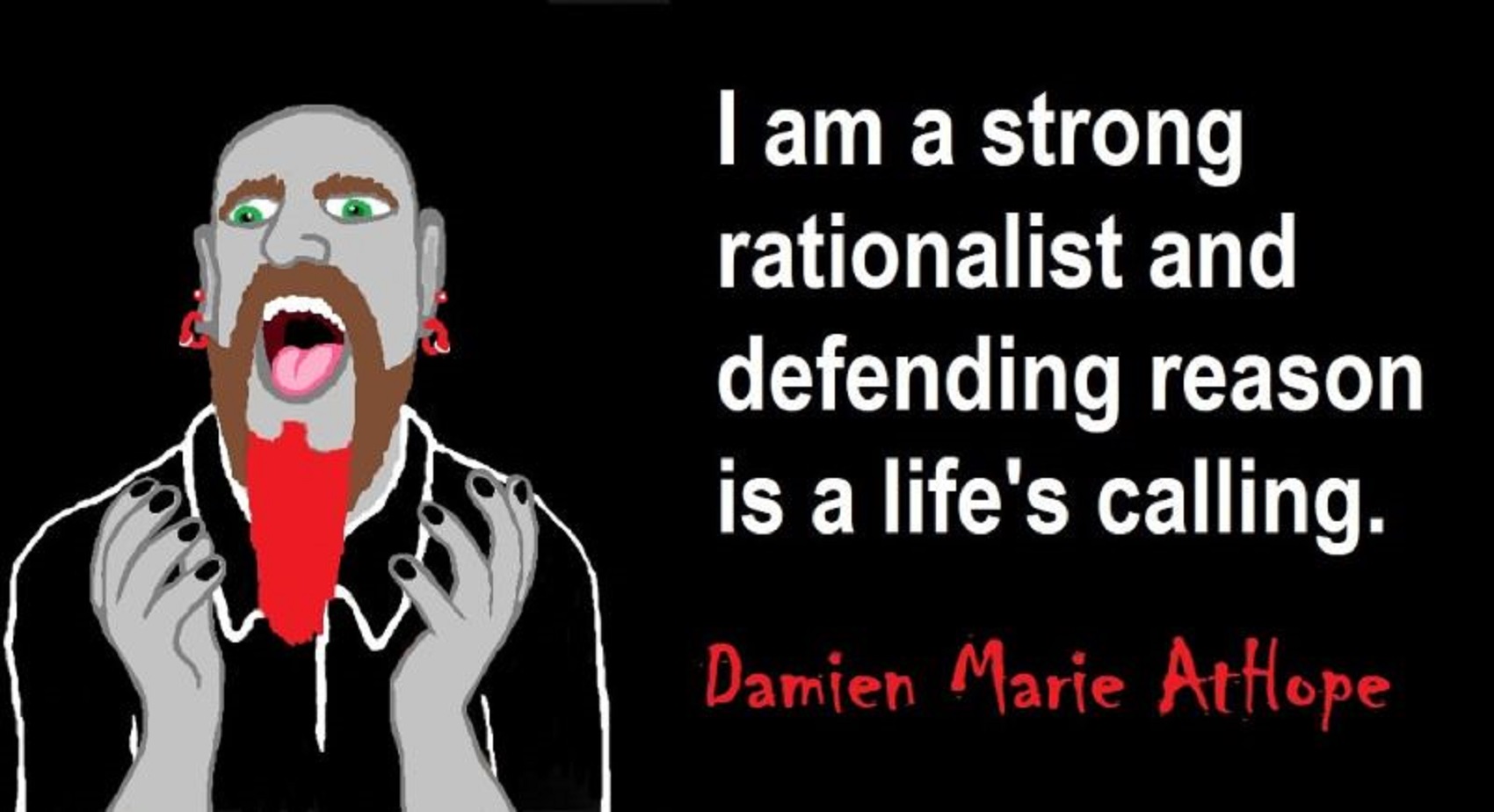

People don’t commonly teach religious history, even that of their own claimed religion. No, rather they teach a limited “pro their religion” history of their religion from a religious perspective favorable to the religion of choice.
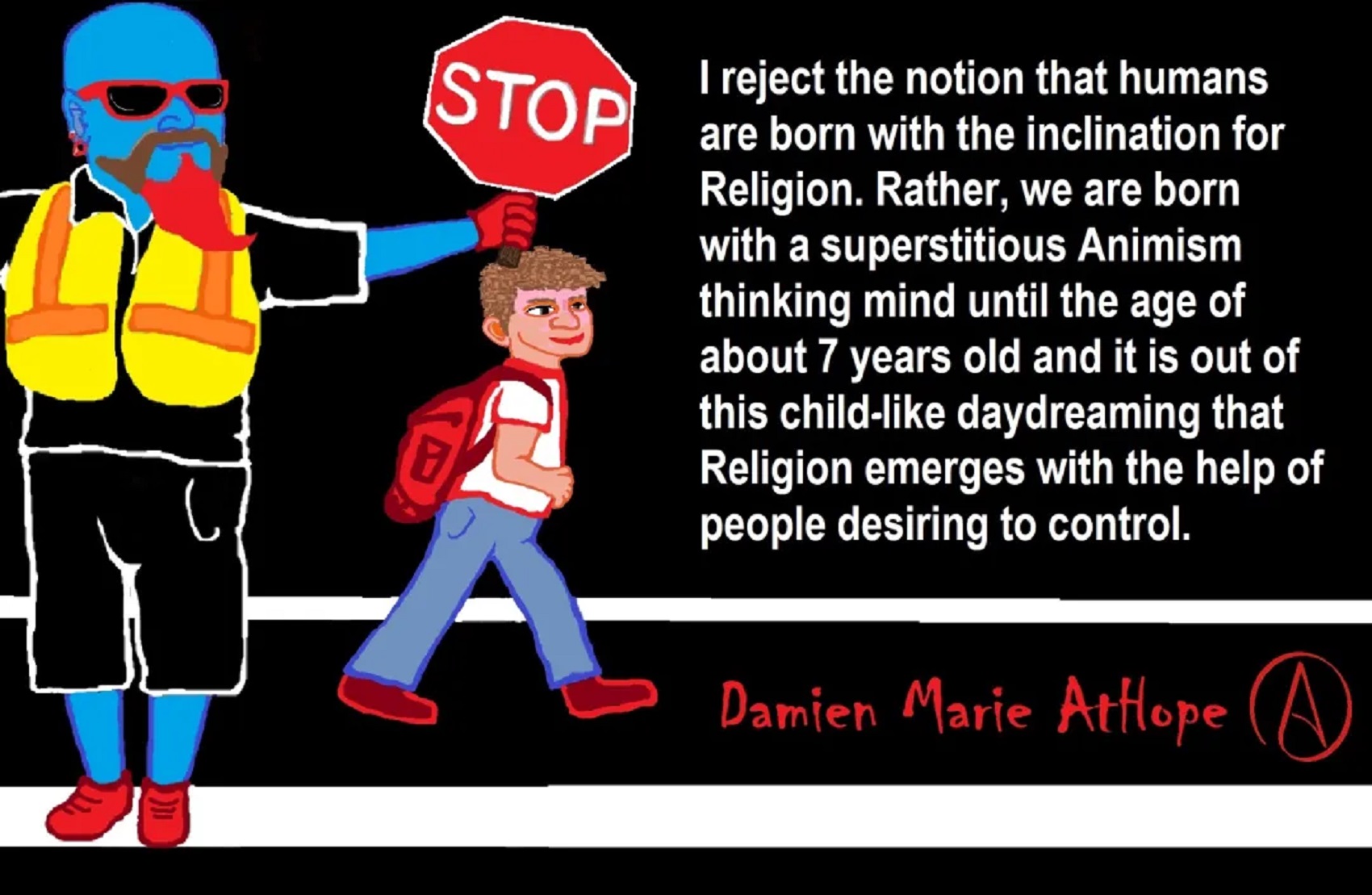
Do you truly think “Religious Belief” is only a matter of some personal choice?
Do you not see how coercive one’s world of choice is limited to the obvious hereditary belief, in most religious choices available to the child of religious parents or caregivers? Religion is more commonly like a family, culture, society, etc. available belief that limits the belief choices of the child and that is when “Religious Belief” is not only a matter of some personal choice and when it becomes hereditary faith, not because of the quality of its alleged facts or proposed truths but because everyone else important to the child believes similarly so they do as well simply mimicking authority beliefs handed to them. Because children are raised in religion rather than being presented all possible choices but rather one limited dogmatic brand of “Religious Belief” where children only have a choice of following the belief as instructed, and then personally claim the faith hereditary belief seen in the confirming to the belief they have held themselves all their lives. This is obvious in statements asked and answered by children claiming a faith they barely understand but they do understand that their family believes “this or that” faith, so they feel obligated to believe it too. While I do agree that “Religious Belief” should only be a matter of some personal choice, it rarely is… End Hereditary Religion!
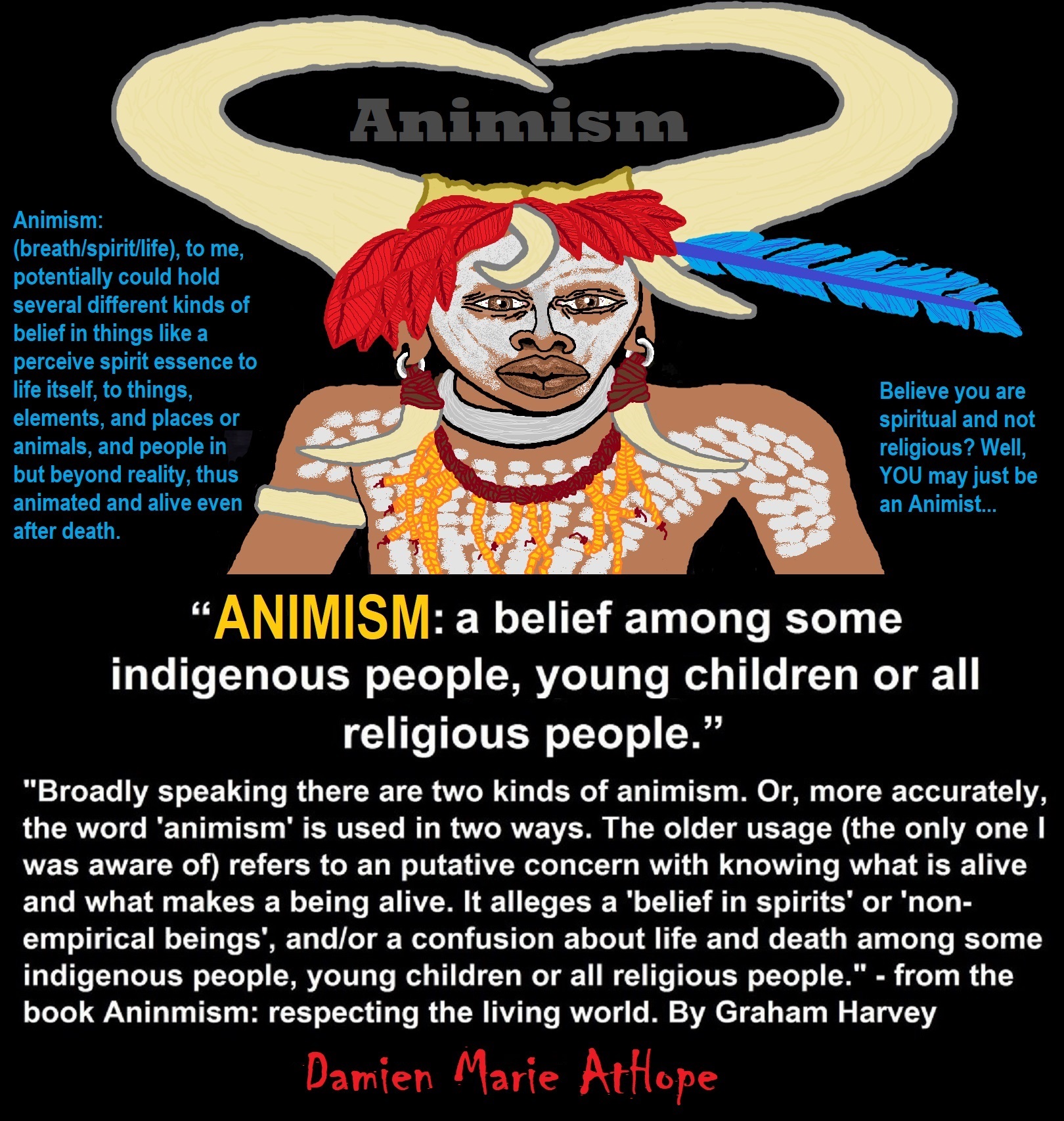
Animism: Respecting the Living World by Graham Harvey
“How have human cultures engaged with and thought about animals, plants, rocks, clouds, and other elements in their natural surroundings? Do animals and other natural objects have a spirit or soul? What is their relationship to humans? In this new study, Graham Harvey explores current and past animistic beliefs and practices of Native Americans, Maori, Aboriginal Australians, and eco-pagans. He considers the varieties of animism found in these cultures as well as their shared desire to live respectfully within larger natural communities. Drawing on his extensive casework, Harvey also considers the linguistic, performative, ecological, and activist implications of these different animisms.” ref
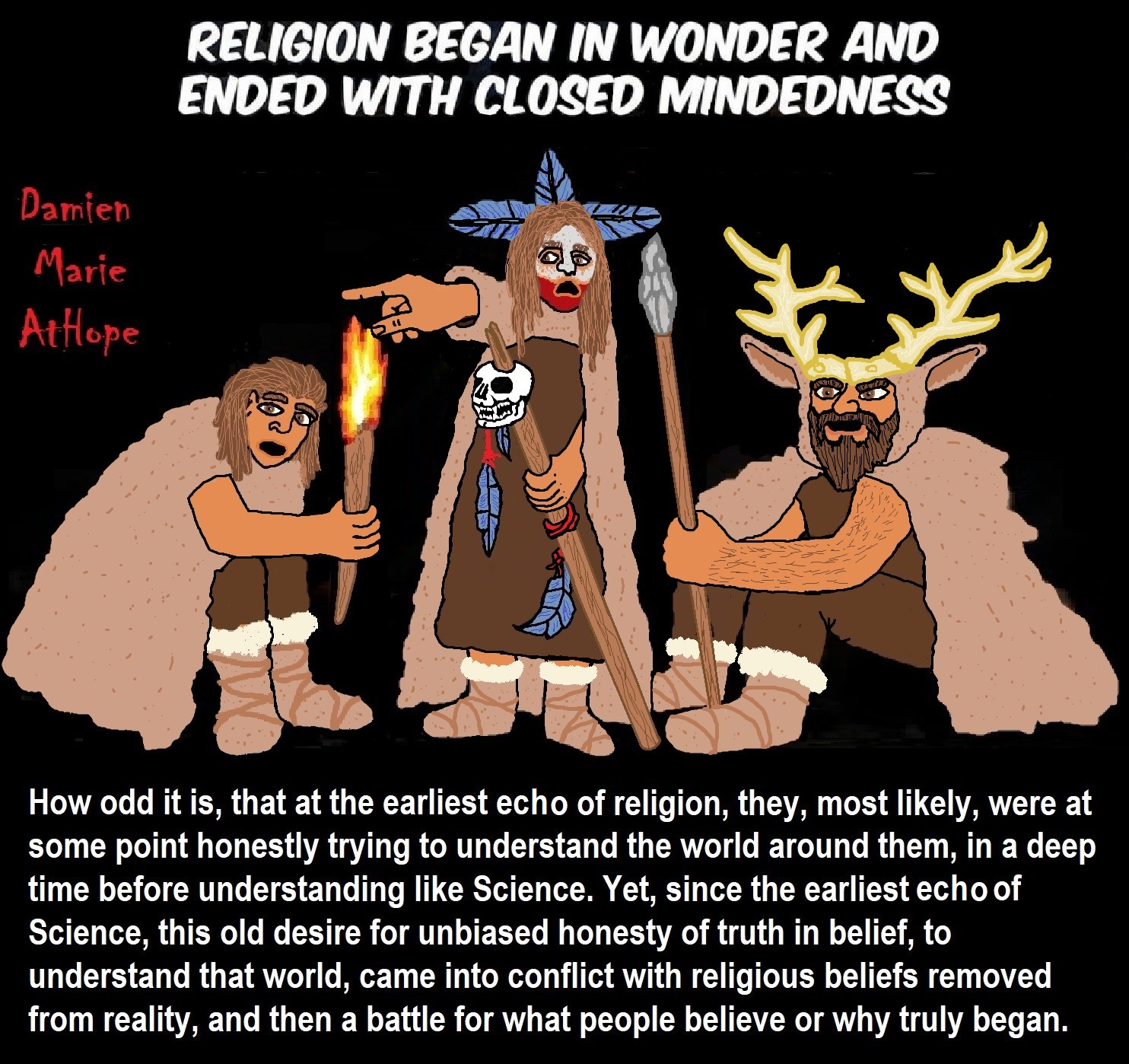
We are like believing machines we vacuum up ideas, like Velcro sticks to almost everything. We accumulate beliefs that we allow to negatively influence our lives, often without realizing it. Our willingness must be to alter skewed beliefs that impend our balance or reason, which allows us to achieve new positive thinking and accurate outcomes.
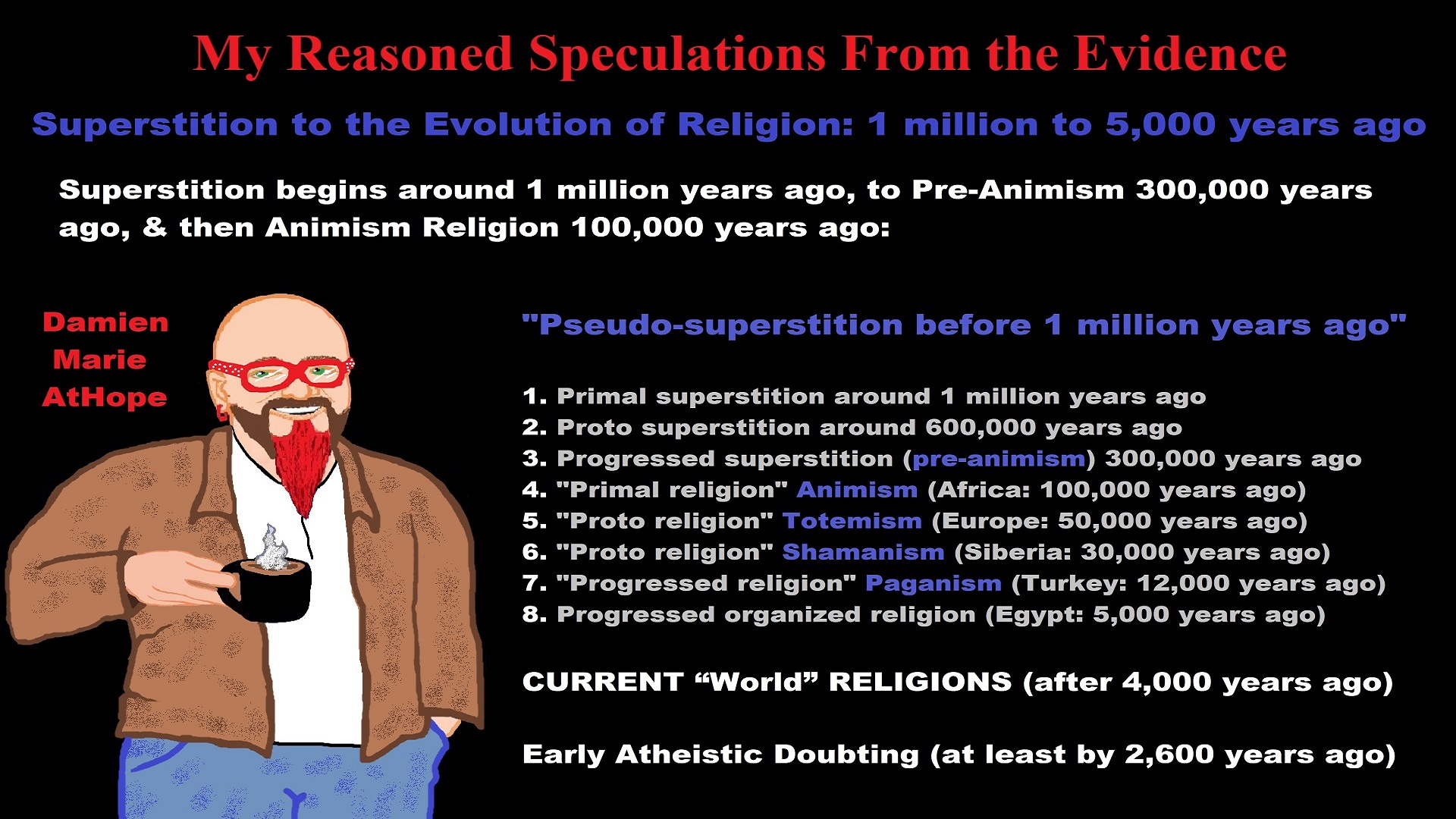
My thoughts on Religion Evolution with external links for more info:
- (Pre-Animism Africa mainly, but also Europe, and Asia at least 300,000 years ago), (Pre-Animism – Oxford Dictionaries)
- (Animism Africa around 100,000 years ago), (Animism – Britannica.com)
- (Totemism Europe around 50,000 years ago), (Totemism – Anthropology)
- (Shamanism Siberia around 30,000 years ago), (Shamanism – Britannica.com)
- (Paganism Turkey around 12,000 years ago), (Paganism – BBC Religion)
- (Progressed Organized Religion “Institutional Religion” Egypt around 5,000 years ago), (Ancient Egyptian Religion – Britannica.com)
- (CURRENT “World” RELIGIONS after 4,000 years ago) (Origin of Major Religions – Sacred Texts)
- (Early Atheistic Doubting at least by 2,600 years ago) (History of Atheism – Wikipedia)
“Religion is an Evolved Product” and Yes, Religion is Like Fear Given Wings…
Atheists talk about gods and religions for the same reason doctors talk about cancer, they are looking for a cure, or a firefighter talks about fires because they burn people and they care to stop them. We atheists too often feel a need to help the victims of mental slavery, held in the bondage that is the false beliefs of gods and the conspiracy theories of reality found in religions.
Understanding Religion Evolution:
- Pre-Animism (at least 300,000 years ago)
- Animism (Africa: 100,000 years ago)
- Totemism (Europe: 50,000 years ago)
- Shamanism (Siberia: 30,000 years ago)
- Paganism (Turkey: 12,000 years ago)
- Progressed organized religion (Egypt: 5,000 years ago), (Egypt, the First Dynasty 5,150 years ago)
- CURRENT “World” RELIGIONS (after 4,000 years ago)
- Early Atheistic Doubting (at least by 2,600 years ago)
“An Archaeological/Anthropological Understanding of Religion Evolution”
It seems ancient peoples had to survived amazing threats in a “dangerous universe (by superstition perceived as good and evil),” and human “immorality or imperfection of the soul” which was thought to affect the still living, leading to ancestor worship. This ancestor worship presumably led to the belief in supernatural beings, and then some of these were turned into the belief in gods. This feeble myth called gods were just a human conceived “made from nothing into something over and over, changing, again and again, taking on more as they evolve, all the while they are thought to be special,” but it is just supernatural animistic spirit-belief perceived as sacred.
Quick Evolution of Religion?
Pre-Animism (at least 300,000 years ago) pre-religion is a beginning that evolves into later Animism. So, Religion as we think of it, to me, all starts in a general way with Animism (Africa: 100,000 years ago) (theoretical belief in supernatural powers/spirits), then this is physically expressed in or with Totemism (Europe: 50,000 years ago) (theoretical belief in mythical relationship with powers/spirits through a totem item), which then enlists a full-time specific person to do this worship and believed interacting Shamanism (Siberia/Russia: 30,000 years ago) (theoretical belief in access and influence with spirits through ritual), and then there is the further employment of myths and gods added to all the above giving you Paganism (Turkey: 12,000 years ago) (often a lot more nature-based than most current top world religions, thus hinting to their close link to more ancient religious thinking it stems from). My hypothesis is expressed with an explanation of the building of a theatrical house (modern religions development). Progressed organized religion (Egypt: 5,000 years ago) with CURRENT “World” RELIGIONS (after 4,000 years ago).
Historically, in large city-state societies (such as Egypt or Iraq) starting around 5,000 years ago culminated to make religion something kind of new, a sociocultural-governmental-religious monarchy, where all or at least many of the people of such large city-state societies seem familiar with and committed to the existence of “religion” as the integrated life identity package of control dynamics with a fixed closed magical doctrine, but this juggernaut integrated religion identity package of Dogmatic-Propaganda certainly did not exist or if developed to an extent it was highly limited in most smaller prehistoric societies as they seem to lack most of the strong control dynamics with a fixed closed magical doctrine (magical beliefs could be at times be added or removed). Many people just want to see developed religious dynamics everywhere even if it is not. Instead, all that is found is largely fragments until the domestication of religion.
Religions, as we think of them today, are a new fad, even if they go back to around 6,000 years in the timeline of human existence, this amounts to almost nothing when seen in the long slow evolution of religion at least around 70,000 years ago with one of the oldest ritual worship. Stone Snake of South Africa: “first human worship” 70,000 years ago. This message of how religion and gods among them are clearly a man-made thing that was developed slowly as it was invented and then implemented peace by peace discrediting them all. Which seems to be a simple point some are just not grasping how devastating to any claims of truth when we can see the lie clearly in the archeological sites.
I wish people fought as hard for the actual values as they fight for the group/clan names political or otherwise they think support values. Every amount spent on war is theft to children in need of food or the homeless kept from shelter.
Here are several of my blog posts on history:
- To Find Truth You Must First Look
- (Magdalenian/Iberomaurusian) Connections to the First Paganists of the early Neolithic Near East Dating from around 17,000 to 12,000 Years Ago
- Natufians: an Ancient People at the Origins of Agriculture and Sedentary Life
- Possible Clan Leader/Special “MALE” Ancestor Totem Poles At Least 13,500 years ago?
- Jewish People with DNA at least 13,200 years old, Judaism, and the Origins of Some of its Ideas
- Baltic Reindeer Hunters: Swiderian, Lyngby, Ahrensburgian, and Krasnosillya cultures 12,020 to 11,020 years ago are evidence of powerful migratory waves during the last 13,000 years and a genetic link to Saami and the Finno-Ugric peoples.
- The Rise of Inequality: patriarchy and state hierarchy inequality
- Fertile Crescent 12,500 – 9,500 Years Ago: fertility and death cult belief system?
- 12,400 – 11,700 Years Ago – Kortik Tepe (Turkey) Pre/early-Agriculture Cultic Ritualism
- Ritualistic Bird Symbolism at Gobekli Tepe and its “Ancestor Cult”
- Male-Homosexual (female-like) / Trans-woman (female) Seated Figurine from Gobekli Tepe
- Could a 12,000-year-old Bull Geoglyph at Göbekli Tepe relate to older Bull and Female Art 25,000 years ago and Later Goddess and the Bull cults like Catal Huyuk?
- Sedentism and the Creation of goddesses around 12,000 years ago as well as male gods after 7,000 years ago.
- Alcohol, where Agriculture and Religion Become one? Such as Gobekli Tepe’s Ritualistic use of Grain as Food and Ritual Drink
- Neolithic Ritual Sites with T-Pillars and other Cultic Pillars
- Paganism: Goddesses around 12,000 years ago then Male Gods after 7,000 years ago
- First Patriarchy: Split of Women’s Status around 12,000 years ago & First Hierarchy: fall of Women’s Status around 5,000 years ago.
- Natufians: an Ancient People at the Origins of Agriculture and Sedentary Life
- J DNA and the Spread of Agricultural Religion (paganism)
- Paganism: an approximately 12,000-year-old belief system
- Paganism 12,000 years old: related to “Anarchism and Socialism” (Pre-Capitalism)
- Shaman burial in Israel 12,000 years ago and the Shamanism Phenomena
- Need to Mythicized: gods and goddesses
- 12,000 – 7,000 Years Ago – Paleo-Indian Culture (The Americas)
- 12,000 – 2,000 Years Ago – Indigenous-Scandinavians (Nordic)
- Norse did not wear helmets with horns?
- Pre-Pottery Neolithic Skull Cult around 11,500 to 8,400 Years Ago?
- 10,400 – 10,100 Years Ago, in Turkey the Nevail Cori Religious Settlement
- 9,000-6,500 Years Old Submerged Pre-Pottery/Pottery Neolithic Ritual Settlements off Israel’s Coast
- Catal Huyuk “first religious designed city” around 9,500 to 7,700 years ago (Turkey)
- Cultic Hunting at Catal Huyuk “first religious designed city”
- Special Items and Art as well as Special Elite Burials at Catal Huyuk
- New Rituals and Violence with the appearance of Pottery and People?
- Haplogroup N and its related Uralic Languages and Cultures
- Ainu people, Sámi people, Native Americans, the Ancient North Eurasians, and Paganistic-Shamanism with Totemism
- Ideas, Technology and People from Turkey, Europe, to China and Back again 9,000 to 5,000 years ago?
- First Pottery of Europe and the Related Cultures
- 9,000 years old Neolithic Artifacts Judean Desert and Hills Israel
- 9,000-7,000 years-old Sex and Death Rituals: Cult Sites in Israel, Jordan, and the Sinai
- 9,000-8500 year old Horned Female shaman Bad Dürrenberg Germany
- Neolithic Jewelry and the Spread of Farming in Europe Emerging out of West Turkey
- 8,600-year-old Tortoise Shells in Neolithic graves in central China have Early Writing and Shamanism
- Swing of the Mace: the rise of Elite, Forced Authority, and Inequality begin to Emerge 8,500 years ago?
- Migrations and Changing Europeans Beginning around 8,000 Years Ago
- My “Steppe-Anatolian-Kurgan hypothesis” 8,000/7,000 years ago
- Around 8,000-year-old Shared Idea of the Mistress of Animals, “Ritual” Motif
- Pre-Columbian Red-Paint (red ochre) Maritime Archaic Culture 8,000-3,000 years ago
- 7,522-6,522 years ago Linear Pottery culture which I think relates to Arcane Capitalism’s origins
- Arcane Capitalism: Primitive socialism, Primitive capital, Private ownership, Means of production, Market capitalism, Class discrimination, and Petite bourgeoisie (smaller capitalists)
- 7,500-4,750 years old Ritualistic Cucuteni-Trypillian culture of Moldova, Romania, and Ukraine
- Roots of a changing early society 7,200-6,700 years ago Jordan and Israel
- Agriculture religion (Paganism) with farming reached Britain between about 7,000 to 6,500 or so years ago and seemingly expressed in things like Western Europe’s Long Barrows
- My Thoughts on Possible Migrations of “R” DNA and Proto-Indo-European?
- “Millet” Spreading from China 7,022 years ago to Europe and related Language may have Spread with it leading to Proto-Indo-European
- Proto-Indo-European (PIE), ancestor of Indo-European languages: DNA, Society, Language, and Mythology
- The Dnieper–Donets culture and Asian varieties of Millet from China to the Black Sea region of Europe by 7,022 years ago
- Kurgan 6,000 years ago/dolmens 7,000 years ago: funeral, ritual, and other?
- 7,020 to 6,020-year-old Proto-Indo-European Homeland of Urheimat or proposed home of their Language and Religion
- Ancient Megaliths: Kurgan, Ziggurat, Pyramid, Menhir, Trilithon, Dolman, Kromlech, and Kromlech of Trilithons
- The Mytheme of Ancient North Eurasian Sacred-Dog belief and similar motifs are found in Indo-European, Native American, and Siberian comparative mythology
- Elite Power Accumulation: Ancient Trade, Tokens, Writing, Wealth, Merchants, and Priest-Kings
- Sacred Mounds, Mountains, Kurgans, and Pyramids may hold deep connections?
- Between 7,000-5,000 Years ago, rise of unequal hierarchy elite, leading to a “birth of the State” or worship of power, strong new sexism, oppression of non-elites, and the fall of Women’s equal status
- Paganism 7,000-5,000 years old: related to “Anarchism and Socialism” (Capitalism) (World War 0) Elite & their slaves
- Hell and Underworld mythologies starting maybe as far back as 7,000 to 5,000 years ago with the Proto-Indo-Europeans?
- The First Expression of the Male God around 7,000 years ago?
- White (light complexion skin) Bigotry and Sexism started 7,000 years ago?
- Around 7,000-year-old Shared Idea of the Divine Bird (Tutelary and/or Trickster spirit/deity), “Ritual” Motif
- Nekhbet an Ancient Egyptian Vulture Goddess and Tutelary Deity
- 6,720 to 4,920 years old Ritualistic Hongshan Culture of Inner Mongolia with 5,000-year-old Pyramid Mounds and Temples
- First proto-king in the Balkans, Varna culture around 6,500 years ago?
- 6,500–5,800 years ago in Israel Late Chalcolithic (Copper Age) Period in the Southern Levant Seems to Express Northern Levant Migrations, Cultural and Religious Transfer
- KING OF BEASTS: Master of Animals “Ritual” Motif, around 6,000 years old or older…
- Around 6000-year-old Shared Idea of the Solid Wheel & the Spoked Wheel-Shaped Ritual Motif
- “The Ghassulian Star,” a mysterious 6,000-year-old mural from Jordan; a Proto-Star of Ishtar, Star of Inanna or Star of Venus?
- Religious/Ritual Ideas, including goddesses and gods as well as ritual mounds or pyramids from Northeastern Asia at least 6,000 years old, seemingly filtering to Iran, Iraq, the Mediterranean, Europe, Egypt, and the Americas?
- Maykop (5,720–5,020 years ago) Caucasus region Bronze Age culture-related to Copper Age farmers from the south, influenced by the Ubaid period and Leyla-Tepe culture, as well as influencing the Kura-Araxes culture
- 5-600-year-old Tomb, Mummy, and First Bearded Male Figurine in a Grave
- Kura-Araxes Cultural 5,520 to 4,470 years old DNA traces to the Canaanites, Arabs, and Jews
- Minoan/Cretan (Keftiu) Civilization and Religion around 5,520 to 3,120 years ago
- Evolution Of Science at least by 5,500 years ago
- 5,500 Years old birth of the State, the rise of Hierarchy, and the fall of Women’s status
- “Jiroft culture” 5,100 – 4,200 years ago and the History of Iran
- Stonehenge: Paganistic Burial and Astrological Ritual Complex, England (5,100-3,600 years ago)
- Around 5,000-year-old Shared Idea of the “Tree of Life” Ritual Motif
- Complex rituals for elite, seen from China to Egypt, at least by 5,000 years ago
- Around 5,000 years ago: “Birth of the State” where Religion gets Military Power and Influence
- The Center of the World “Axis Mundi” and/or “Sacred Mountains” Mythology Could Relate to the Altai Mountains, Heart of the Steppe
- Progressed organized religion starts, an approximately 5,000-year-old belief system
- China’s Civilization between 5,000-3,000 years ago, was a time of war and class struggle, violent transition from free clans to a Slave or Elite society
- Origin of Logics is Naturalistic Observation at least by around 5,000 years ago.
- Paganism 5,000 years old: progressed organized religion and the state: related to “Anarchism and Socialism” (Kings and the Rise of the State)
- Ziggurats (multi-platform temples: 4,900 years old) to Pyramids (multi-platform tombs: 4,700 years old)
- Did a 4,520–4,420-year-old Volcano In Turkey Inspire the Bible God?
- Finland’s Horned Shaman and Pre-Horned-God at least 4,500 years ago?
- 4,000-year-Old Dolmens in Israel: A Connected Dolmen Religious Phenomenon?
- Creation myths: From chaos, Ex nihilo, Earth-diver, Emergence, World egg, and World parent
- Bronze Age “Ritual” connections of the Bell Beaker culture with the Corded Ware/Single Grave culture, which were related to the Yamnaya culture and Proto-Indo-European Languages/Religions
- Low Gods (Earth/ Tutelary deity), High Gods (Sky/Supreme deity), and Moralistic Gods (Deity enforcement/divine order)
- The exchange of people, ideas, and material-culture including, to me, the new god (Sky Father) and goddess (Earth Mother) religion between the Cucuteni-Trypillians and others which is then spread far and wide
- Koryaks: Indigenous People of the Russian Far East and Big Raven myths also found in Tlingit, Haida, Tsimshian, and other Indigenous People of North America
- 42 Principles Of Maat (Egyptian Goddess of the justice) around 4,400 years ago, 2000 Years Before Ten Commandments
- “Happy Easter” Well Happy Eostre/Ishter
- 4,320-3,820 years old “Shimao” (North China) site with Totemistic-Shamanistic Paganism and a Stepped Pyramid
- 4,250 to 3,400 Year old Stonehenge from Russia: Arkaim?
- 4,100-year-old beaker with medicinal & flowering plants in a grave of a woman in Scotland
- Early European Farmer ancestry, Kelif el Boroud people with the Cardial Ware culture, and the Bell Beaker culture Paganists too, spread into North Africa, then to the Canary Islands off West Africa
- Flood Accounts: Gilgamesh epic (4,100 years ago) Noah in Genesis (2,600 years ago)
- Paganism 4,000 years old: related to “Anarchism and Socialism” (First Moralistic gods, then the Origin time of Monotheism)
- When was the beginning: TIMELINE OF CURRENT RELIGIONS, which start around 4,000 years ago.
- Early Religions Thought to Express Proto-Monotheistic Systems around 4,000 years ago
- Kultepe? An archaeological site with a 4,000 years old women’s rights document.
- Single God Religions (Monotheism) = “Man-o-theism” started around 4,000 years ago with the Great Sky Spirit/God Tiān (天)?
- Confucianism’s Tiān (Shangdi god 4,000 years old): Supernaturalism, Pantheism or Theism?
- Yes, Your Male God is Ridiculous
- Mythology, a Lunar Deity is a Goddess or God of the Moon
- Sacred Land, Hills, and Mountains: Sami Mythology (Paganistic Shamanism)
- Horse Worship/Sacrifice: mythical union of Ruling Elite/Kingship and the Horse
- The Amorite/Amurru people’s God Amurru “Lord of the Steppe”, relates to the Origins of the Bible God?
- Bronze Age Exotic Trade Routes Spread Quite Far as well as Spread Religious Ideas with Them
- Sami and the Northern Indigenous Peoples Landscape, Language, and its Connection to Religion
- Prototype of Ancient Analemmatic Sundials around 3,900-3,150 years ago and a Possible Solar Connection to gods?
- Judaism is around 3,450 or 3,250 years old. (“Paleo-Hebrew” 3,000 years ago and Torah 2,500 years ago)
- The Weakening of Ancient Trade and the Strengthening of Religions around 3000 years ago?
- Are you aware that there are religions that worship women gods, explain now religion tears women down?
- Animistic, Totemistic, and Paganistic Superstition Origins of bible god and the bible’s Religion.
- Myths and Folklore: “Trickster gods and goddesses”
- Jews, Judaism, and the Origins of Some of its Ideas
- An Old Branch of Religion Still Giving Fruit: Sacred Trees
- Dating the BIBLE: naming names and telling times (written less than 3,000 years ago, provable to 2,200 years ago)
- Did a Volcano Inspire the bible god?
- Dené–Yeniseian language, Old Copper Complex, and Pre-Columbian Mound Builders?
- No “dinosaurs and humans didn’t exist together just because some think they are in the bible itself”
- Sacred Shit and Sacred Animals?
- Everyone Killed in the Bible Flood? “Nephilim” (giants)?
- Hey, Damien dude, I have a question for you regarding “the bible” Exodus.
- Archaeology Disproves the Bible
- Bible Battle, Just More, Bible Babble
- The Jericho Conquest lie?
- Canaanites and Israelites?
- Accurate Account on how did Christianity Began?
- Let’s talk about Christianity.
- So the 10 commandments isn’t anything to go by either right?
- Misinformed christian
- Debunking Jesus?
- Paulism vs Jesus
- Ok, you seem confused so let’s talk about Buddhism.
- Unacknowledged Buddhism: Gods, Savior, Demons, Rebirth, Heavens, Hells, and Terrorism
- His Foolishness The Dalai Lama
- Yin and Yang is sexist with an ORIGIN around 2,300 years ago?
- I Believe Archaeology, not Myths & Why Not, as the Religious Myths Already Violate Reason!
- Archaeological, Scientific, & Philosophic evidence shows the god myth is man-made nonsense.
- Aquatic Ape Theory/Hypothesis? As Always, Just Pseudoscience.
- Ancient Aliens Conspiracy Theorists are Pseudohistorians
- The Pseudohistoric and Pseudoscientific claims about “Bakoni Ruins” of South Africa
- Why do people think Religion is much more than supernaturalism and superstitionism?
- Religion is an Evolved Product
- Was the Value of Ancient Women Different?
- 1000 to 1100 CE, human sacrifice Cahokia Mounds a pre-Columbian Native American site
- Feminist atheists as far back as the 1800s?
- Promoting Religion as Real is Mentally Harmful to a Flourishing Humanity
- Screw All Religions and Their Toxic lies, they are all fraud
- Forget Religions’ Unfounded Myths, I Have Substantiated “Archaeology Facts.”
- Religion Dispersal throughout the World
- I Hate Religion Just as I Hate all Pseudoscience
- Exposing Scientology, Eckankar, Wicca and Other Nonsense?
- Main deity or religious belief systems
- Quit Trying to Invent Your God From the Scraps of Science.
- Archaeological, Scientific, & Philosophic evidence shows the god myth is man-made nonsense.
- Ancient Alien Conspiracy Theorists: Misunderstanding, Rhetoric, Misinformation, Fabrications, and Lies
- Misinformation, Distortion, and Pseudoscience in Talking with a Christian Creationist
- Judging the Lack of Goodness in Gods, Even the Norse God Odin
- Challenging the Belief in God-like Aliens and Gods in General
- A Challenge to Christian use of Torture Devices?
- Yes, Hinduism is a Religion
- Trump is One of the Most Reactionary Forces of Far-right Christian Extremism
- Was the Bull Head a Symbol of God? Yes!
- Primate Death Rituals
- Christian – “God and Christianity are objectively true”
- Australopithecus afarensis Death Ritual?
- You Claim Global Warming is a Hoax?
- Doubter of Science and Defamer of Atheists?
- I think that sounds like the Bible?
- History of the Antifa (“anti-fascist”) Movements
- Indianapolis Anti-Blasphemy Laws #Free Soheil Rally
- Damien, you repeat the golden rule in so many forms then you say religion is dogmatic?
- Science is a Trustable Methodology whereas Faith is not Trustable at all!
- Was I ever a believer, before I was an atheist?
- Atheists rise in reason
- Mistrust of science?
- Open to Talking About the Definition of ‘God’? But first, we address Faith.
- ‘United Monarchy’ full of splendor and power – Saul, David, and Solomon? Most likely not.
- Is there EXODUS ARCHAEOLOGY? The short answer is “no.”
- Lacking Proof of Bigfoots, Unicorns, and Gods is Just a Lack of Research?
- Religion and Politics: Faith Beliefs vs. Rational Thinking
- Hammer of Truth that lying pig RELIGION: challenged by an archaeologist
- “The Hammer of Truth” -ontology question- What do You Mean by That?
- Navigation of a bad argument: Ad Hominem vs. Attack
- Why is it Often Claimed that Gods have a Gender?
- Why are basically all monotheistic religions ones that have a male god?
- Shifting through the Claims in support of Faith
- Dear Mr. AtHope, The 20th Century is an Indictment of Secularism and a Failed Atheist Century
- An Understanding of the Worldwide Statistics and Dynamics of Terrorist Incidents and Suicide Attacks
- Intoxication and Evolution? Addressing and Assessing the “Stoned Ape” or “Drunken Monkey” Theories as Catalysts in Human Evolution
- Sacred Menstrual cloth? Inanna’s knot, Isis knot, and maybe Ma’at’s feather?
- Damien, why don’t the Hebrews accept the bible stories?
- Dealing with a Troll and Arguing Over Word Meaning
- Knowledge without Belief? Justified beliefs or disbeliefs worthy of Knowledge?
- Afrocentrism and African Religions
- Crecganford @crecganford offers history & stories of the people, places, gods, & culture
- Empiricism-Denier?
I am not an academic. I am a revolutionary that teaches in public, in places like social media, and in the streets. I am not a leader by some title given but from my commanding leadership style of simply to start teaching everywhere to everyone, all manner of positive education.
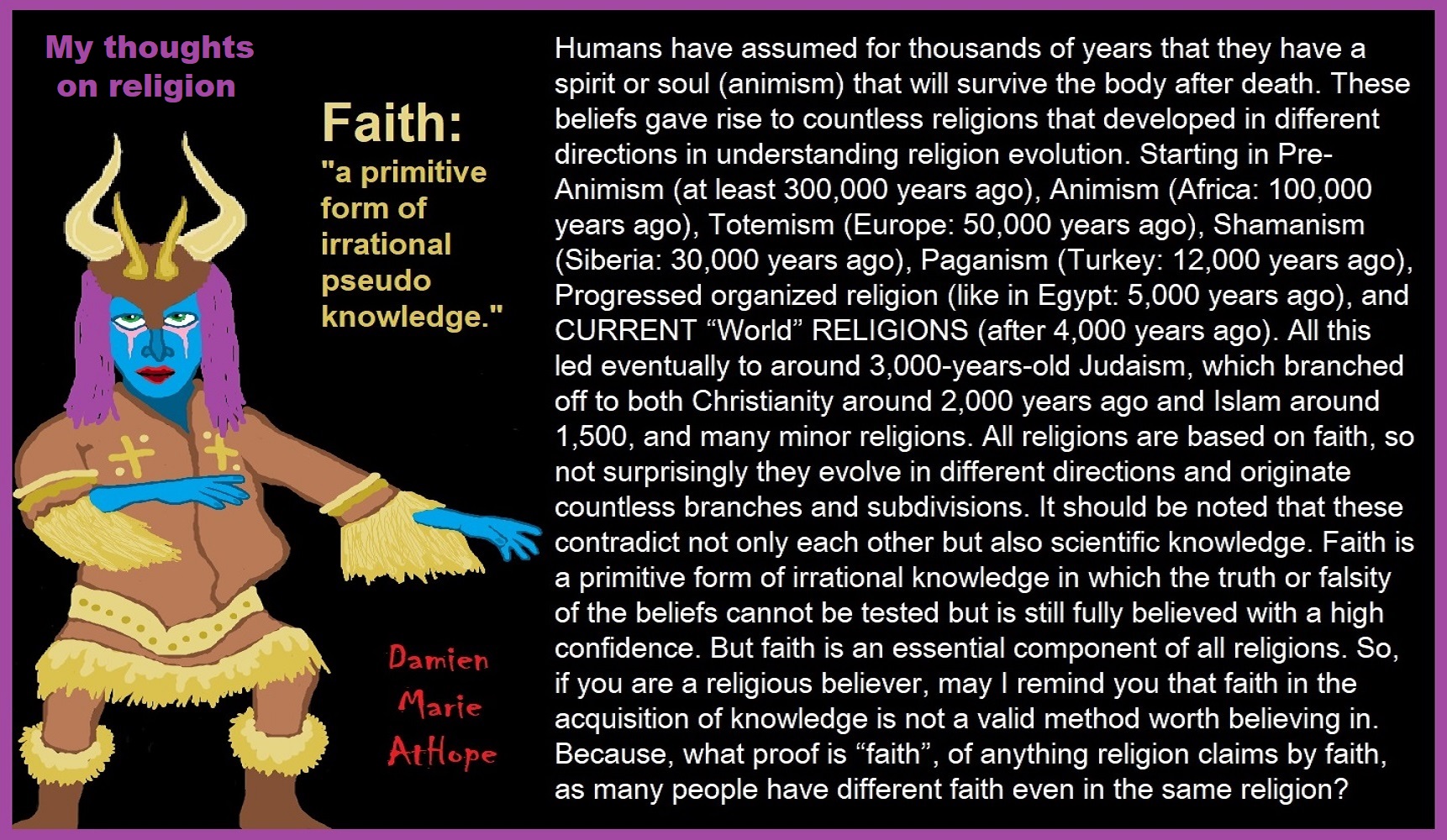

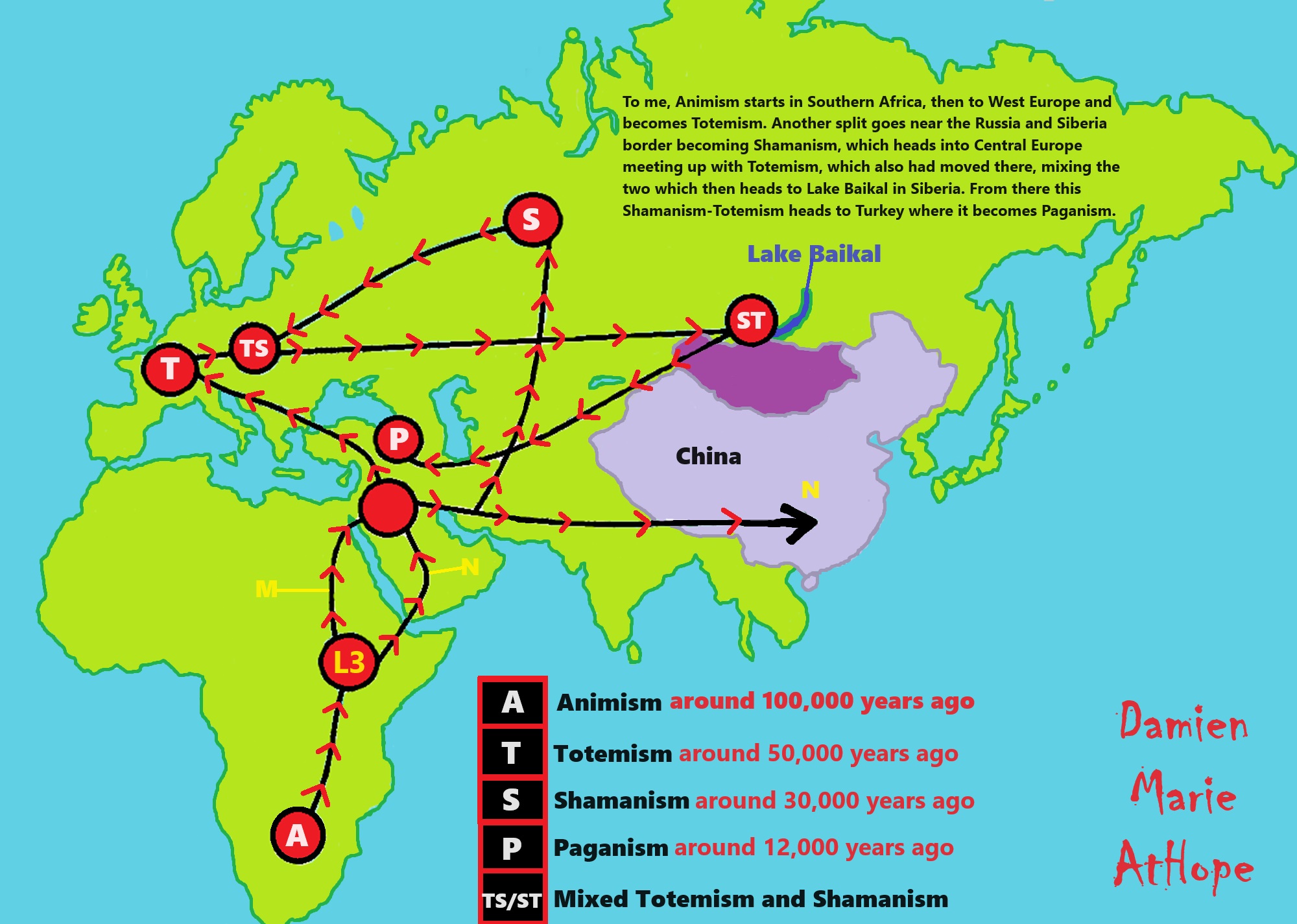
To me, Animism starts in Southern Africa, then to West Europe, and becomes Totemism. Another split goes near the Russia and Siberia border becoming Shamanism, which heads into Central Europe meeting up with Totemism, which also had moved there, mixing the two which then heads to Lake Baikal in Siberia. From there this Shamanism-Totemism heads to Turkey where it becomes Paganism.


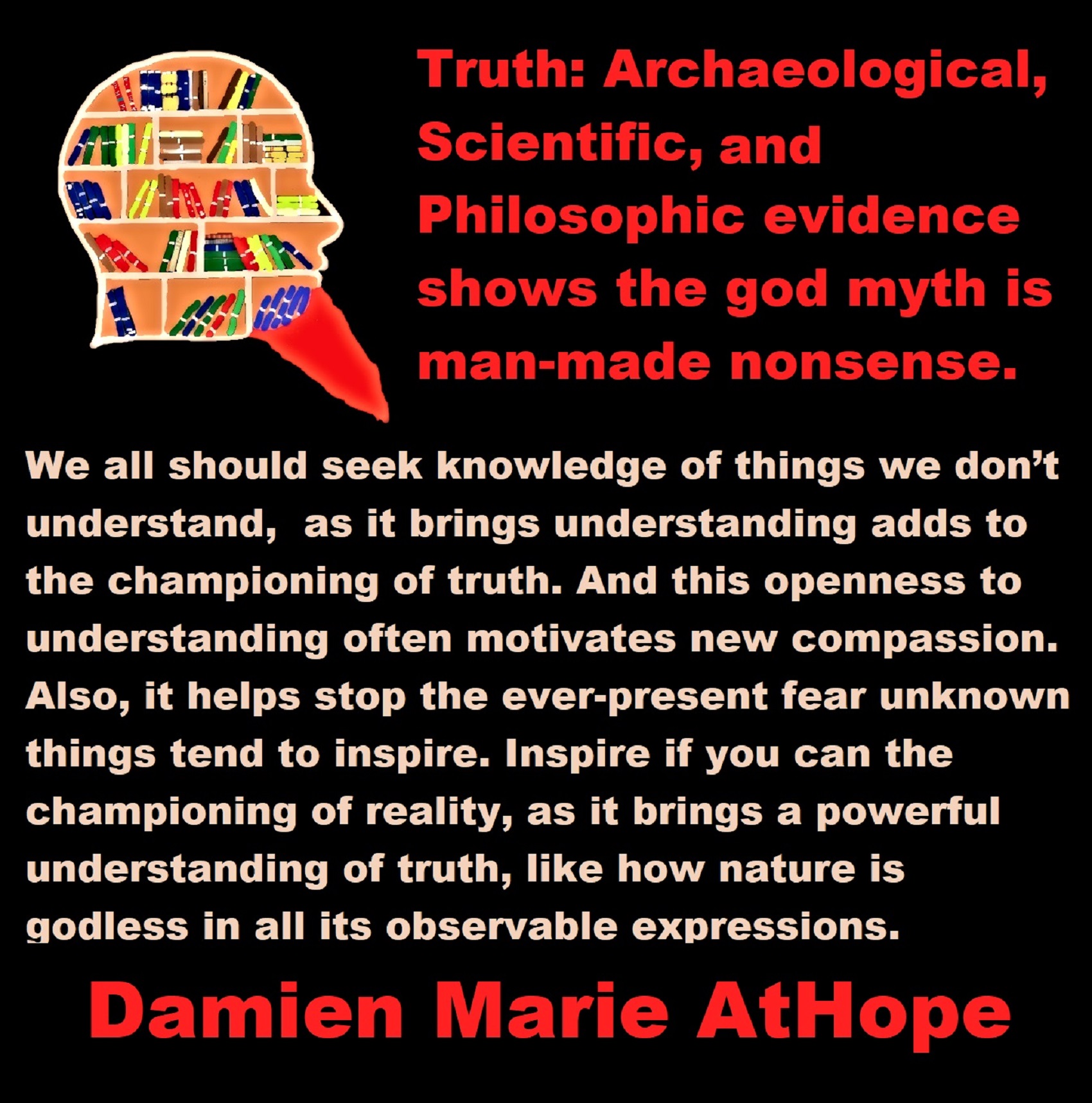
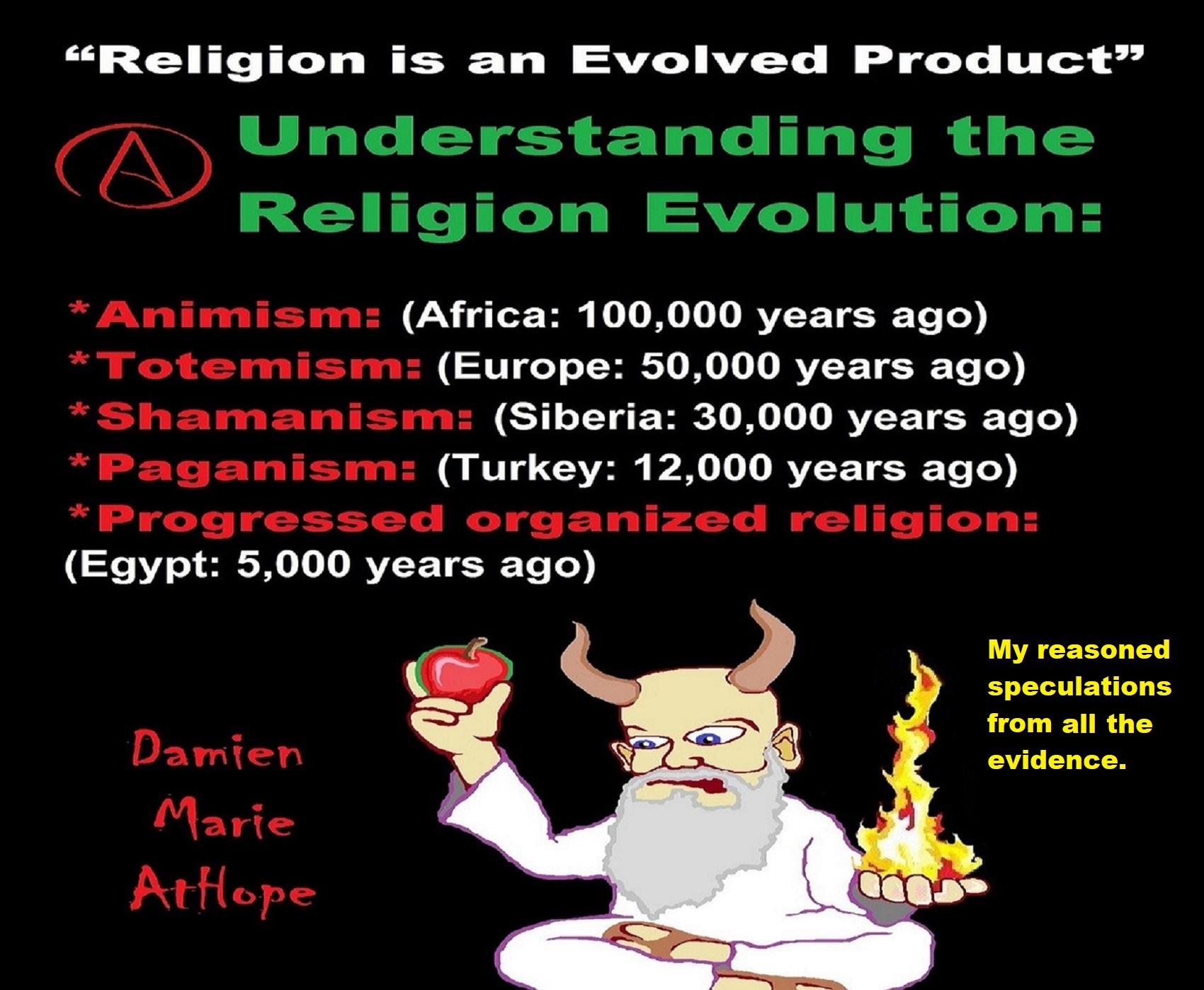
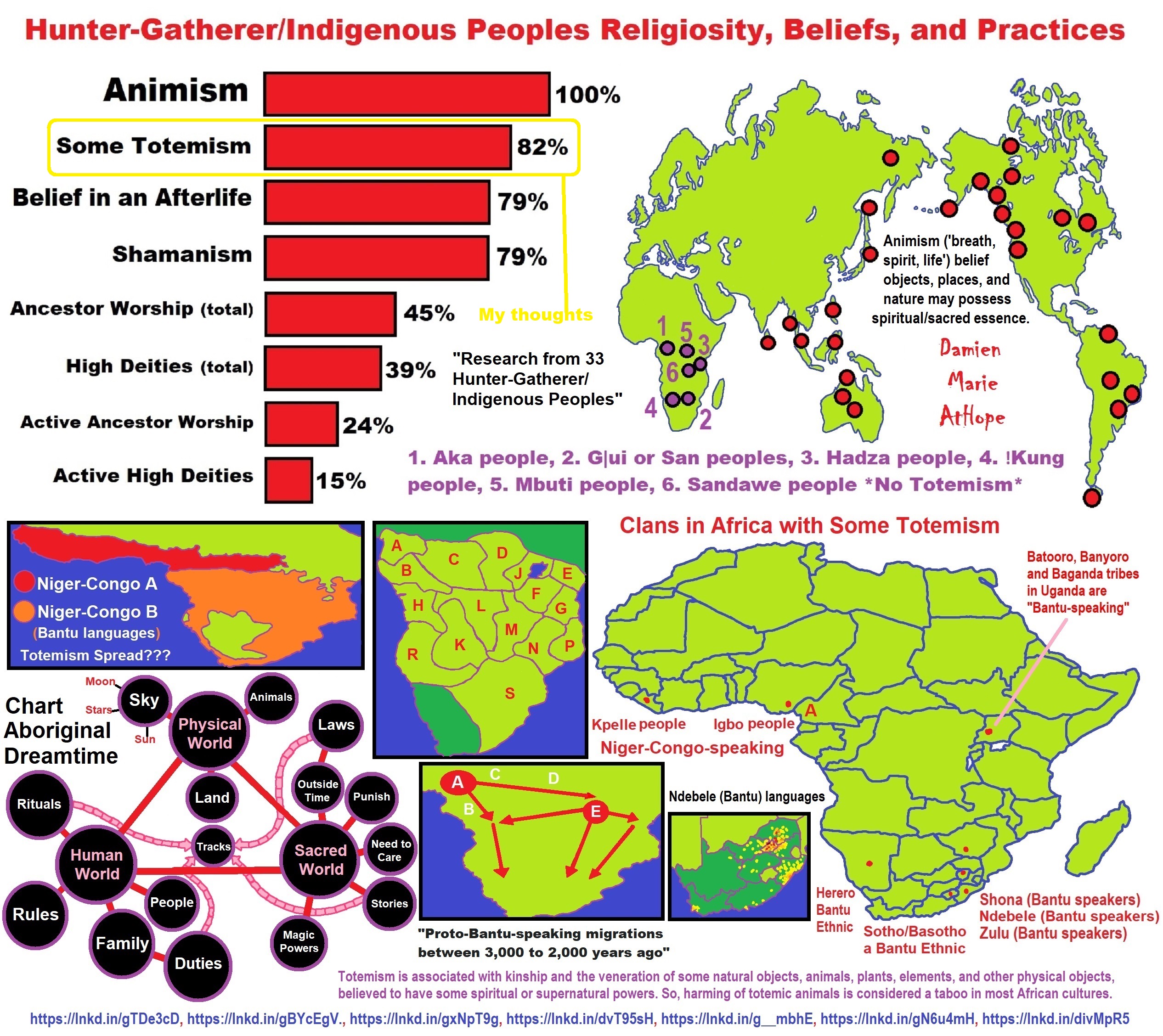
Not all “Religions” or “Religious Persuasions” have a god(s) but
All can be said to believe in some imaginary beings or imaginary things like spirits, afterlives, etc.
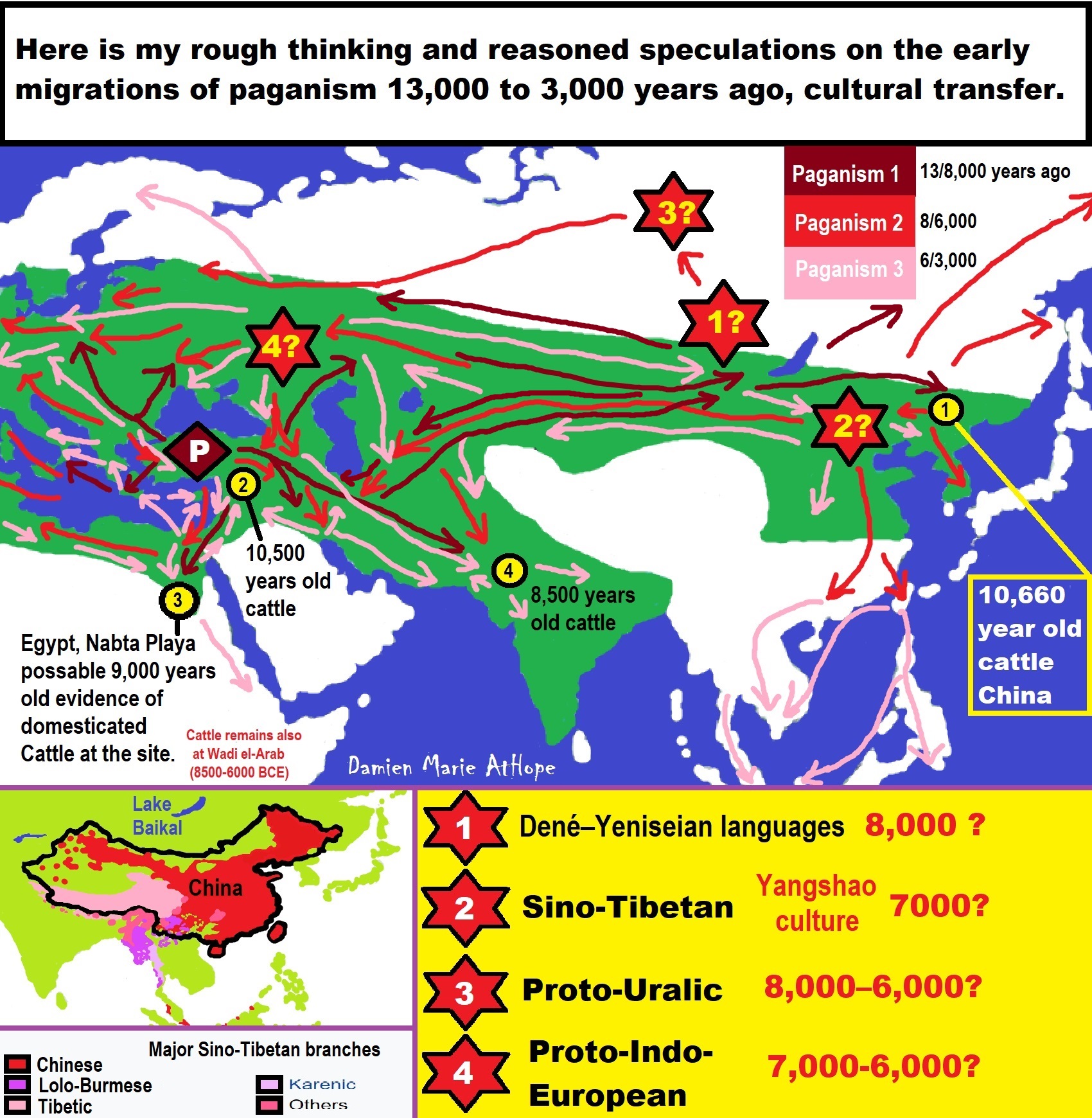
Paganism 12,000-4,000 years old
12,000-7,000 years old: related to (Pre-Capitalism)
7,000-5,000 years old: related to (Capitalism) (World War 0) Elite and their slaves!
5,000 years old: related to (Kings and the Rise of the State)
4,000 years old: related to (First Moralistic gods, then the Origin time of Monotheism)
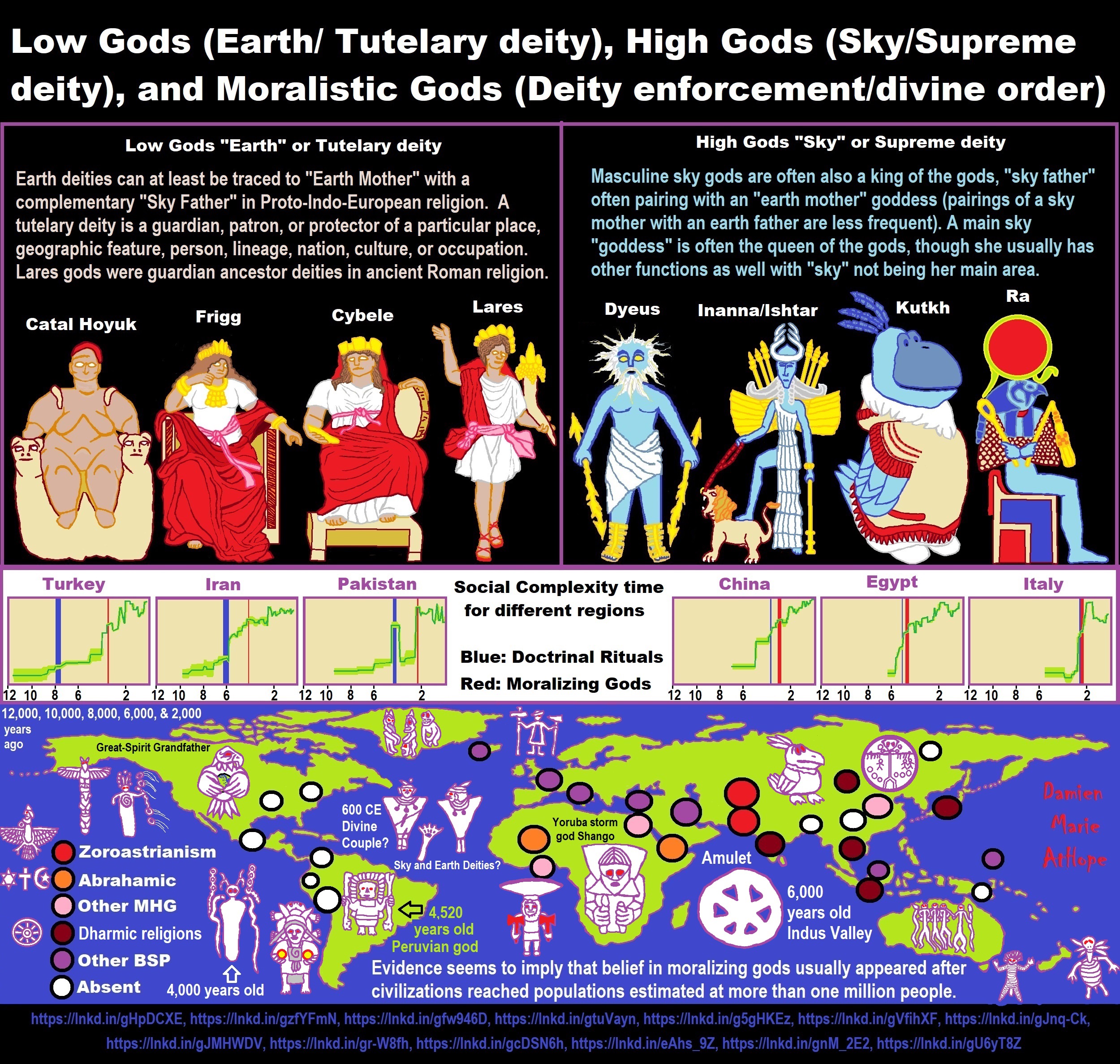
ref, ref, ref, ref, ref, ref, ref, ref, ref, ref, ref, ref, ref, ref, ref, ref, ref, ref, ref, ref, ref
Low Gods “Earth” or Tutelary deity and High Gods “Sky” or Supreme deity
“An Earth goddess is a deification of the Earth. Earth goddesses are often associated with the “chthonic” deities of the underworld. Ki and Ninhursag are Mesopotamian earth goddesses. In Greek mythology, the Earth is personified as Gaia, corresponding to Roman Terra, Indic Prithvi/Bhūmi, etc. traced to an “Earth Mother” complementary to the “Sky Father” in Proto-Indo-European religion. Egyptian mythology exceptionally has a sky goddess and an Earth god.” ref
“A mother goddess is a goddess who represents or is a personification of nature, motherhood, fertility, creation, destruction or who embodies the bounty of the Earth. When equated with the Earth or the natural world, such goddesses are sometimes referred to as Mother Earth or as the Earth Mother. In some religious traditions or movements, Heavenly Mother (also referred to as Mother in Heaven or Sky Mother) is the wife or feminine counterpart of the Sky father or God the Father.” ref
“Any masculine sky god is often also king of the gods, taking the position of patriarch within a pantheon. Such king gods are collectively categorized as “sky father” deities, with a polarity between sky and earth often being expressed by pairing a “sky father” god with an “earth mother” goddess (pairings of a sky mother with an earth father are less frequent). A main sky goddess is often the queen of the gods and may be an air/sky goddess in her own right, though she usually has other functions as well with “sky” not being her main. In antiquity, several sky goddesses in ancient Egypt, Mesopotamia, and the Near East were called Queen of Heaven. Neopagans often apply it with impunity to sky goddesses from other regions who were never associated with the term historically. The sky often has important religious significance. Many religions, both polytheistic and monotheistic, have deities associated with the sky.” ref
“In comparative mythology, sky father is a term for a recurring concept in polytheistic religions of a sky god who is addressed as a “father”, often the father of a pantheon and is often either a reigning or former King of the Gods. The concept of “sky father” may also be taken to include Sun gods with similar characteristics, such as Ra. The concept is complementary to an “earth mother“. “Sky Father” is a direct translation of the Vedic Dyaus Pita, etymologically descended from the same Proto-Indo-European deity name as the Greek Zeûs Pater and Roman Jupiter and Germanic Týr, Tir or Tiwaz, all of which are reflexes of the same Proto-Indo-European deity’s name, *Dyēus Ph₂tḗr. While there are numerous parallels adduced from outside of Indo-European mythology, there are exceptions (e.g. In Egyptian mythology, Nut is the sky mother and Geb is the earth father).” ref
Tutelary deity
“A tutelary (also tutelar) is a deity or spirit who is a guardian, patron, or protector of a particular place, geographic feature, person, lineage, nation, culture, or occupation. The etymology of “tutelary” expresses the concept of safety and thus of guardianship. In late Greek and Roman religion, one type of tutelary deity, the genius, functions as the personal deity or daimon of an individual from birth to death. Another form of personal tutelary spirit is the familiar spirit of European folklore.” ref
“A tutelary (also tutelar) in Korean shamanism, jangseung and sotdae were placed at the edge of villages to frighten off demons. They were also worshiped as deities. Seonangshin is the patron deity of the village in Korean tradition and was believed to embody the Seonangdang. In Philippine animism, Diwata or Lambana are deities or spirits that inhabit sacred places like mountains and mounds and serve as guardians. Such as: Maria Makiling is the deity who guards Mt. Makiling and Maria Cacao and Maria Sinukuan. In Shinto, the spirits, or kami, which give life to human bodies come from nature and return to it after death. Ancestors are therefore themselves tutelaries to be worshiped. And similarly, Native American beliefs such as Tonás, tutelary animal spirit among the Zapotec and Totems, familial or clan spirits among the Ojibwe, can be animals.” ref
“A tutelary (also tutelar) in Austronesian beliefs such as: Atua (gods and spirits of the Polynesian peoples such as the Māori or the Hawaiians), Hanitu (Bunun of Taiwan‘s term for spirit), Hyang (Kawi, Sundanese, Javanese, and Balinese Supreme Being, in ancient Java and Bali mythology and this spiritual entity, can be either divine or ancestral), Kaitiaki (New Zealand Māori term used for the concept of guardianship, for the sky, the sea, and the land), Kawas (mythology) (divided into 6 groups: gods, ancestors, souls of the living, spirits of living things, spirits of lifeless objects, and ghosts), Tiki (Māori mythology, Tiki is the first man created by either Tūmatauenga or Tāne and represents deified ancestors found in most Polynesian cultures). ” ref, ref, ref, ref, ref, ref, ref
Mesopotamian Tutelary Deities can be seen as ones related to City-States
“Historical city-states included Sumerian cities such as Uruk and Ur; Ancient Egyptian city-states, such as Thebes and Memphis; the Phoenician cities (such as Tyre and Sidon); the five Philistine city-states; the Berber city-states of the Garamantes; the city-states of ancient Greece (the poleis such as Athens, Sparta, Thebes, and Corinth); the Roman Republic (which grew from a city-state into a vast empire); the Italian city-states from the Middle Ages to the early modern period, such as Florence, Siena, Ferrara, Milan (which as they grew in power began to dominate neighboring cities) and Genoa and Venice, which became powerful thalassocracies; the Mayan and other cultures of pre-Columbian Mesoamerica (including cities such as Chichen Itza, Tikal, Copán and Monte Albán); the central Asian cities along the Silk Road; the city-states of the Swahili coast; Ragusa; states of the medieval Russian lands such as Novgorod and Pskov; and many others.” ref
“The Uruk period (ca. 4000 to 3100 BCE; also known as Protoliterate period) of Mesopotamia, named after the Sumerian city of Uruk, this period saw the emergence of urban life in Mesopotamia and the Sumerian civilization. City-States like Uruk and others had a patron tutelary City Deity along with a Priest-King.” ref
“Chinese folk religion, both past, and present, includes myriad tutelary deities. Exceptional individuals, highly cultivated sages, and prominent ancestors can be deified and honored after death. Lord Guan is the patron of military personnel and police, while Mazu is the patron of fishermen and sailors. Such as Tu Di Gong (Earth Deity) is the tutelary deity of a locality, and each individual locality has its own Earth Deity and Cheng Huang Gong (City God) is the guardian deity of an individual city, worshipped by local officials and locals since imperial times.” ref
“A tutelary (also tutelar) in Hinduism, personal tutelary deities are known as ishta-devata, while family tutelary deities are known as Kuladevata. Gramadevata are guardian deities of villages. Devas can also be seen as tutelary. Shiva is the patron of yogis and renunciants. City goddesses include: Mumbadevi (Mumbai), Sachchika (Osian); Kuladevis include: Ambika (Porwad), and Mahalakshmi. In NorthEast India Meitei mythology and religion (Sanamahism) of Manipur, there are various types of tutelary deities, among which Lam Lais are the most predominant ones. Tibetan Buddhism has Yidam as a tutelary deity. Dakini is the patron of those who seek knowledge.” ref
“A tutelary (also tutelar) The Greeks also thought deities guarded specific places: for instance, Athena was the patron goddess of the city of Athens. Socrates spoke of hearing the voice of his personal spirit or daimonion:
You have often heard me speak of an oracle or sign which comes to me … . This sign I have had ever since I was a child. The sign is a voice which comes to me and always forbids me to do something which I am going to do, but never commands me to do anything, and this is what stands in the way of my being a politician.” ref
“Tutelary deities who guard and preserve a place or a person are fundamental to ancient Roman religion. The tutelary deity of a man was his Genius, that of a woman her Juno. In the Imperial era, the Genius of the Emperor was a focus of Imperial cult. An emperor might also adopt a major deity as his personal patron or tutelary, as Augustus did Apollo. Precedents for claiming the personal protection of a deity were established in the Republican era, when for instance the Roman dictator Sulla advertised the goddess Victory as his tutelary by holding public games (ludi) in her honor.” ref
“Each town or city had one or more tutelary deities, whose protection was considered particularly vital in time of war and siege. Rome itself was protected by a goddess whose name was to be kept ritually secret on pain of death (for a supposed case, see Quintus Valerius Soranus). The Capitoline Triad of Juno, Jupiter, and Minerva were also tutelaries of Rome. The Italic towns had their own tutelary deities. Juno often had this function, as at the Latin town of Lanuvium and the Etruscan city of Veii, and was often housed in an especially grand temple on the arx (citadel) or other prominent or central location. The tutelary deity of Praeneste was Fortuna, whose oracle was renowned.” ref
“The Roman ritual of evocatio was premised on the belief that a town could be made vulnerable to military defeat if the power of its tutelary deity were diverted outside the city, perhaps by the offer of superior cult at Rome. The depiction of some goddesses such as the Magna Mater (Great Mother, or Cybele) as “tower-crowned” represents their capacity to preserve the city. A town in the provinces might adopt a deity from within the Roman religious sphere to serve as its guardian, or syncretize its own tutelary with such; for instance, a community within the civitas of the Remi in Gaul adopted Apollo as its tutelary, and at the capital of the Remi (present-day Rheims), the tutelary was Mars Camulus.” ref
Household deity (a kind of or related to a Tutelary deity)
“A household deity is a deity or spirit that protects the home, looking after the entire household or certain key members. It has been a common belief in paganism as well as in folklore across many parts of the world. Household deities fit into two types; firstly, a specific deity – typically a goddess – often referred to as a hearth goddess or domestic goddess who is associated with the home and hearth, such as the ancient Greek Hestia.” ref
“The second type of household deities are those that are not one singular deity, but a type, or species of animistic deity, who usually have lesser powers than major deities. This type was common in the religions of antiquity, such as the Lares of ancient Roman religion, the Gashin of Korean shamanism, and Cofgodas of Anglo-Saxon paganism. These survived Christianisation as fairy-like creatures existing in folklore, such as the Anglo-Scottish Brownie and Slavic Domovoy.” ref
“Household deities were usually worshipped not in temples but in the home, where they would be represented by small idols (such as the teraphim of the Bible, often translated as “household gods” in Genesis 31:19 for example), amulets, paintings, or reliefs. They could also be found on domestic objects, such as cosmetic articles in the case of Tawaret. The more prosperous houses might have a small shrine to the household god(s); the lararium served this purpose in the case of the Romans. The gods would be treated as members of the family and invited to join in meals, or be given offerings of food and drink.” ref
“In many religions, both ancient and modern, a god would preside over the home. Certain species, or types, of household deities, existed. An example of this was the Roman Lares. Many European cultures retained house spirits into the modern period. Some examples of these include:
- Brownie (Scotland and England) or Hob (England) / Kobold (Germany) / Goblin / Hobgoblin
- Domovoy (Slavic)
- Nisse (Norwegian or Danish) / Tomte (Swedish) / Tonttu (Finnish)
- Húsvættir (Norse)” ref
“Although the cosmic status of household deities was not as lofty as that of the Twelve Olympians or the Aesir, they were also jealous of their dignity and also had to be appeased with shrines and offerings, however humble. Because of their immediacy they had arguably more influence on the day-to-day affairs of men than the remote gods did. Vestiges of their worship persisted long after Christianity and other major religions extirpated nearly every trace of the major pagan pantheons. Elements of the practice can be seen even today, with Christian accretions, where statues to various saints (such as St. Francis) protect gardens and grottos. Even the gargoyles found on older churches, could be viewed as guardians partitioning a sacred space.” ref
“For centuries, Christianity fought a mop-up war against these lingering minor pagan deities, but they proved tenacious. For example, Martin Luther‘s Tischreden have numerous – quite serious – references to dealing with kobolds. Eventually, rationalism and the Industrial Revolution threatened to erase most of these minor deities, until the advent of romantic nationalism rehabilitated them and embellished them into objects of literary curiosity in the 19th century. Since the 20th century this literature has been mined for characters for role-playing games, video games, and other fantasy personae, not infrequently invested with invented traits and hierarchies somewhat different from their mythological and folkloric roots.” ref
“In contradistinction to both Herbert Spencer and Edward Burnett Tylor, who defended theories of animistic origins of ancestor worship, Émile Durkheim saw its origin in totemism. In reality, this distinction is somewhat academic, since totemism may be regarded as a particularized manifestation of animism, and something of a synthesis of the two positions was attempted by Sigmund Freud. In Freud’s Totem and Taboo, both totem and taboo are outward expressions or manifestations of the same psychological tendency, a concept which is complementary to, or which rather reconciles, the apparent conflict. Freud preferred to emphasize the psychoanalytic implications of the reification of metaphysical forces, but with particular emphasis on its familial nature. This emphasis underscores, rather than weakens, the ancestral component.” ref
“William Edward Hearn, a noted classicist, and jurist, traced the origin of domestic deities from the earliest stages as an expression of animism, a belief system thought to have existed also in the neolithic, and the forerunner of Indo-European religion. In his analysis of the Indo-European household, in Chapter II “The House Spirit”, Section 1, he states:
The belief which guided the conduct of our forefathers was … the spirit rule of dead ancestors.” ref
“In Section 2 he proceeds to elaborate:
It is thus certain that the worship of deceased ancestors is a vera causa, and not a mere hypothesis. …
In the other European nations, the Slavs, the Teutons, and the Kelts, the House Spirit appears with no less distinctness. … [T]he existence of that worship does not admit of doubt. … The House Spirits had a multitude of other names which it is needless here to enumerate, but all of which are more or less expressive of their friendly relations with man. … In [England] … [h]e is the Brownie. … In Scotland this same Brownie is well known. He is usually described as attached to particular families, with whom he has been known to reside for centuries, threshing the corn, cleaning the house, and performing similar household tasks. His favorite gratification was milk and honey.” ref

ref, ref, ref, ref, ref, ref, ref, ref, ref, ref, ref, ref, ref, ref, ref, ref, ref
“These ideas are my speculations from the evidence.”
I am still researching the “god‘s origins” all over the world. So you know, it is very complicated but I am smart and willing to look, DEEP, if necessary, which going very deep does seem to be needed here, when trying to actually understand the evolution of gods and goddesses. I am sure of a few things and less sure of others, but even in stuff I am not fully grasping I still am slowly figuring it out, to explain it to others. But as I research more I am understanding things a little better, though I am still working on understanding it all or something close and thus always figuring out more.
Sky Father/Sky God?
“Egyptian: (Nut) Sky Mother and (Geb) Earth Father” (Egypt is different but similar)
Turkic/Mongolic: (Tengri/Tenger Etseg) Sky Father and (Eje/Gazar Eej) Earth Mother *Transeurasian*
Hawaiian: (Wākea) Sky Father and (Papahānaumoku) Earth Mother *Austronesian*
New Zealand/ Māori: (Ranginui) Sky Father and (Papatūānuku) Earth Mother *Austronesian*
Proto-Indo-European: (Dyḗus/Dyḗus ph₂tḗr) Sky Father and (Dʰéǵʰōm/Pleth₂wih₁) Earth Mother
Indo-Aryan: (Dyaus Pita) Sky Father and (Prithvi Mata) Earth Mother *Indo-European*
Italic: (Jupiter) Sky Father and (Juno) Sky Mother *Indo-European*
Etruscan: (Tinia) Sky Father and (Uni) Sky Mother *Tyrsenian/Italy Pre–Indo-European*
Hellenic/Greek: (Zeus) Sky Father and (Hera) Sky Mother who started as an “Earth Goddess” *Indo-European*
Nordic: (Dagr) Sky Father and (Nótt) Sky Mother *Indo-European*
Slavic: (Perun) Sky Father and (Mokosh) Earth Mother *Indo-European*
Illyrian: (Deipaturos) Sky Father and (Messapic Damatura’s “earth-mother” maybe) Earth Mother *Indo-European*
Albanian: (Zojz) Sky Father and (?) *Indo-European*
Baltic: (Perkūnas) Sky Father and (Saulė) Sky Mother *Indo-European*
Germanic: (Týr) Sky Father and (?) *Indo-European*
Colombian-Muisca: (Bochica) Sky Father and (Huythaca) Sky Mother *Chibchan*
Aztec: (Quetzalcoatl) Sky Father and (Xochiquetzal) Sky Mother *Uto-Aztecan*
Incan: (Viracocha) Sky Father and (Mama Runtucaya) Sky Mother *Quechuan*
China: (Tian/Shangdi) Sky Father and (Dì) Earth Mother *Sino-Tibetan*
Sumerian, Assyrian and Babylonian: (An/Anu) Sky Father and (Ki) Earth Mother
Finnish: (Ukko) Sky Father and (Akka) Earth Mother *Finno-Ugric*
Sami: (Horagalles) Sky Father and (Ravdna) Earth Mother *Finno-Ugric*
Puebloan-Zuni: (Ápoyan Ta’chu) Sky Father and (Áwitelin Tsíta) Earth Mother
Puebloan-Hopi: (Tawa) Sky Father and (Kokyangwuti/Spider Woman/Grandmother) Earth Mother *Uto-Aztecan*
Puebloan-Navajo: (Tsohanoai) Sky Father and (Estsanatlehi) Earth Mother *Na-Dene*
ref, ref, ref, ref, ref, ref, ref, ref, ref, ref, ref, ref, ref, ref, ref, ref, ref, ref, ref, ref, ref, ref, ref, ref, ref, ref, ref
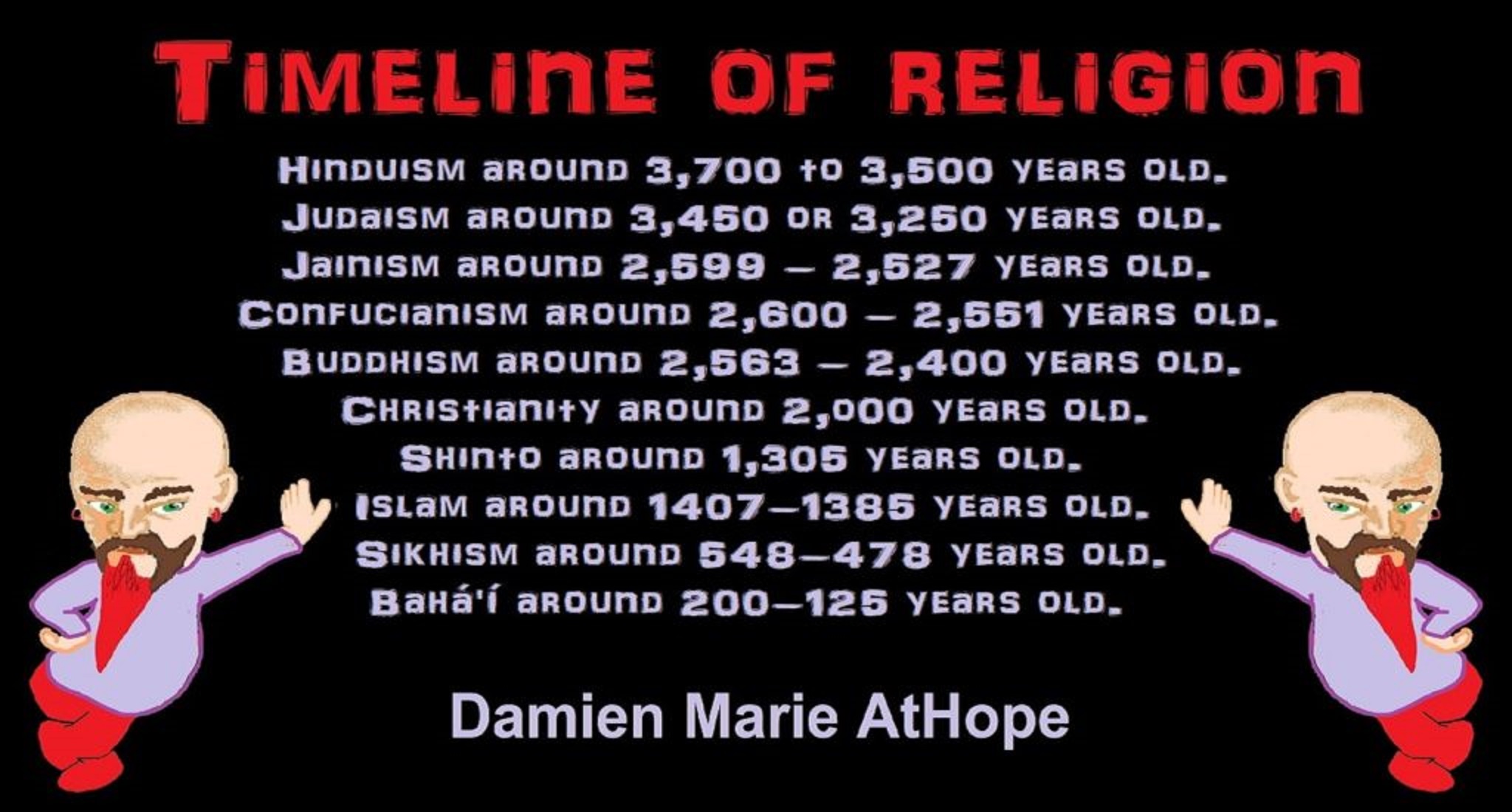
Hinduism around 3,700 to 3,500 years old. ref
Judaism around 3,450 or 3,250 years old. (The first writing in the bible was “Paleo-Hebrew” dated to around 3,000 years ago Khirbet Qeiyafa is the site of an ancient fortress city overlooking the Elah Valley. And many believe the religious Jewish texts were completed around 2,500) ref, ref
Judaism is around 3,450 or 3,250 years old. (“Paleo-Hebrew” 3,000 years ago and Torah 2,500 years ago)
“Judaism is an Abrahamic, its roots as an organized religion in the Middle East during the Bronze Age. Some scholars argue that modern Judaism evolved from Yahwism, the religion of ancient Israel and Judah, by the late 6th century BCE, and is thus considered to be one of the oldest monotheistic religions.” ref
“Yahwism is the name given by modern scholars to the religion of ancient Israel, essentially polytheistic, with a plethora of gods and goddesses. Heading the pantheon was Yahweh, the national god of the Israelite kingdoms of Israel and Judah, with his consort, the goddess Asherah; below them were second-tier gods and goddesses such as Baal, Shamash, Yarikh, Mot, and Astarte, all of whom had their own priests and prophets and numbered royalty among their devotees, and a third and fourth tier of minor divine beings, including the mal’ak, the messengers of the higher gods, who in later times became the angels of Judaism, Christianity and Islam. Yahweh, however, was not the ‘original’ god of Israel “Isra-El”; it is El, the head of the Canaanite pantheon, whose name forms the basis of the name “Israel”, and none of the Old Testament patriarchs, the tribes of Israel, the Judges, or the earliest monarchs, have a Yahwistic theophoric name (i.e., one incorporating the name of Yahweh).” ref
“El is a Northwest Semitic word meaning “god” or “deity“, or referring (as a proper name) to any one of multiple major ancient Near Eastern deities. A rarer form, ‘ila, represents the predicate form in Old Akkadian and in Amorite. The word is derived from the Proto-Semitic *ʔil-, meaning “god”. Specific deities known as ‘El or ‘Il include the supreme god of the ancient Canaanite religion and the supreme god of East Semitic speakers in Mesopotamia’s Early Dynastic Period. ʼĒl is listed at the head of many pantheons. In some Canaanite and Ugaritic sources, ʼĒl played a role as father of the gods, of creation, or both. For example, in the Ugaritic texts, ʾil mlk is understood to mean “ʼĒl the King” but ʾil hd as “the god Hadad“. The Semitic root ʾlh (Arabic ʾilāh, Aramaic ʾAlāh, ʾElāh, Hebrew ʾelōah) may be ʾl with a parasitic h, and ʾl may be an abbreviated form of ʾlh. In Ugaritic the plural form meaning “gods” is ʾilhm, equivalent to Hebrew ʾelōhîm “powers”. In the Hebrew texts this word is interpreted as being semantically singular for “god” by biblical commentators. However the documentary hypothesis for the Old Testament (corresponds to the Jewish Torah) developed originally in the 1870s, identifies these that different authors – the Jahwist, Elohist, Deuteronomist, and the Priestly source – were responsible for editing stories from a polytheistic religion into those of a monotheistic religion. Inconsistencies that arise between monotheism and polytheism in the texts are reflective of this hypothesis.” ref
Jainism around 2,599 – 2,527 years old. ref
Confucianism around 2,600 – 2,551 years old. ref
Buddhism around 2,563/2,480 – 2,483/2,400 years old. ref
Christianity around 2,o00 years old. ref
Shinto around 1,305 years old. ref
Islam around 1407–1385 years old. ref
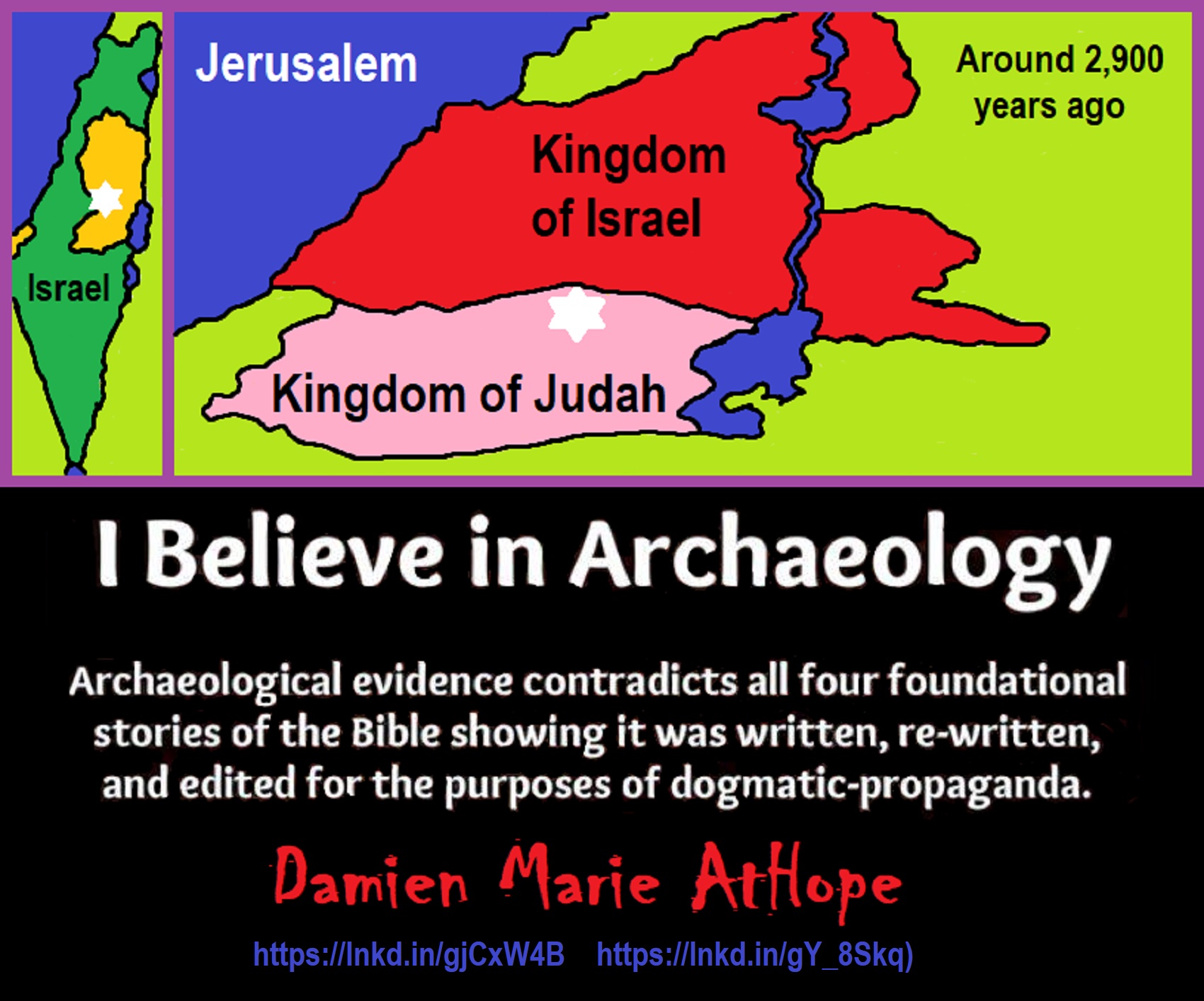
Knowledge to Ponder:
Stars/Astrology:
- Possibly, around 30,000 years ago (in simpler form) to 6,000 years ago, Stars/Astrology are connected to Ancestors, Spirit Animals, and Deities.
- The star also seems to be a possible proto-star for Star of Ishtar, Star of Inanna, or Star of Venus.
- Around 7,000 to 6,000 years ago, Star Constellations/Astrology have connections to the “Kurgan phenomenon” of below-ground “mound” stone/wood burial structures and “Dolmen phenomenon” of above-ground stone burial structures.
- Around 6,500–5,800 years ago, The Northern Levant migrations into Jordon and Israel in the Southern Levant brought new cultural and religious transfer from Turkey and Iran.
- “The Ghassulian Star,” a mysterious 6,000-year-old mural from Jordan may have connections to the European paganstic kurgan/dolmens phenomenon.
“Astrology is a range of divinatory practices, recognized as pseudoscientific since the 18th century, that claim to discern information about human affairs and terrestrial events by studying the apparent positions of celestial objects. Different cultures have employed forms of astrology since at least the 2nd millennium BCE, these practices having originated in calendrical systems used to predict seasonal shifts and to interpret celestial cycles as signs of divine communications. Most, if not all, cultures have attached importance to what they observed in the sky, and some—such as the Hindus, Chinese, and the Maya—developed elaborate systems for predicting terrestrial events from celestial observations. Western astrology, one of the oldest astrological systems still in use, can trace its roots to 19th–17th century BCE Mesopotamia, from where it spread to Ancient Greece, Rome, the Islamicate world and eventually Central and Western Europe. Contemporary Western astrology is often associated with systems of horoscopes that purport to explain aspects of a person’s personality and predict significant events in their lives based on the positions of celestial objects; the majority of professional astrologers rely on such systems.” ref
Around 5,500 years ago, Science evolves, The first evidence of science was 5,500 years ago and was demonstrated by a body of empirical, theoretical, and practical knowledge about the natural world. ref
Around 5,000 years ago, Origin of Logics is a Naturalistic Observation (principles of valid reasoning, inference, & demonstration) ref
Around 4,150 to 4,000 years ago: The earliest surviving versions of the Sumerian Epic of Gilgamesh, which was originally titled “He who Saw the Deep” (Sha naqba īmuru) or “Surpassing All Other Kings” (Shūtur eli sharrī) were written. ref
Hinduism:
- 3,700 years ago or so, the oldest of the Hindu Vedas (scriptures), the Rig Veda was composed.
- 3,500 years ago or so, the Vedic Age began in India after the collapse of the Indus Valley Civilization.
Judaism:
- around 3,000 years ago, the first writing in the bible was “Paleo-Hebrew”
- around 2,500 years ago, many believe the religious Jewish texts were completed
Myths: The bible inspired religion is not just one religion or one myth but a grouping of several religions and myths
- Around 3,450 or 3,250 years ago, according to legend, is the traditionally accepted period in which the Israelite lawgiver, Moses, provided the Ten Commandments.
- Around 2,500 to 2,400 years ago, a collection of ancient religious writings by the Israelites based primarily upon the Hebrew Bible, Tanakh, or Old Testament is the first part of Christianity’s bible.
- Around 2,400 years ago, the most accepted hypothesis is that the canon was formed in stages, first the Pentateuch (Torah).
- Around 2,140 to 2,116 years ago, the Prophets was written during the Hasmonean dynasty, and finally the remaining books.
- Christians traditionally divide the Old Testament into four sections:
- The first five books or Pentateuch (Torah).
- The proposed history books telling the history of the Israelites from their conquest of Canaan to their defeat and exile in Babylon.
- The poetic and proposed “Wisdom books” dealing, in various forms, with questions of good and evil in the world.
- The books of the biblical prophets, warning of the consequences of turning away from God:
- Henotheism:
- Exodus 20:23 “You shall not make other gods besides Me (not saying there are no other gods just not to worship them); gods of silver or gods of gold, you shall not make for yourselves.”
- Polytheism:
- Judges 10:6 “Then the sons of Israel again did evil in the sight of the LORD, served the Baals and the Ashtaroth, the gods of Aram, the gods of Sidon, the gods of Moab, the gods of the sons of Ammon, and the gods of the Philistines; thus they forsook the LORD and did not serve Him.”
- 1 Corinthians 8:5 “For even if there are so-called gods whether in heaven or on earth, as indeed there are many gods and many lords.”
- Monotheism:
- Isaiah 43:10 “You are my witnesses,” declares the LORD, “and my servant whom I have chosen, so that you may know and believe me and understand that I am he. Before me no god was formed, nor will there be one after me.
Around 2,570 to 2,270 Years Ago, there is a confirmation of atheistic doubting as well as atheistic thinking, mainly by Greek philosophers. However, doubting gods is likely as old as the invention of gods and should destroy the thinking that belief in god(s) is the “default belief”. The Greek word is apistos (a “not” and pistos “faithful,”), thus not faithful or faithless because one is unpersuaded and unconvinced by a god(s) claim. Short Definition: unbelieving, unbeliever, or unbelief.
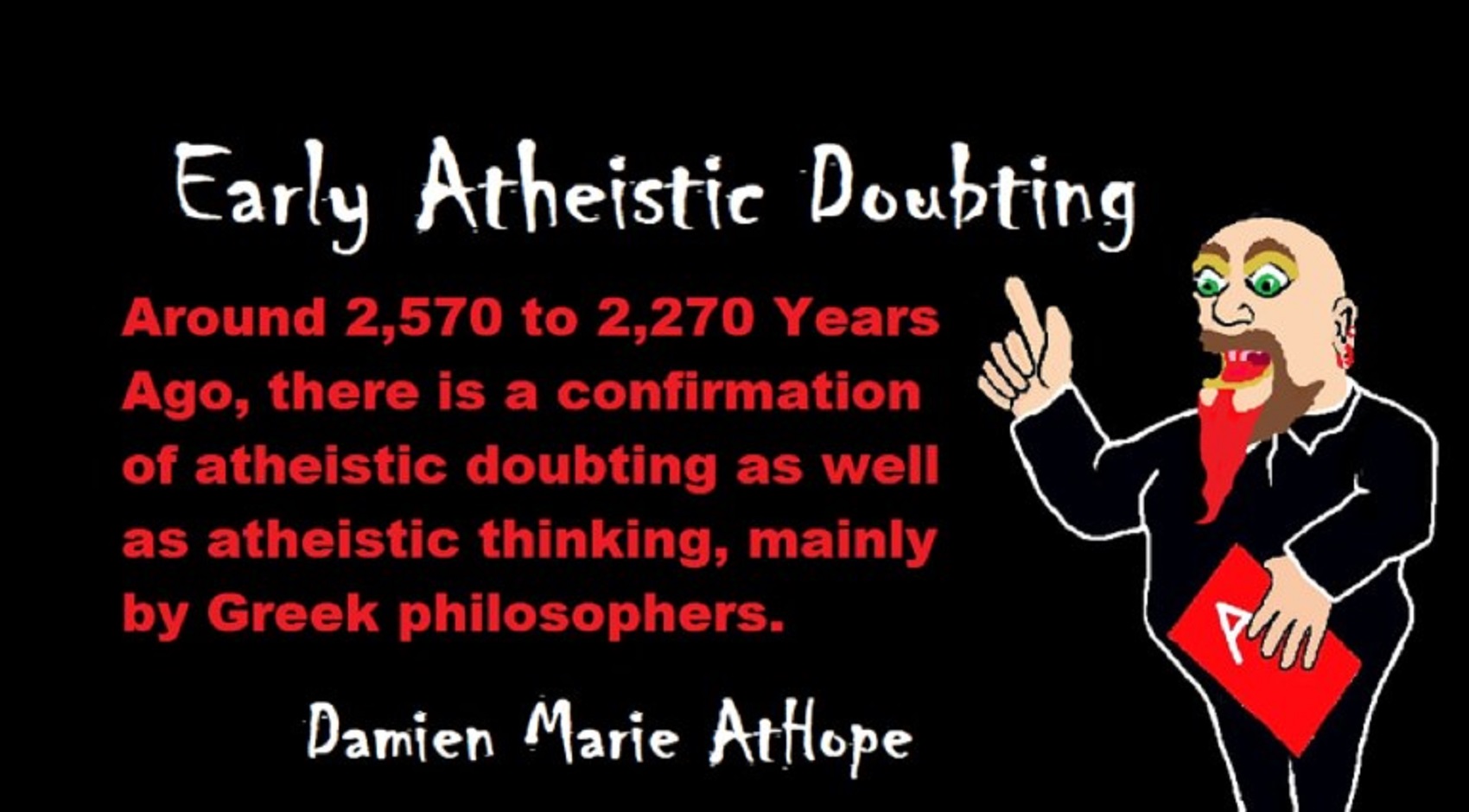
Expressions of Atheistic Thinking:
- Around 2,600 years ago, Ajita Kesakambali, ancient Indian philosopher, who is the first known proponent of Indian materialism. ref
- Around 2,535 to 2,475 years ago, Heraclitus, Greek pre-Socratic philosopher, a native of the Greek city Ephesus, Ionia, on the coast of Anatolia, also known as Asia Minor or modern Turkey. ref
- Around 2,500 to 2,400 years ago, according to The Story of Civilization book series certain African pygmy tribes have no identifiable gods, spirits, or religious beliefs or rituals, and even what burials accrue are without ceremony. ref
- Around 2,490 to 2,430 years ago, Empedocles, Greek pre-Socratic philosopher and a citizen of Agrigentum, a Greek city in Sicily. ref
- Around 2,460 to 2,370 years ago, Democritus, Greek pre-Socratic philosopher considered to be the “father of modern science” possibly had some disbelief amounting to atheism. ref
- Around 2,399 years ago or so, Socrates, a famous Greek philosopher was tried for sinfulness by teaching doubt of state gods. ref
- Around 2,341 to 2,270 years ago, Epicurus, a Greek philosopher known for composing atheistic critics and famously stated, “Is God willing to prevent evil, but not able? Then he is not omnipotent. Is he able, but not willing? Then he is malevolent. Is he both able and willing? Then whence cometh evil? Is he neither able nor willing? Then why call him god?” ref
This last expression by Epicurus, seems to be an expression of Axiological Atheism. To understand and utilize value or actually possess “Value Conscious/Consciousness” to both give a strong moral “axiological” argument (the problem of evil) as well as use it to fortify humanism and positive ethical persuasion of human helping and care responsibilities. Because value-blindness gives rise to sociopathic/psychopathic evil.

“Theists, there has to be a god, as something can not come from nothing.”
Well, thus something (unknown) happened and then there was something. This does not tell us what the something that may have been involved with something coming from nothing. A supposed first cause, thus something (unknown) happened and then there was something is not an open invitation to claim it as known, neither is it justified to call or label such an unknown as anything, especially an unsubstantiated magical thinking belief born of mythology and religious storytelling.
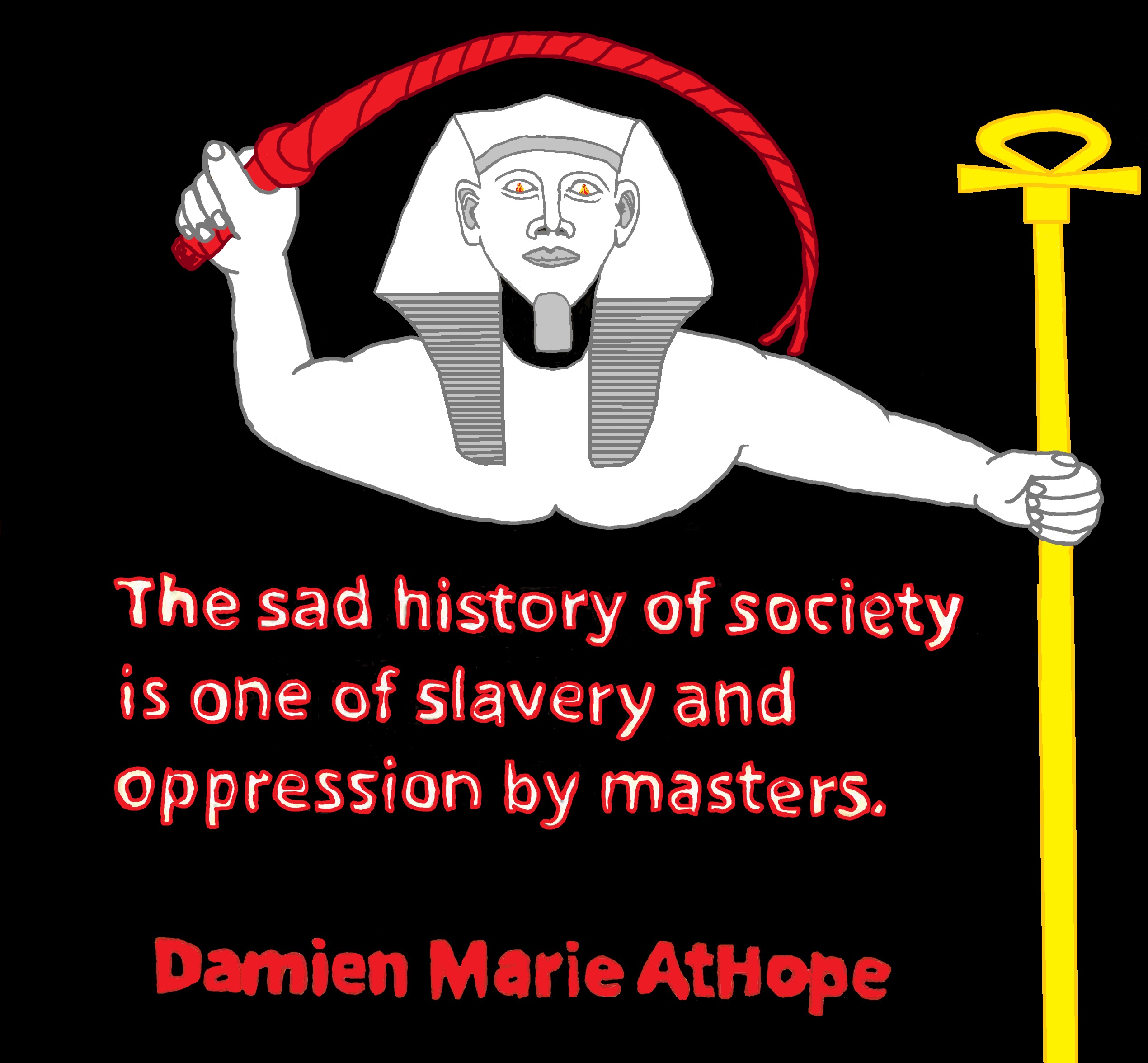
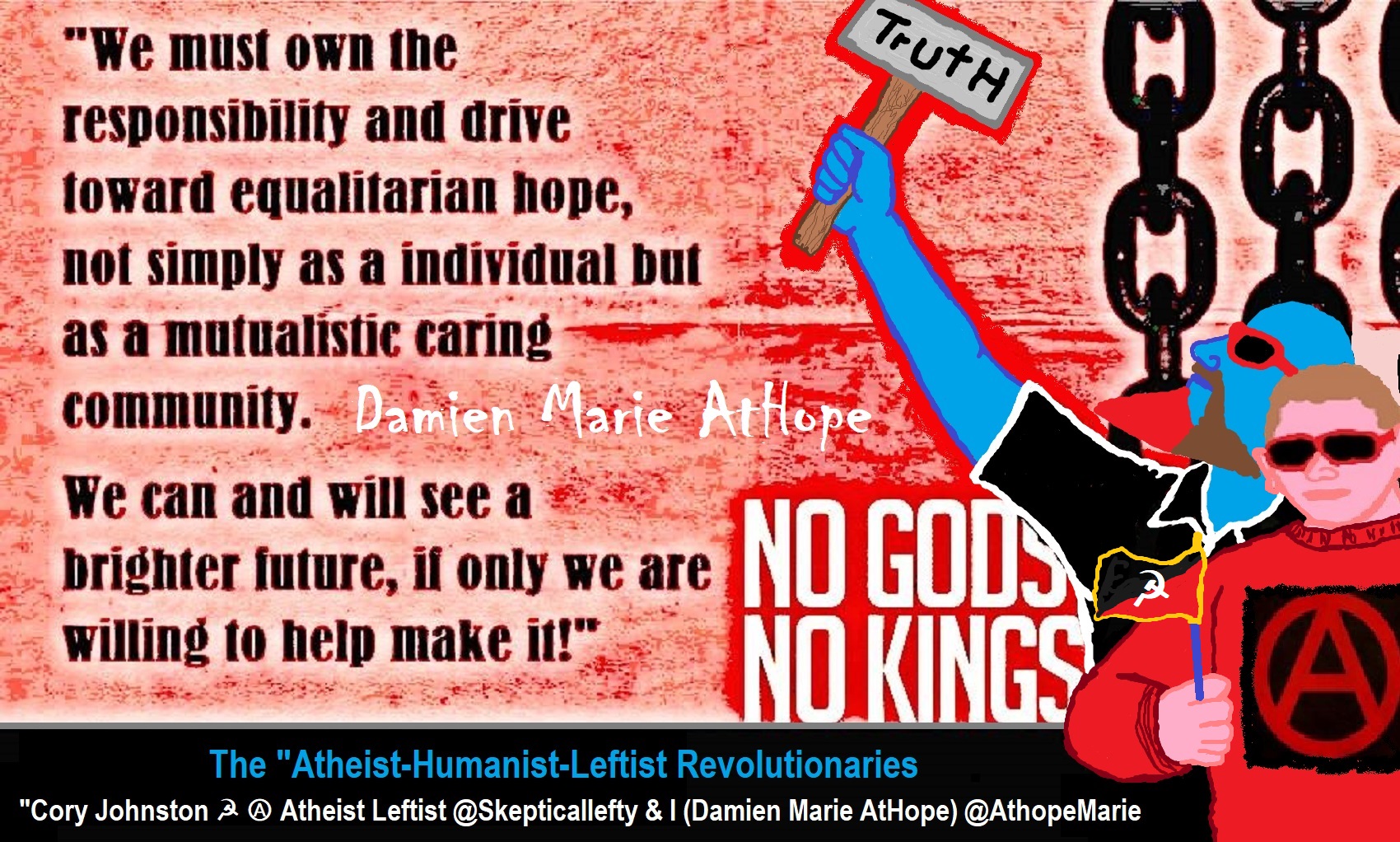
While hallucinogens are associated with shamanism, it is alcohol that is associated with paganism.
The Atheist-Humanist-Leftist Revolutionaries Shows in the prehistory series:
Show two: Pre-animism 300,000 years old and animism 100,000 years old: related to “Anarchism and Socialism”
Show tree: Totemism 50,000 years old: related to “Anarchism and Socialism”
Show four: Shamanism 30,000 years old: related to “Anarchism and Socialism”
Show five: Paganism 12,000 years old: related to “Anarchism and Socialism”
Show six: Emergence of hierarchy, sexism, slavery, and the new male god dominance: Paganism 7,000-5,000 years old: related to “Anarchism and Socialism” (Capitalism) (World War 0) Elite and their slaves!
Prehistory: related to “Anarchism and Socialism” the division of labor, power, rights, and recourses: VIDEO
Pre-animism 300,000 years old and animism 100,000 years old: related to “Anarchism and Socialism”: VIDEO
Totemism 50,000 years old: related to “Anarchism and Socialism”: VIDEO
Shamanism 30,000 years old: related to “Anarchism and Socialism”: VIDEO
Paganism 12,000 years old: related to “Anarchism and Socialism” (Pre-Capitalism): VIDEO
Paganism 7,000-5,000 years old: related to “Anarchism and Socialism” (Capitalism) (World War 0) Elite and their slaves: VIEDO
Paganism 5,000 years old: progressed organized religion and the state: related to “Anarchism and Socialism” (Kings and the Rise of the State): VIEDO
Paganism 4,000 years old: related to “Anarchism and Socialism” (First Moralistic gods, then the Origin time of Monotheism): VIEDO
I do not hate simply because I challenge and expose myths or lies any more than others being thought of as loving simply because of the protection and hiding from challenge their favored myths or lies.
The truth is best championed in the sunlight of challenge.
An archaeologist once said to me “Damien religion and culture are very different”
My response, So are you saying that was always that way, such as would you say Native Americans’ cultures are separate from their religions? And do you think it always was the way you believe?
I had said that religion was a cultural product. That is still how I see it and there are other archaeologists that think close to me as well. Gods too are the myths of cultures that did not understand science or the world around them, seeing magic/supernatural everywhere.
I personally think there is a goddess and not enough evidence to support a male god at Çatalhöyük but if there was both a male and female god and goddess then I know the kind of gods they were like Proto-Indo-European mythology.
This series idea was addressed in, Anarchist Teaching as Free Public Education or Free Education in the Public: VIDEO
Our 12 video series: Organized Oppression: Mesopotamian State Force and the Politics of power (9,000-4,000 years ago), is adapted from: The Complete and Concise History of the Sumerians and Early Bronze Age Mesopotamia (7000-2000 BC): https://www.youtube.com/watch?v=szFjxmY7jQA by “History with Cy“
Show #1: Mesopotamian State Force and the Politics of Power (Samarra, Halaf, Ubaid)
Show #2: Mesopotamian State Force and the Politics of Power
Show #3: Mesopotamian State Force and the Politics of Power (Uruk and the First Cities)
Show #4: Mesopotamian State Force and the Politics of Power (First Kings)
Show #5: Mesopotamian State Force and the Politics of Power (Early Dynastic Period)
Show #6: Mesopotamian State Force and the Politics of Power
Show #7: Mesopotamian State Force and the Politics of Power (Sargon and Akkadian Rule)
Show #9: Mesopotamian State Force and the Politics of Power (Gudea of Lagash and Utu-hegal)
Show #12: Mesopotamian State Force and the Politics of Power (Aftermath and Legacy of Sumer)

The “Atheist-Humanist-Leftist Revolutionaries”
Cory Johnston ☭ Ⓐ Atheist Leftist @Skepticallefty & I (Damien Marie AtHope) @AthopeMarie (my YouTube & related blog) are working jointly in atheist, antitheist, antireligionist, antifascist, anarchist, socialist, and humanist endeavors in our videos together, generally, every other Saturday.
Why Does Power Bring Responsibility?
Think, how often is it the powerless that start wars, oppress others, or commit genocide? So, I guess the question is to us all, to ask, how can power not carry responsibility in a humanity concept? I know I see the deep ethical responsibility that if there is power their must be a humanistic responsibility of ethical and empathic stewardship of that power. Will I be brave enough to be kind? Will I possess enough courage to be compassionate? Will my valor reach its height of empathy? I as everyone, earns our justified respect by our actions, that are good, ethical, just, protecting, and kind. Do I have enough self-respect to put my love for humanity’s flushing, over being brought down by some of its bad actors? May we all be the ones doing good actions in the world, to help human flourishing.
I create the world I want to live in, striving for flourishing. Which is not a place but a positive potential involvement and promotion; a life of humanist goal precision. To master oneself, also means mastering positive prosocial behaviors needed for human flourishing. I may have lost a god myth as an atheist, but I am happy to tell you, my friend, it is exactly because of that, leaving the mental terrorizer, god belief, that I truly regained my connected ethical as well as kind humanity.
Cory and I will talk about prehistory and theism, addressing the relevance to atheism, anarchism, and socialism.
At the same time as the rise of the male god, 7,000 years ago, there was also the very time there was the rise of violence, war, and clans to kingdoms, then empires, then states. It is all connected back to 7,000 years ago, and it moved across the world.
Cory Johnston: https://damienmarieathope.com/2021/04/cory-johnston-mind-of-a-skeptical-leftist/?v=32aec8db952d
The Mind of a Skeptical Leftist (YouTube)
Cory Johnston: Mind of a Skeptical Leftist @Skepticallefty
The Mind of a Skeptical Leftist By Cory Johnston: “Promoting critical thinking, social justice, and left-wing politics by covering current events and talking to a variety of people. Cory Johnston has been thoughtfully talking to people and attempting to promote critical thinking, social justice, and left-wing politics.” http://anchor.fm/skepticalleft
Cory needs our support. We rise by helping each other.
Cory Johnston ☭ Ⓐ @Skepticallefty Evidence-based atheist leftist (he/him) Producer, host, and co-host of 4 podcasts @skeptarchy @skpoliticspod and @AthopeMarie
Damien Marie AtHope (“At Hope”) Axiological Atheist, Anti-theist, Anti-religionist, Secular Humanist. Rationalist, Writer, Artist, Poet, Philosopher, Advocate, Activist, Psychology, and Armchair Archaeology/Anthropology/Historian.
Damien is interested in: Freedom, Liberty, Justice, Equality, Ethics, Humanism, Science, Atheism, Antiteism, Antireligionism, Ignosticism, Left-Libertarianism, Anarchism, Socialism, Mutualism, Axiology, Metaphysics, LGBTQI, Philosophy, Advocacy, Activism, Mental Health, Psychology, Archaeology, Social Work, Sexual Rights, Marriage Rights, Woman’s Rights, Gender Rights, Child Rights, Secular Rights, Race Equality, Ageism/Disability Equality, Etc. And a far-leftist, “Anarcho-Humanist.”
I am not a good fit in the atheist movement that is mostly pro-capitalist, I am anti-capitalist. Mostly pro-skeptic, I am a rationalist not valuing skepticism. Mostly pro-agnostic, I am anti-agnostic. Mostly limited to anti-Abrahamic religions, I am an anti-religionist.
To me, the “male god” seems to have either emerged or become prominent around 7,000 years ago, whereas the now favored monotheism “male god” is more like 4,000 years ago or so. To me, the “female goddess” seems to have either emerged or become prominent around 11,000-10,000 years ago or so, losing the majority of its once prominence around 2,000 years ago due largely to the now favored monotheism “male god” that grow in prominence after 4,000 years ago or so.
My Thought on the Evolution of Gods?
Animal protector deities from old totems/spirit animal beliefs come first to me, 13,000/12,000 years ago, then women as deities 11,000/10,000 years ago, then male gods around 7,000/8,000 years ago. Moralistic gods around 5,000/4,000 years ago, and monotheistic gods around 4,000/3,000 years ago.
To me, animal gods were likely first related to totemism animals around 13,000 to 12,000 years ago or older. Female as goddesses was next to me, 11,000 to 10,000 years ago or so with the emergence of agriculture. Then male gods come about 8,000 to 7,000 years ago with clan wars. Many monotheism-themed religions started in henotheism, emerging out of polytheism/paganism.
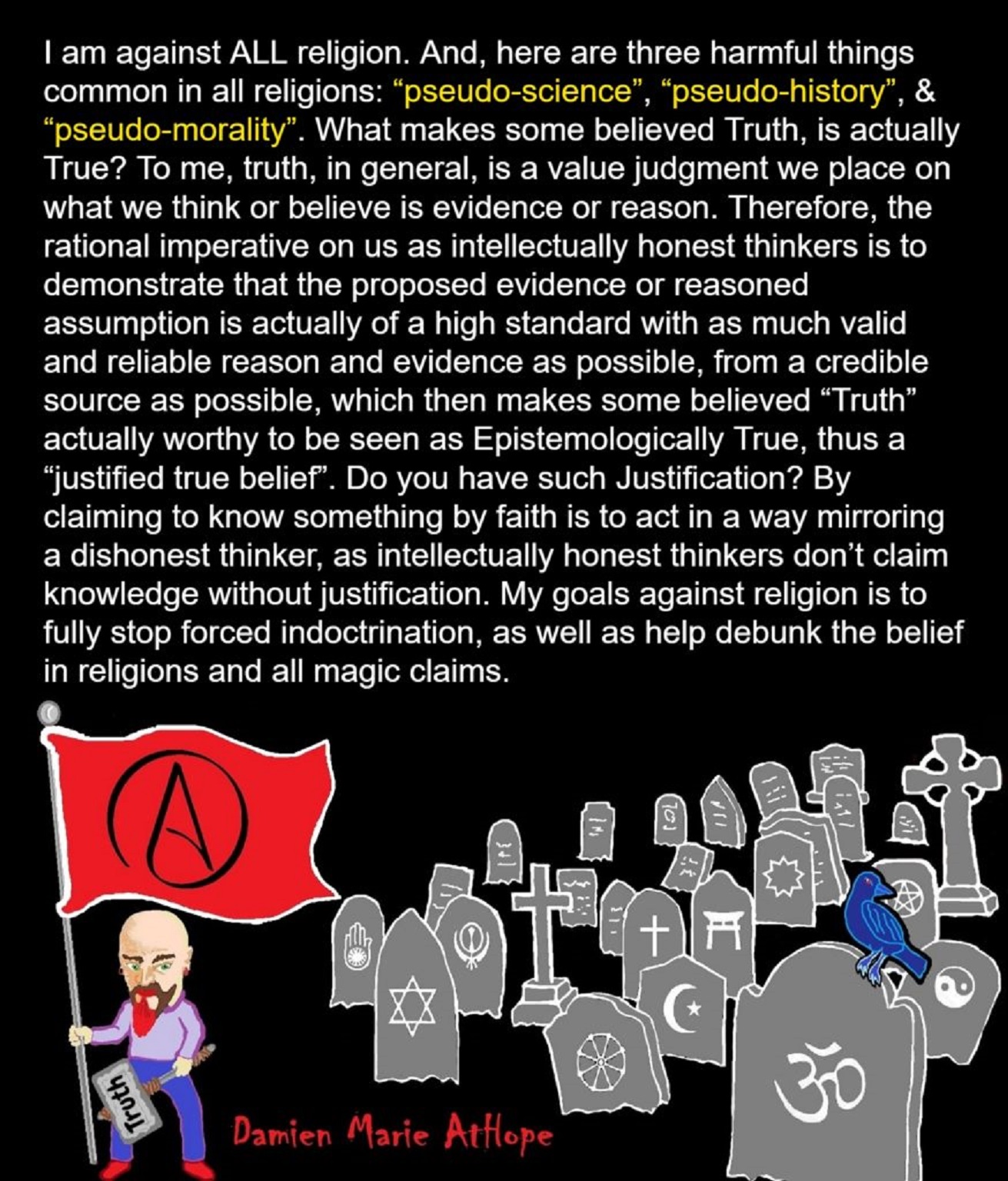

Damien Marie AtHope (Said as “At” “Hope”)/(Autodidact Polymath but not good at math):
Axiological Atheist, Anti-theist, Anti-religionist, Secular Humanist, Rationalist, Writer, Artist, Jeweler, Poet, “autodidact” Philosopher, schooled in Psychology, and “autodidact” Armchair Archaeology/Anthropology/Pre-Historian (Knowledgeable in the range of: 1 million to 5,000/4,000 years ago). I am an anarchist socialist politically. Reasons for or Types of Atheism
My Website, My Blog, & Short-writing or Quotes, My YouTube, Twitter: @AthopeMarie, and My Email: damien.marie.athope@gmail.com
